User Manual
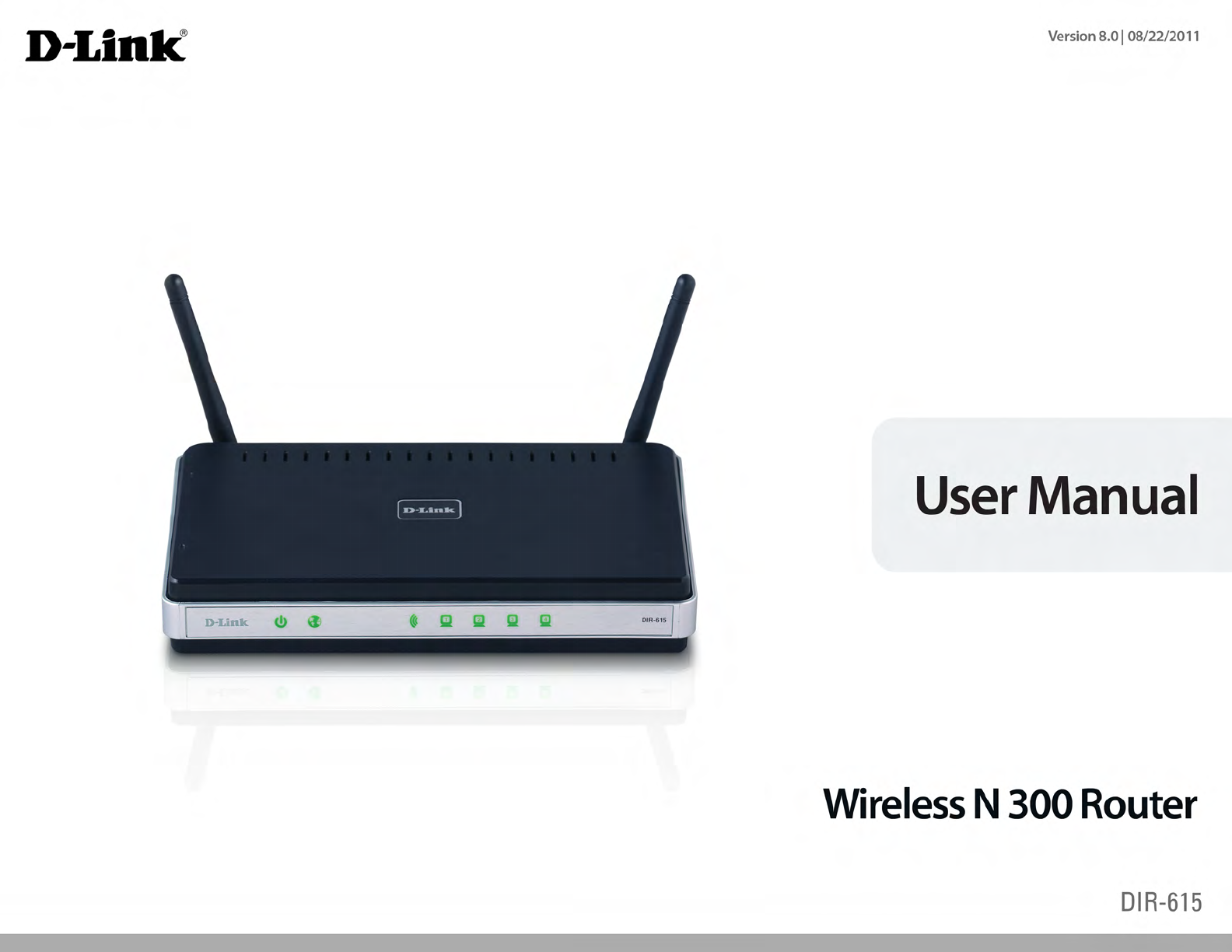

iD-Link DIR-615 User Manual
D-Link reserves the right to revise this publication and to make changes in the content hereof without obligation to notify any
person or organization of such revisions or changes.
Manual Revisions
Trademarks
D-Link and the D-Link logo are trademarks or registered trademarks of D-Link Corporation or its subsidiaries in the United
States or other countries. Microsoft Windows 2000, Microsoft Windows XP, Microsoft Windows Vista, and Microsoft Windows 7
are registered trademarks of the Microsoft Corporation. All other company or product names mentioned herein are trademarks
or registered trademarks of their respective companies.
Copyright © 2011 by D-Link Systems, Inc.
All rights reserved. This publication may not be reproduced, in whole or in part, without prior expressed written permission
from D-Link Systems, Inc.
Revision Date Description
5.2 December 22, 2009 • Updated for revision E1
5.3 March 10, 2010 • Updated for revision E3
• Added Language Pack
5.4 November 15, 2010 • Added Windows® 7 support
8.0 August 22, 2011 New Hardware revision I1
Preface

iiD-Link DIR-615 User Manual
Table of Contents
Preface ................................................................................. i
Manual Revisions ........................................................................... i
Trademarks ...................................................................................... i
Product Overview .............................................................. 1
Package Contents ......................................................................... 1
System Requirements .................................................................2
Features ............................................................................................ 3
Hardware Overview ..................................................................... 4
Connections ...........................................................................4
LEDs ........................................................................................... 5
Installation ......................................................................... 6
Before you Begin ........................................................................... 6
Wireless Installation Considerations ...................................... 7
Network Diagram ......................................................................... 8
Connect to Cable/DSL/Satellite Modem .............................. 9
Connect to Another Router ....................................................10
Getting Started ............................................................................11
Conguration ...................................................................12
Quick Setup Wizard ....................................................................12
Web-based Conguration Utility ..........................................18
Internet Connection Setup Wizard ...............................19
Manual Conguration .......................................................24
Dynamic (Cable) .............................................................24
PPPoE (DSL) ......................................................................26
PPTP ....................................................................................27
L2TP ....................................................................................28
Static IP Address .............................................................30
Wireless Settings .................................................................31
Manual Wireless Network Setup ..............................32
Network Settings ................................................................33
DHCP Server Settings ...................................................34
DHCP Reservation .........................................................35
Virtual Server ........................................................................36
Port Forwarding ..................................................................38
Application Rules ................................................................39
QoS Engine............................................................................40
Network Filters .....................................................................41
Access Control .....................................................................42
Access Control Wizard ..................................................42
Website Filters ......................................................................45
Inbound Filters.....................................................................46
Firewall Settings ..................................................................47
Routing ..................................................................................48
Advanced Wireless Settings ............................................49
Advanced Network Settings ...........................................50
UPnP ...................................................................................50
Internet Ping Block ........................................................50
Internet Port Speed .......................................................50
Multicast Streams ..........................................................50
Time Settings .......................................................................51
SysLog .....................................................................................52
E-mail Settings .....................................................................53
Table of Contents

iiiD-Link DIR-615 User Manual
Table of Contents
System Settings ...................................................................54
Firmware ................................................................................55
DDNS .......................................................................................56
System Check .......................................................................57
Schedules ..............................................................................58
Device Information ............................................................59
Log ...........................................................................................61
Statistics .................................................................................62
Internet Sessions .................................................................63
Routing Table .......................................................................65
Wireless ..................................................................................66
Support ..................................................................................67
Wireless Security .............................................................68
What is WPA? ................................................................................68
Wireless Network Setup Wizard ............................................69
Add Wireless Device with WPS Wizard ................................72
Congure WPA-Personal (PSK) ...............................................73
Congure WPA-Enterprise (RADIUS) ....................................74
Connect to a Wireless Network .............................................76
Using Windows® 7 ...............................................................76
Congure WPS ................................................................79
Using Windows Vista® .....................................................................................................83
Congure WPA/WPA2 ...................................................84
Connect Using WCN 2.0 ...................................................86
Using Windows® XP ............................................................87
Congure WPA-PSK .......................................................88
Troubleshooting ..............................................................90
Wireless Basics .................................................................94
What is Wireless? .........................................................................95
Tips ...................................................................................................97
Wireless Modes ............................................................................98
Networking Basics ...........................................................99
Check your IP address ...............................................................99
Statically Assign an IP address ............................................ 100
Technical Specications ................................................101
Contacting Technical Support ......................................102
GPL Code Statement......................................................103
Warranty .........................................................................105
Registration ...................................................................111

1D-Link DIR-615 User Manual
Section 1 - Product Overview
D-Link DIR-615 Wireless N Router
Power Adapter
Ethernet Cable
CD-ROM
Product Overview
Note: Using a power supply with a dierent voltage rating than the one included with the DIR-615 will cause damage and void the warranty for this product.
Package Contents

2D-Link DIR-615 User Manual
Section 1 - Product Overview
Network Requirements
• An Ethernet-based Cable or DSL modem
• IEEE 802.11n/g wireless clients
• 10/100 Ethernet
Web-based Conguration
Utility Requirements
Computer with the following:
• Windows®, Macintosh, or Linux-based operating system
• An installed Ethernet adapter
Browser Requirements:
• Internet Explorer 6 or higher
• Chrome 2.0 or higher
• Firefox 3.0 or higher
• Safari 3.0 or higher
Windows® Users: Make sure you have the latest version of Java
installed. Visit www.java.com to download the latest version.
CD Installation Wizard
Requirements
Computer with the following:
• Windows® XP (Service Pack 3), Vista® or Windows® 7
• An installed Ethernet adapter
• CD-ROM drive
System Requirements

3D-Link DIR-615 User Manual
Section 1 - Product Overview
• Faster Wireless Networking - The DIR-615 provides up to 300Mbps* wireless connection with other 802.11n wireless clients. This
capability allows users to participate in real-time activities online, such as video streaming, online gaming, and real-time audio.
• Compatible with 802.11g Devices - The DIR-615 is still fully compatible with the IEEE 802.11g standard, so it can connect with
existing 802.11g PCI, USB and Cardbus adapters.
• Advanced Firewall Features - The Web-based user interface displays a number of advanced network management features
including:
• Content Filtering - Easily applied content ltering based on MAC Address, URL, and/or Domain Name.
• Filter Scheduling - These lters can be scheduled to be active on certain days or for a duration of hours or minutes.
• Secure Multiple/Concurrent Sessions - The DIR-615 can pass through VPN sessions. It supports multiple and
concurrent IPSec and PPTP sessions, so users behind the DIR-615 can securely access corporate networks.
• User-friendly Setup Wizard - Through its easy-to-use Web-based user interface, the DIR-615 lets you control what information is
accessible to those on the wireless network, whether from the Internet or from your company’s server. Congure your router to
your specic settings within minutes.
* Maximum wireless signal rate derived from IEEE Standard 802.11g and 802.11n specications. Actual data throughput will vary. Network conditions and environmental factors,
including volume of network trac, building materials and construction, and network overhead, lower actual data throughput rate. Environmental conditions will adversely
aect wireless signal range.
Features
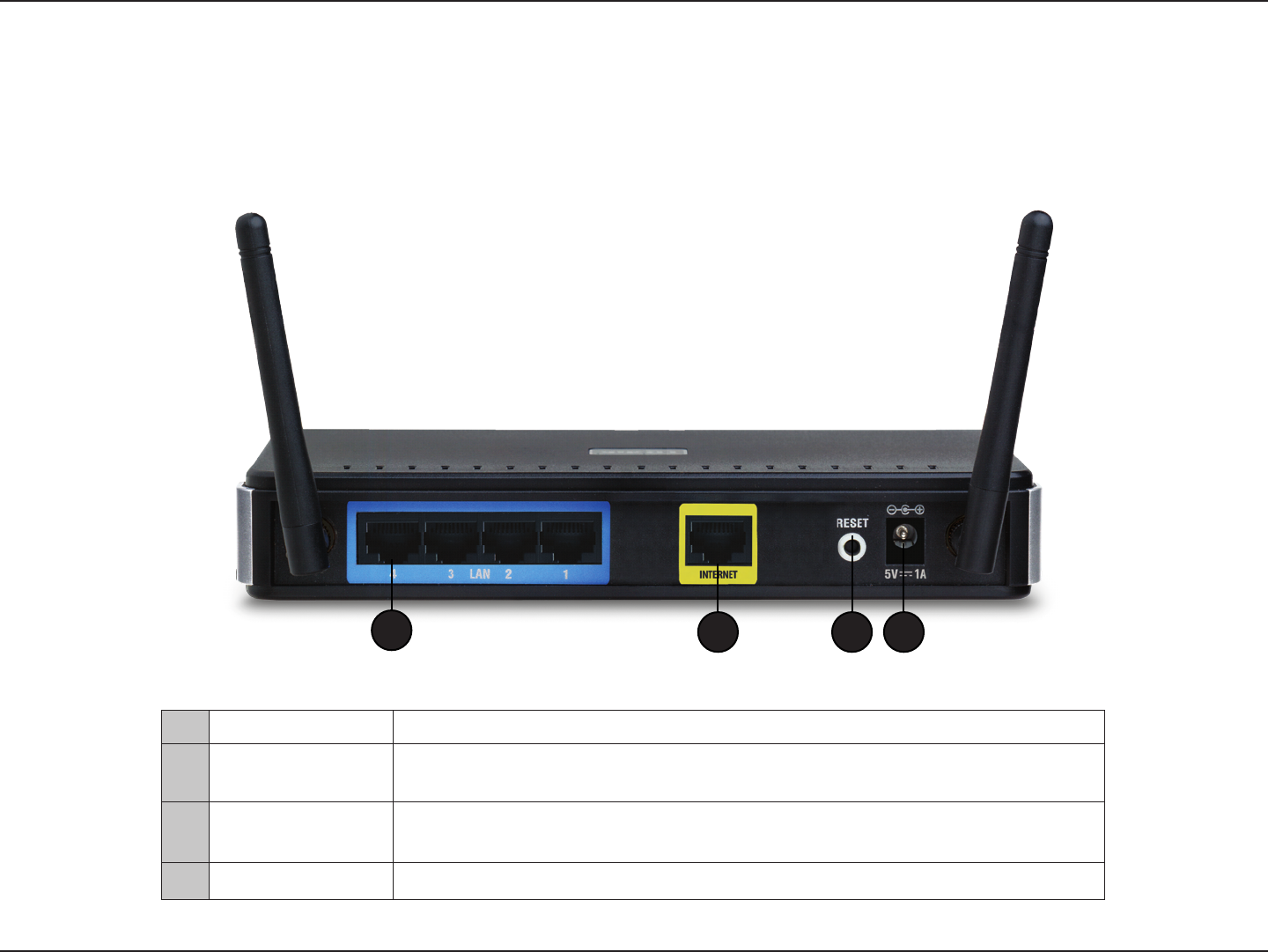
4D-Link DIR-615 User Manual
Section 1 - Product Overview
Hardware Overview
Connections
1LAN Ports (1-4) Connect Ethernet devices such as computers, switches, and hubs.
2Internet Port The auto MDI/MDIX Internet port is the connection for the Ethernet cable to the
cable or DSL modem.
3Reset Button Pressing the Reset button restores the router to its original factory default
settings.
4Power Receptor Receptor for the supplied power adapter.
12 3 4
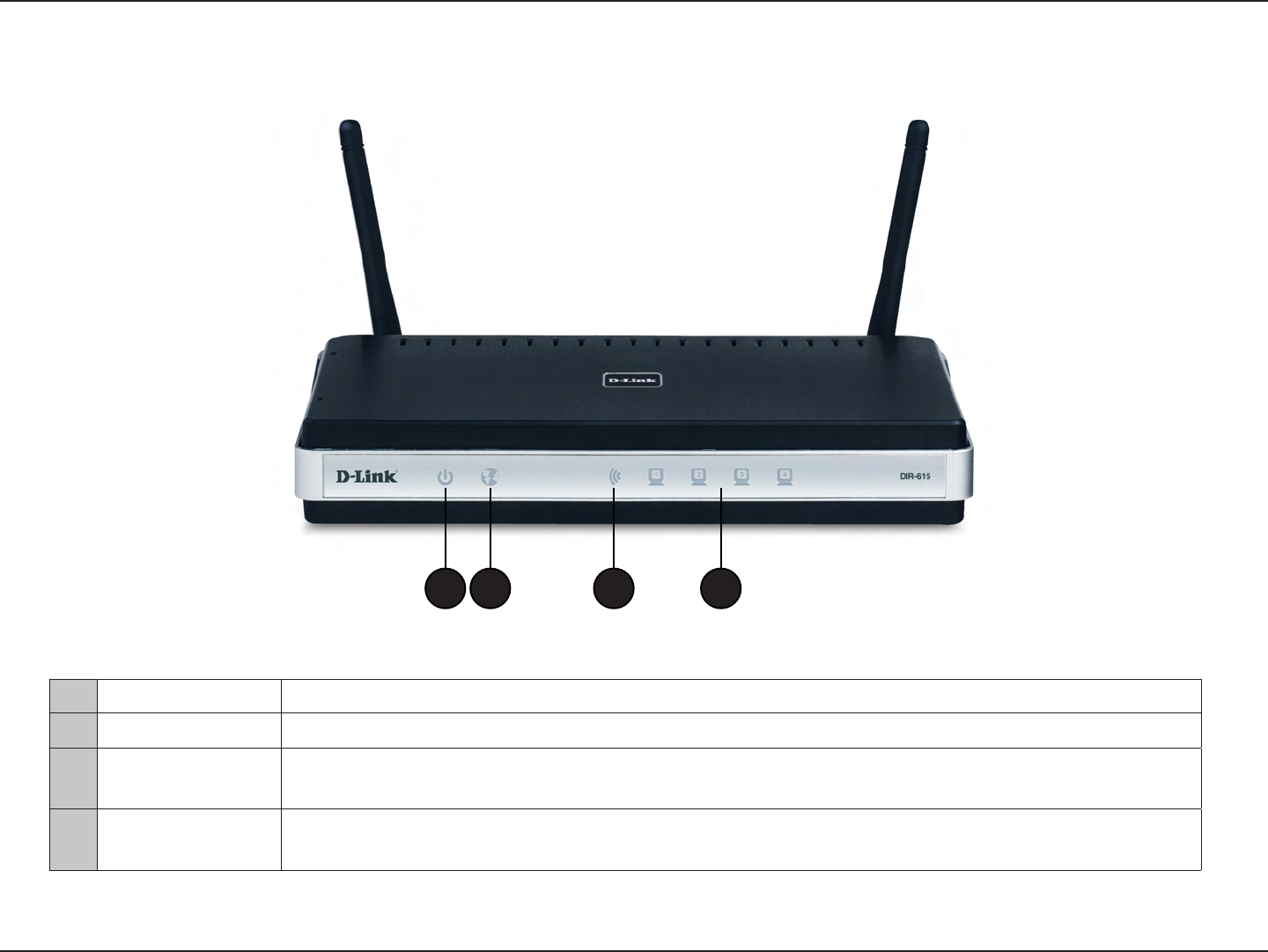
5D-Link DIR-615 User Manual
Section 1 - Product Overview
Hardware Overview
LEDs
1Power LED A solid light indicates a proper connection to the power supply.
2Internet LED A solid light indicates connection on the Internet port. This LED blinks during data transmission.
3WAN LED A solid light indicates that the wireless segment is ready. This LED blinks during wireless data
transmission.
4LAN LEDs (1-4) A solid light indicates a connection to an Ethernet-enabled computer on ports 1-4. This LED blinks during
data transmission.
1 2 3 4

6D-Link DIR-615 User Manual
Section 2 - Installation
Before you Begin
This section will walk you through the installation process. Placement of the router is very important. Do not place the router in an enclosed area
such as a closet, cabinet, or in the attic or garage.
• Please congure the router with the computer that was last connected directly to your modem.
• You can only use the Ethernet port on your modem. If you were using the USB connection before using the router, then you must
turn o your modem, disconnect the USB cable and connect an Ethernet cable to the Internet port on the router, and then turn
the modem back on. In some cases, you may need to call your ISP to change connection types (USB to Ethernet).
• If you have DSL and are connecting via PPPoE, make sure you disable or uninstall any PPPoE software such as WinPoet, Broadjump,
or Enternet 300 from your computer or you will not be able to connect to the Internet.
• When running the Setup Wizard from the D-Link CD, make sure the computer you are running the CD from is connected to the
Internet and online or the wizard will not work. If you have disconnected any hardware, re-connect your computer back to the
modem and make sure you are online.
Installation

7D-Link DIR-615 User Manual
Section 2 - Installation
Wireless Installation Considerations
The D-Link wireless router lets you access your network using a wireless connection from virtually anywhere within the operating range of your
wireless network. Keep in mind that the number, thickness and location of walls, ceilings, or other objects that the wireless signals must pass
through, may limit the range. Typical ranges vary depending on the types of materials and background RF (radio frequency) noise in your home or
business. The key to maximizing wireless range is to follow these basic guidelines:
1. Keep the number of walls and ceilings between the D-Link router and other network devices to a minimum - each wall or ceiling
can reduce your adapter’s range from 3-90 feet (1-30 meters.) Position your devices so that the number of walls or ceilings is
minimized.
2. Be aware of the direct line between network devices. A wall that is 1.5 feet thick (.5 meters), at a 45-degree angle appears to be
almost 3 feet (1 meter) thick. At a 2-degree angle it looks over 42 feet (14 meters) thick! Position devices so that the signal will
travel straight through a wall or ceiling (instead of at an angle) for better reception.
3. Building Materials make a dierence. A solid metal door or aluminum studs may have a negative eect on range. Try to position
access points, wireless routers, and computers so that the signal passes through drywall or open doorways. Materials and objects
such as glass, steel, metal, walls with insulation, water (sh tanks), mirrors, le cabinets, brick, and concrete will degrade your
wireless signal.
4. Keep your product away (at least 3-6 feet or 1-2 meters) from electrical devices or appliances that generate RF noise.
5. If you are using 2.4GHz cordless phones or X-10 (wireless products such as ceiling fans, lights, and home security systems), your
wireless connection may degrade dramatically or drop completely. Make sure your 2.4GHz phone base is as far away from your
wireless devices as possible. The base transmits a signal even if the phone in not in use.
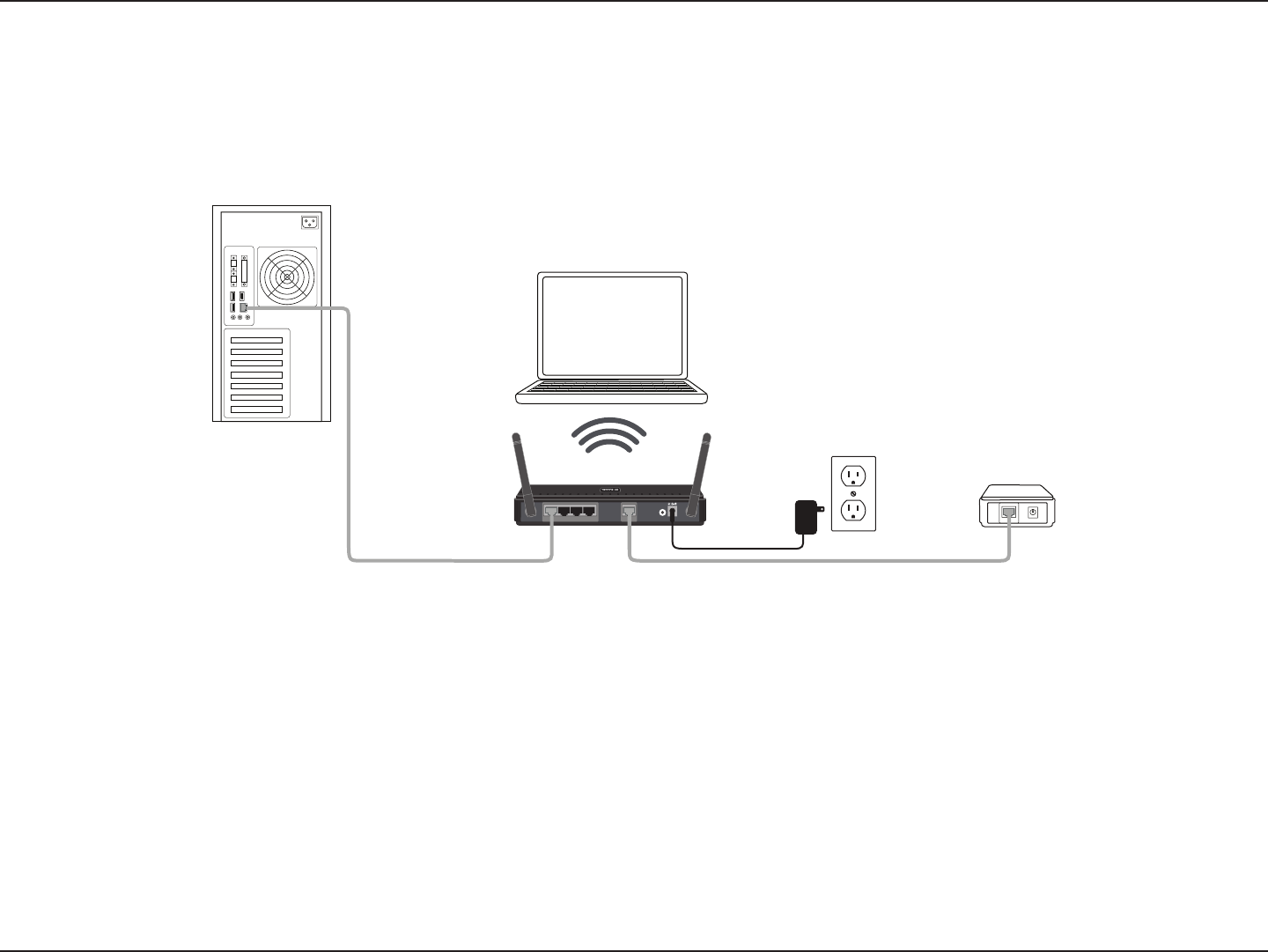
8D-Link DIR-615 User Manual
Section 2 - Installation
Network Diagram
5V ---3A
1 2 LAN 3 4 INTERNET RESET INTERNET
Desktop
Laptop
DIR-615 Modem

9D-Link DIR-615 User Manual
Section 2 - Installation
If you are connecting the router to a cable/DSL/satellite modem, please follow the steps below:
1. Place the router in an open and central location. Do not plug the power adapter into the router.
2. Turn the power o on your modem. If there is no on/o switch, then unplug the modem’s power adapter. Shut down your computer.
3. Unplug the Ethernet cable (that connects your computer to your modem) from your computer and place it into the Internet port on the router.
4. Plug an Ethernet cable into one of the four LAN ports on the router. Plug the other end into the Ethernet port on your computer.
5. Turn on or plug in your modem. Wait for the modem to boot (about 30 seconds).
6. Plug the power adapter to the router and connect to an outlet or power strip. Wait about 30 seconds for the router to boot.
7. Turn on your computer.
8. Verify the link lights on the router. The power light, Internet light, and the LAN light (the port that your computer is plugged into) should be lit.
If not, make sure your computer, modem, and router are powered on and verify the cable connections are correct.
9. Skip to page 12 to congure your router.
Connect to Cable/DSL/Satellite Modem

10D-Link DIR-615 User Manual
Section 2 - Installation
If you are connecting the D-Link router to another router to use as a wireless access point and/or switch, you will have to do the following before
connecting the router to your network:
• Disable UPnP™
• Disable DHCP
• Change the LAN IP address to an available address on your network. The LAN ports on the router cannot accept a DHCP address
from your other router.
To connect to another router, please follow the steps below:
1. Plug the power into the router. Connect one of your computers to the router (LAN port) using an Ethernet cable. Make sure your IP address on
the computer is 192.168.0.xxx (where xxx is between 2 and 254). Please see the Networking Basics section for more information. If you need
to change the settings, write down your existing settings before making any changes. In most cases, your computer should be set to receive an
IP address automatically in which case you will not have to do anything to your computer.
2. Open a web browser and enter http://192.168.0.1 and press Enter. When the login window appears, set the user name to Admin and leave
the password box empty. Click Log In to continue.
3. Click on Advanced and then click Advanced Network. Uncheck the Enable UPnP checkbox. Click Save Settings to continue.
4. Click Setup and then click Network Settings. Uncheck the Enable DHCP Server server checkbox. Click Save Settings to continue.
5. Under Router Settings, enter an available IP address and the subnet mask of your network. Click Save Settings to save your settings. Use this
new IP address to access the conguration utility of the router in the future. Close the browser and change your computer’s IP settings back to
the original values as in Step 1.
6. Disconnect the Ethernet cable from the router and reconnect your computer to your network.
7. Connect an Ethernet cable in one of the LAN ports of the router and connect it to your other router. Do not plug anything into the Internet port
of the D-Link router.
8. You may now use the other 3 LAN ports to connect other Ethernet devices and computers. To congure your wireless network, open a web
browser and enter the IP address you assigned to the router. Refer to the Conguration and Wireless Security sections for more information
on setting up your wireless network.
Connect to Another Router
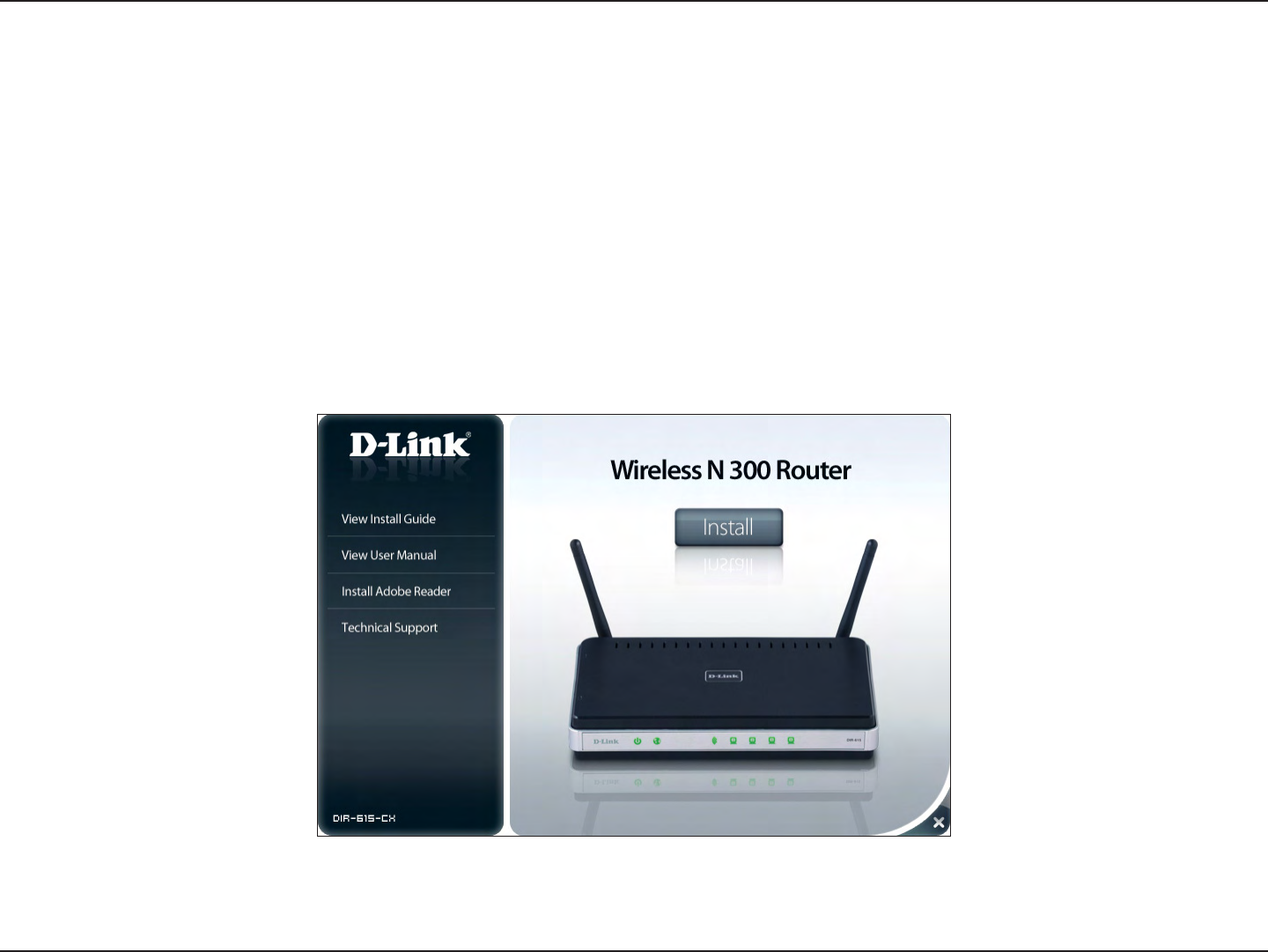
11D-Link DIR-615 User Manual
Section 2 - Installation
Note: It is recommended to write down the login password on the provided CD holder.
The DIR-615 includes a Quick Router Setup Wizard CD. Follow the simple steps below to run the Setup Wizard to guide you quickly through the
installation process. You may manually congure your router without the wizard. Refer to the next page to manually setup your router.
Insert the Quick Router Setup Wizard CD in the CD-ROM drive. The step-by-step instructions that follow are shown in Windows® XP or Vista®.
The steps and screens are similar for the other Windows® operating systems.
If the CD autorun function does not automatically start on your computer, go to Start > Run. In the run box type “D:\DIR615.exe” (where
D: represents the drive letter of your CD-ROM drive).
When the autorun screen appears, click Install and follow the on-screen instructions.
Getting Started
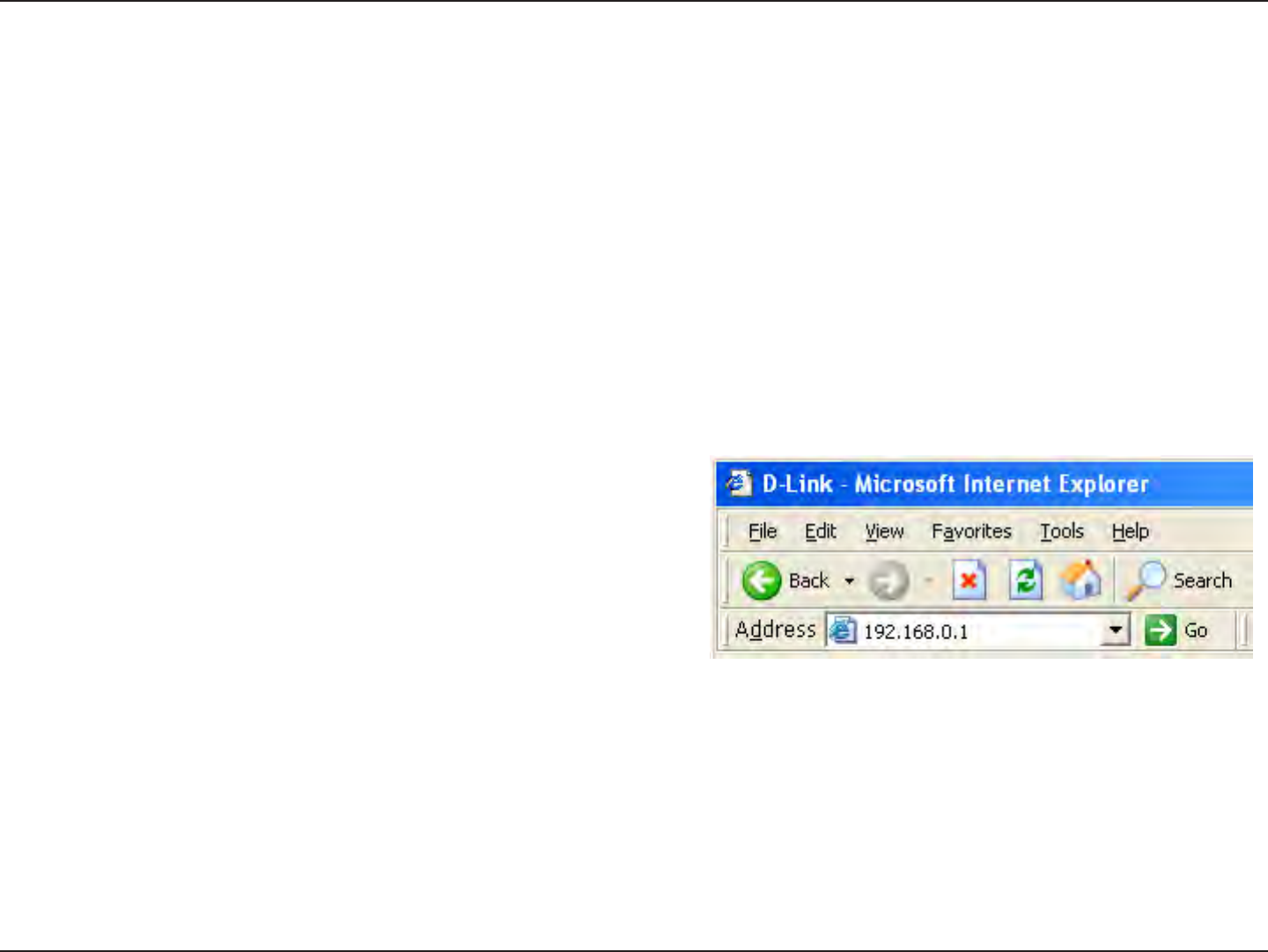
12D-Link DIR-615 User Manual
Section 3 - Conguration
Conguration
This section will show you how to congure your new D-Link wireless router using the web-based conguration utility.
Quick Setup Wizard
To access the conguration utility, open a web-browser such as Internet
Explorer and enter the IP address of the router (192.168.0.1).
You may also connect using the NetBIOS name in the address bar
(http://dlinkrouter).
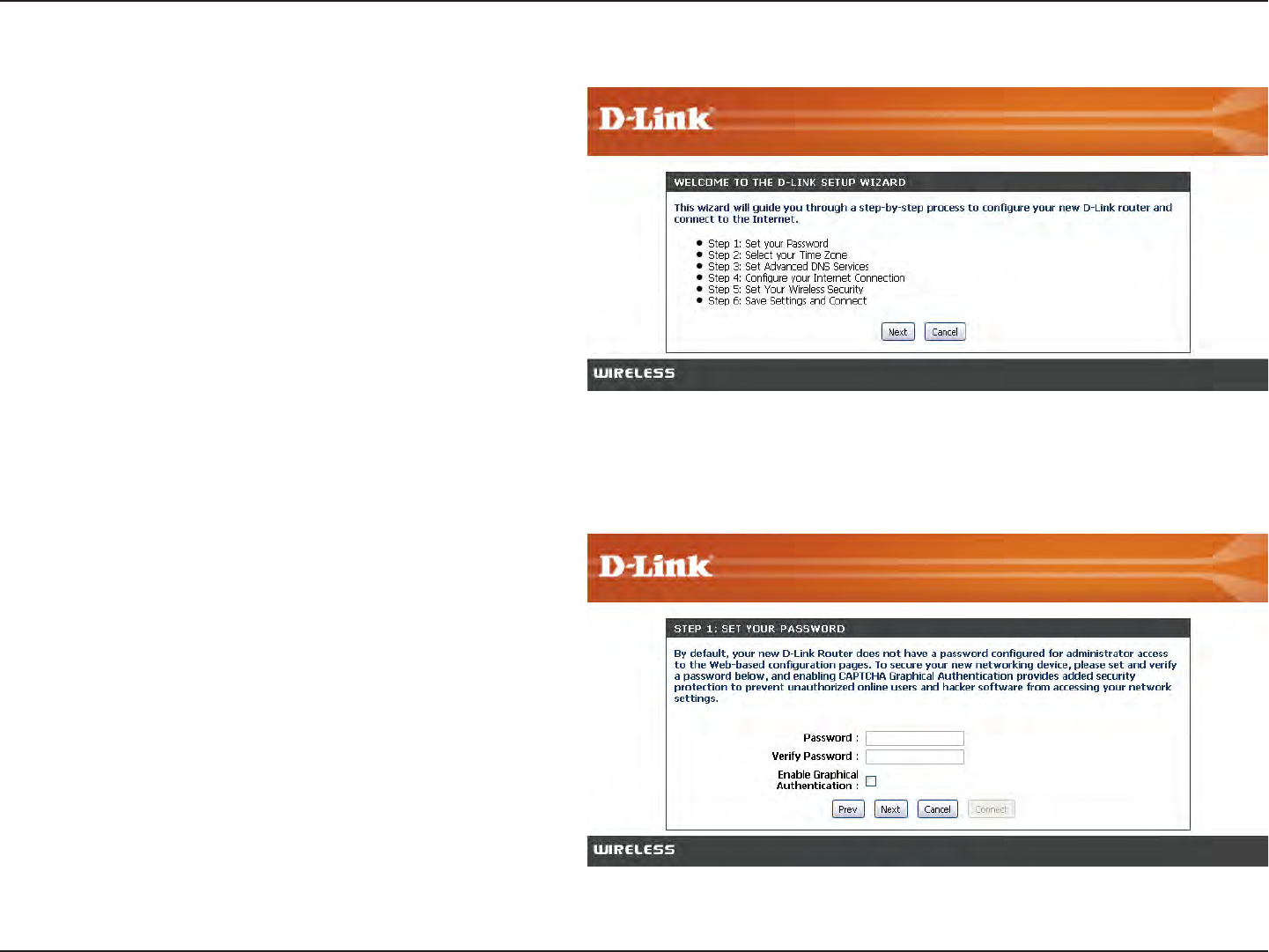
13D-Link DIR-615 User Manual
Section 3 - Conguration
This wizard is designed to guide you through a step-by step
process to congure your new D-Link router and connect to the
Internet.
Click Next to continue.
In order to secure your new networking device, please enter a
password and click Next.
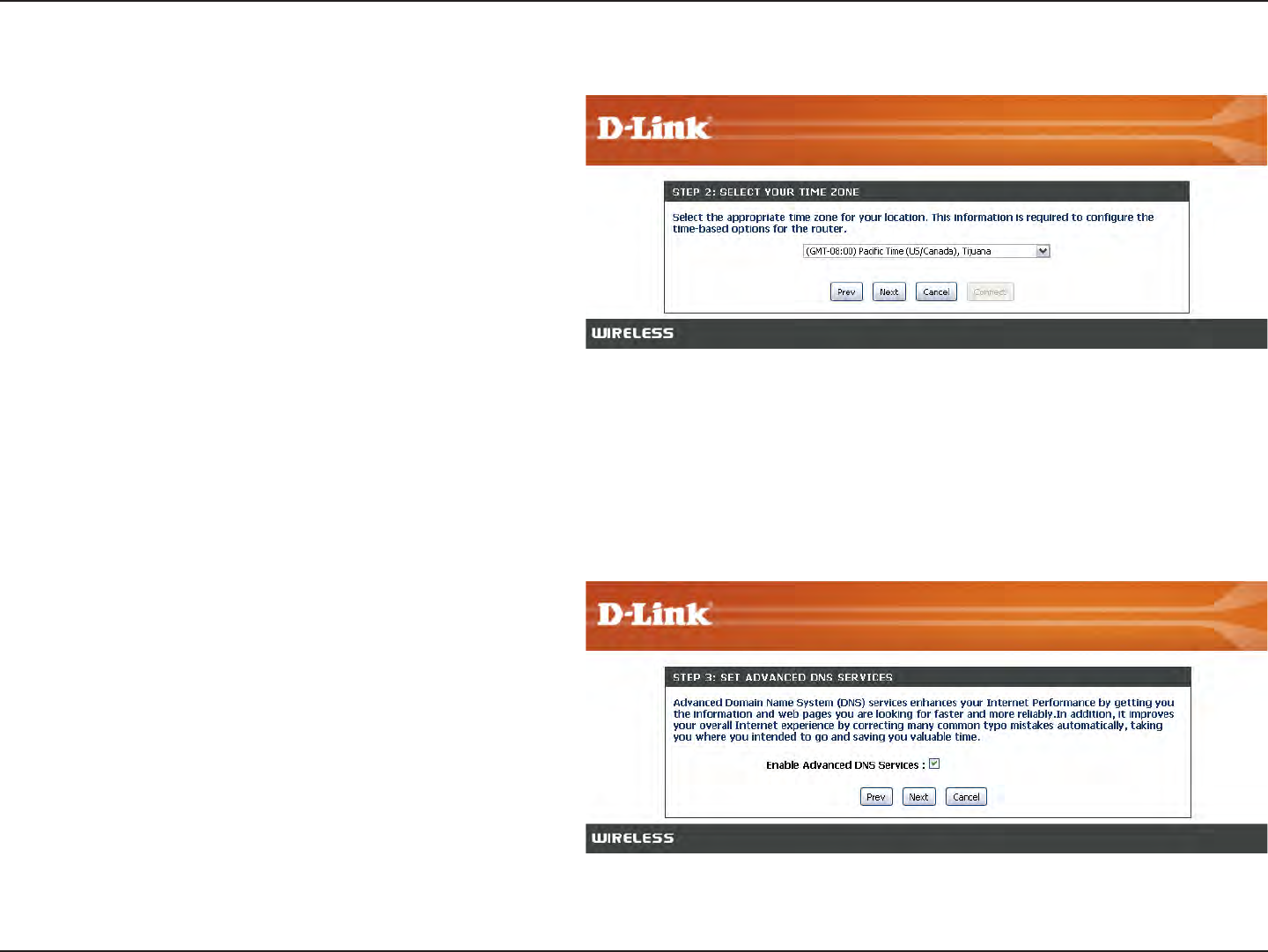
14D-Link DIR-615 User Manual
Section 3 - Conguration
Select Enable Advanced DNS Services to allow this
function to improve your overall Internet experience.
Click Next to continue.
Select your time zone from the drop-down menu and click Next
to continue.
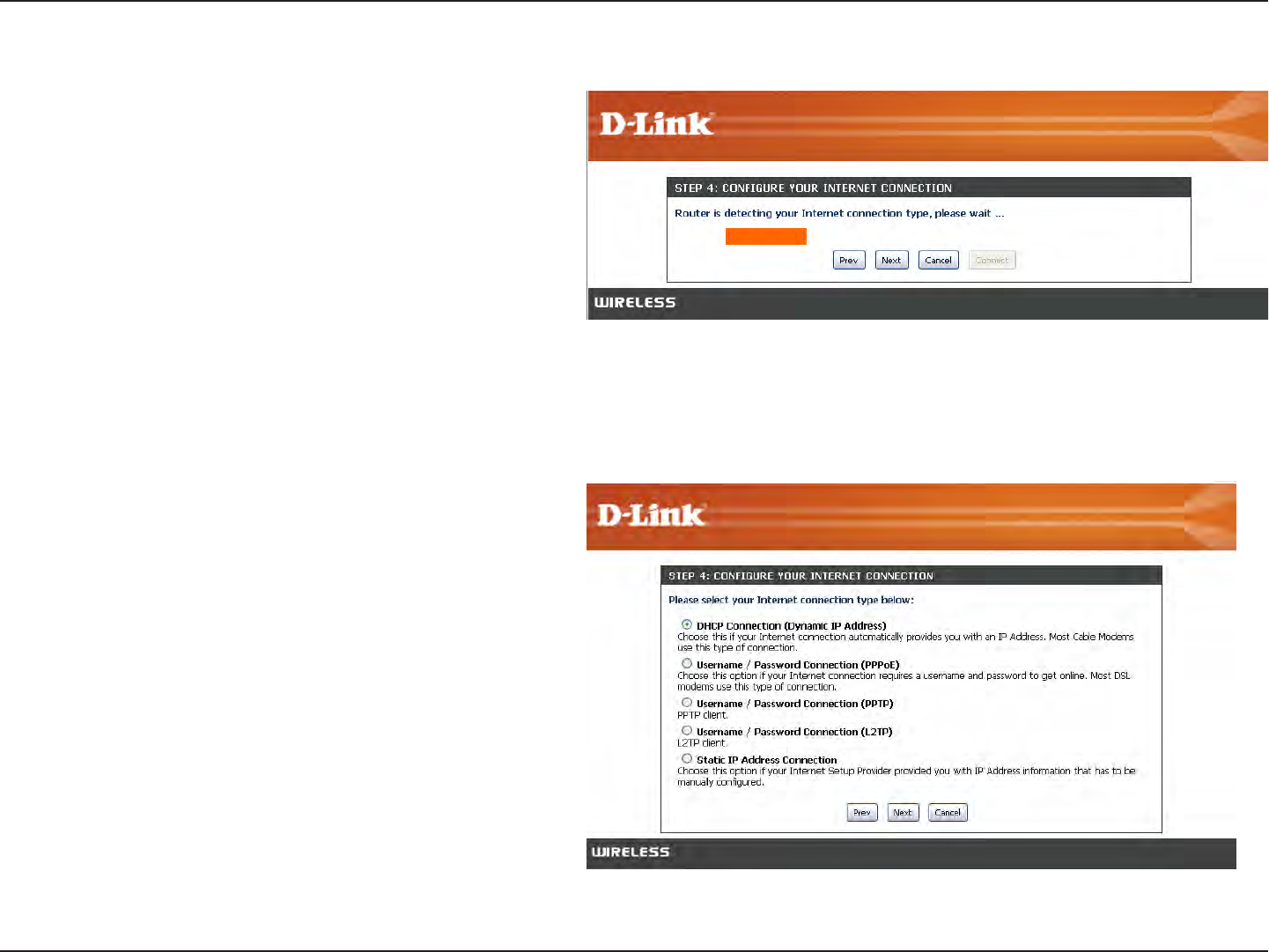
15D-Link DIR-615 User Manual
Section 3 - Conguration
Select your Internet connection type and click Next to continue.
Please wait while your router detects your internet connection type.
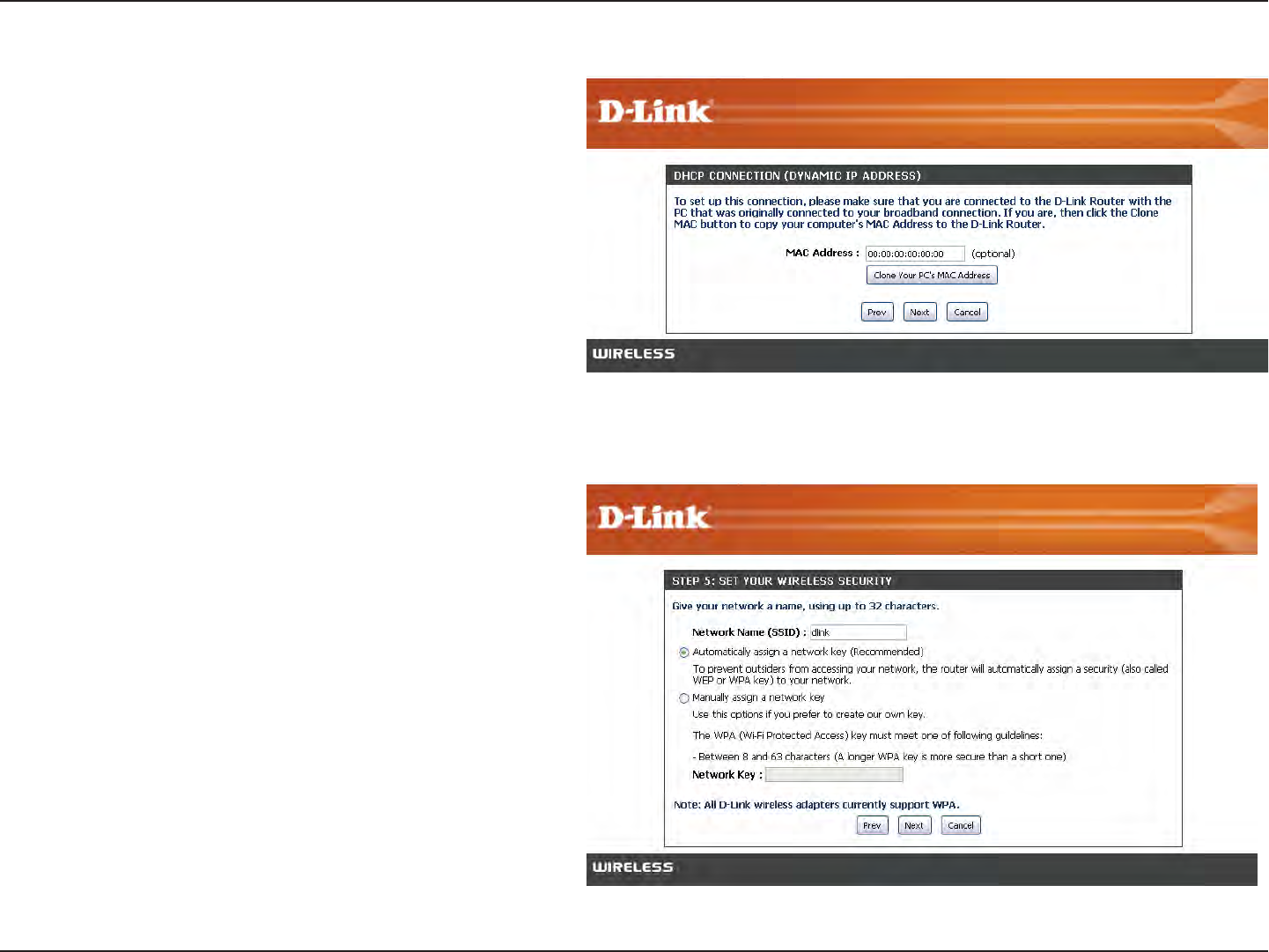
16D-Link DIR-615 User Manual
Section 3 - Conguration
Please give your network a name using up to 32 characters.
It is highly recommended that you have a security key for your
network. If you would like the router to automatically assign a
security key, choose Automatically assign a network key or you
may choose Manually assign a network key and you may enter
your own Network key.
Click Next to continue.
If you selected DHCP Connection, make suer that you are
connected to the D-Link router with the PC that was originally
connected to your broadband connection. Then, click the Clone
MAC button to copy your computer’s MAC address. Click Next to
continue.
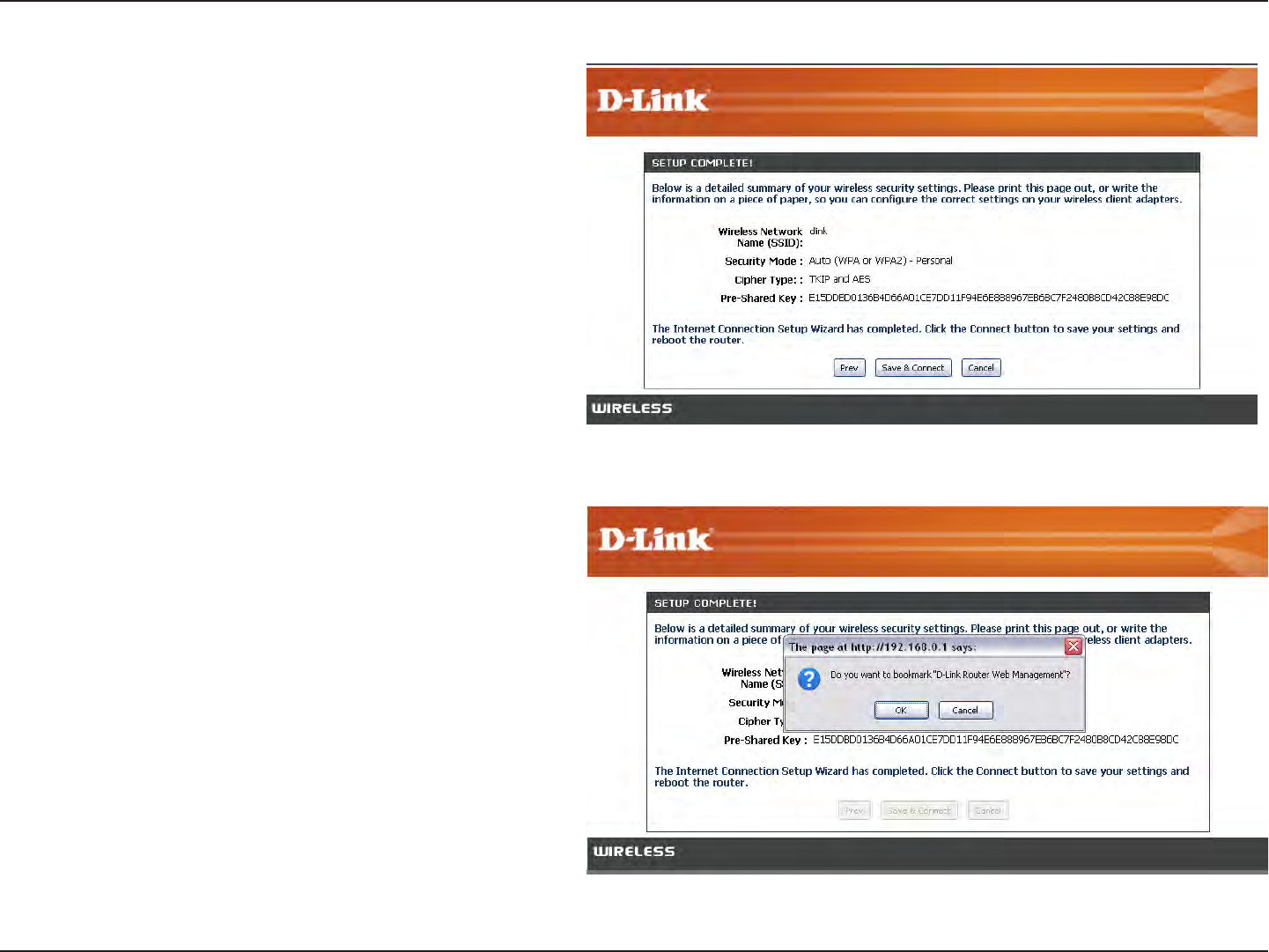
17D-Link DIR-615 User Manual
Section 3 - Conguration
Before your router reboots, you will be asked if you want to
bookmark ‘D-Link Router Web Management,” click Ok to nish.
Once this screen appears, your setup is complete. Click Save &
Connect to reboot the router.
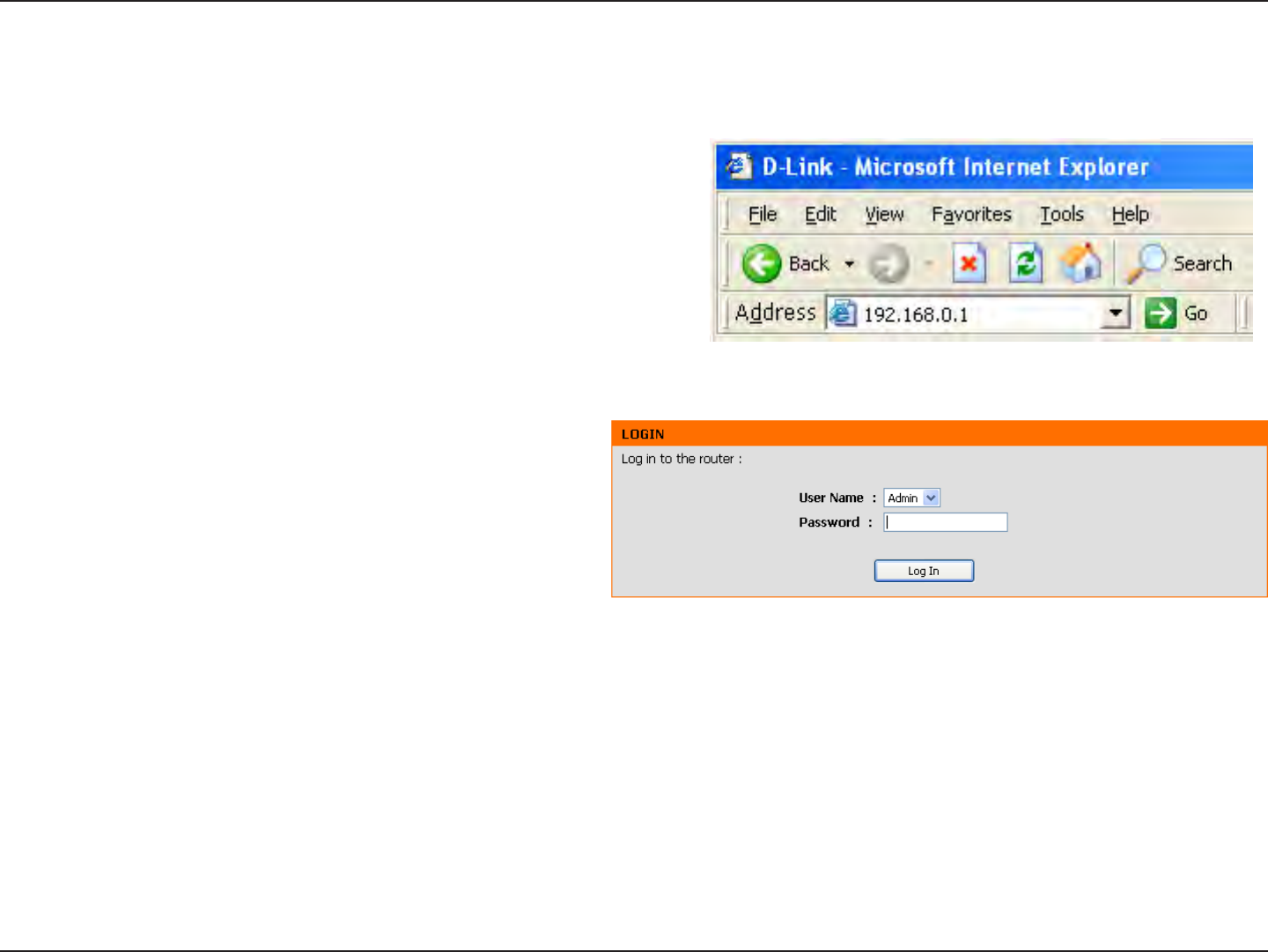
18D-Link DIR-615 User Manual
Section 3 - Conguration
Web-based Conguration Utility
To access the conguration utility, open a web-browser such as
Internet Explorer and enter the IP address of the router (192.168.0.1).
Select Admin from the drop-down menu and then enter your
password. Leave the password blank by default.
If you get a Page Cannot be Displayed error, please refer to the
Troubleshooting section for assistance.
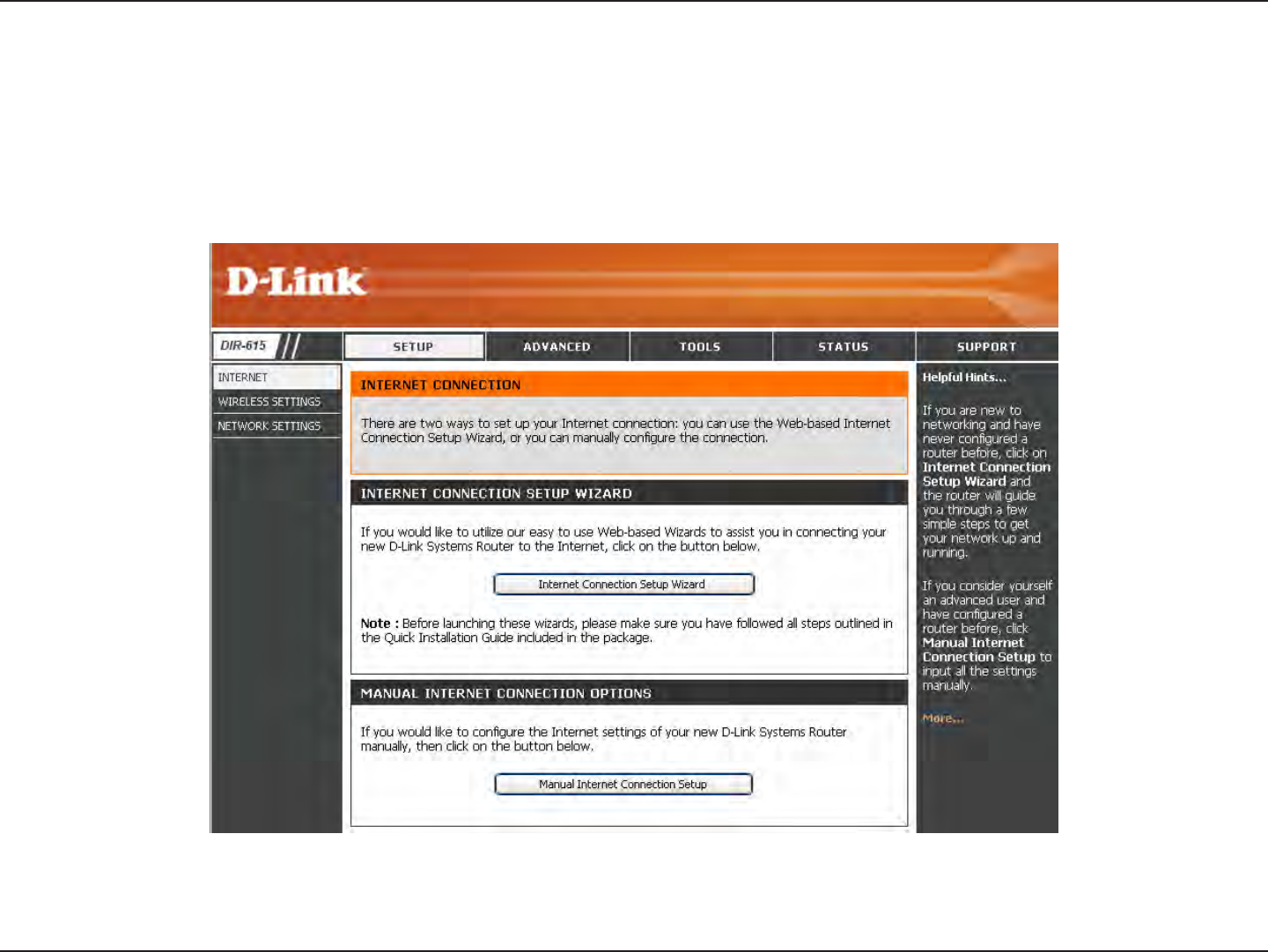
19D-Link DIR-615 User Manual
Section 3 - Conguration
Internet Connection Setup Wizard
Once logged into the web interface of the router, the Setup > Internet page will appear. Click the Internet Connection Setup Wizard button to
quickly congure your router using the setup wizard.
If you want to enter your settings without running the wizard, click Manual Internet Conguration Wizard.
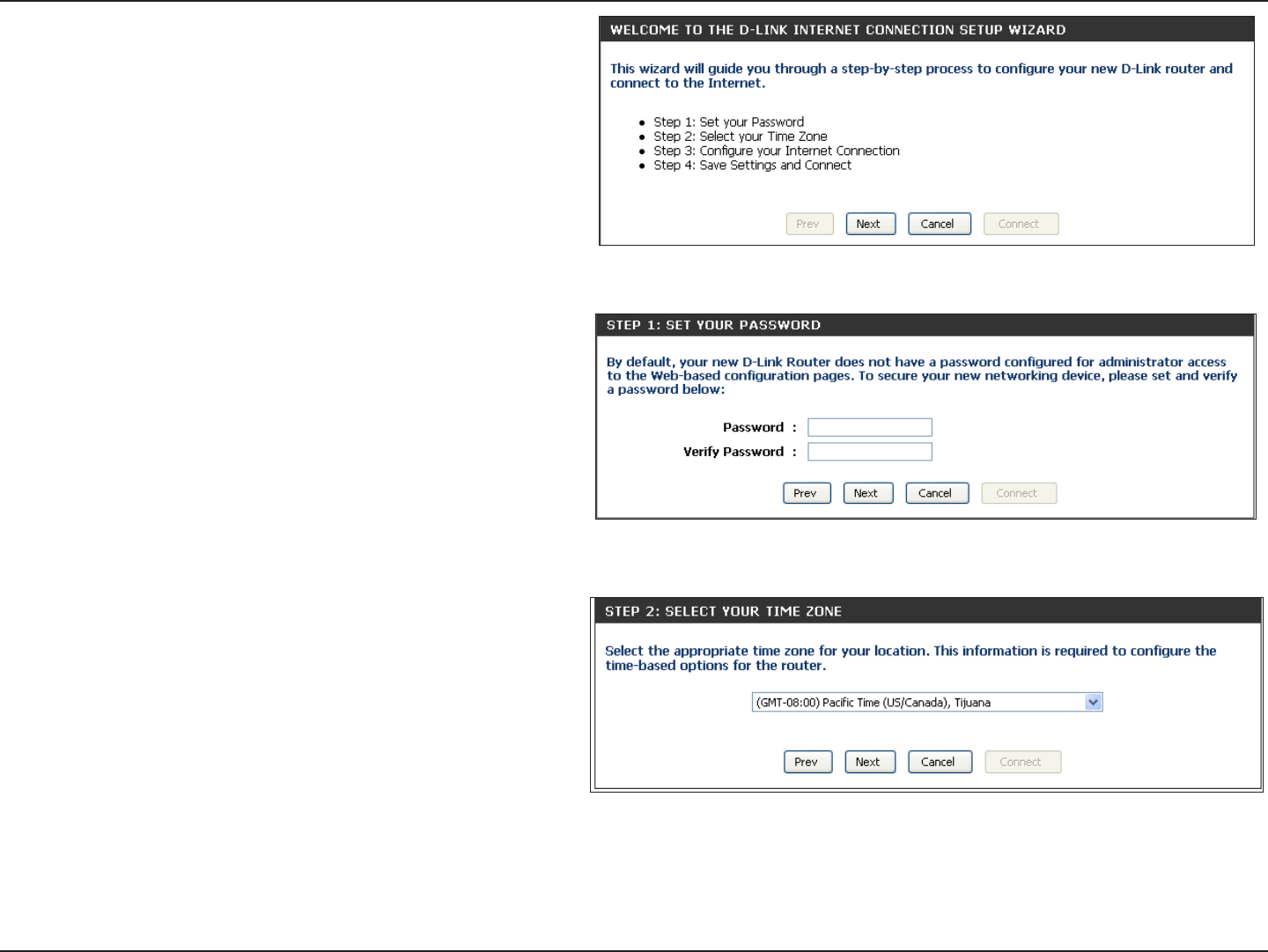
20D-Link DIR-615 User Manual
Section 3 - Conguration
Click Next to continue.
Create a new password and then click Next to continue.
Select your time zone from the drop-down menu and then
click Next to continue.
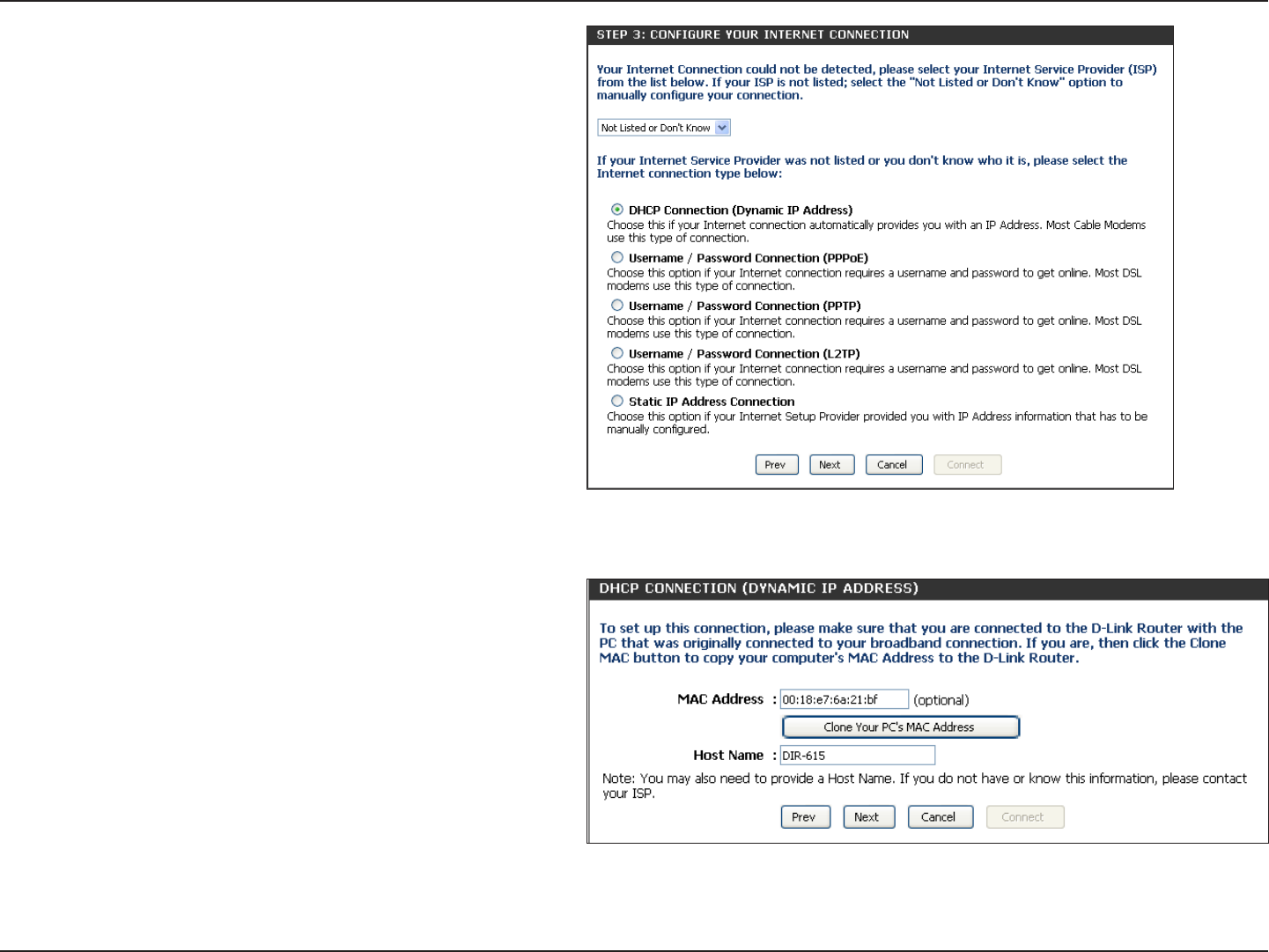
21D-Link DIR-615 User Manual
Section 3 - Conguration
If you selected Dynamic, you may need to enter the MAC address
of the computer that was last connected directly to your modem.
If you are currently using that computer, click Clone Your PC’s
MAC Address and then click Next to continue.
The Host Name is optional but may be required by some ISPs.
The default host name is the device name of the Router and may
be changed.
Select the type of Internet connection you use and then click
Next to continue.
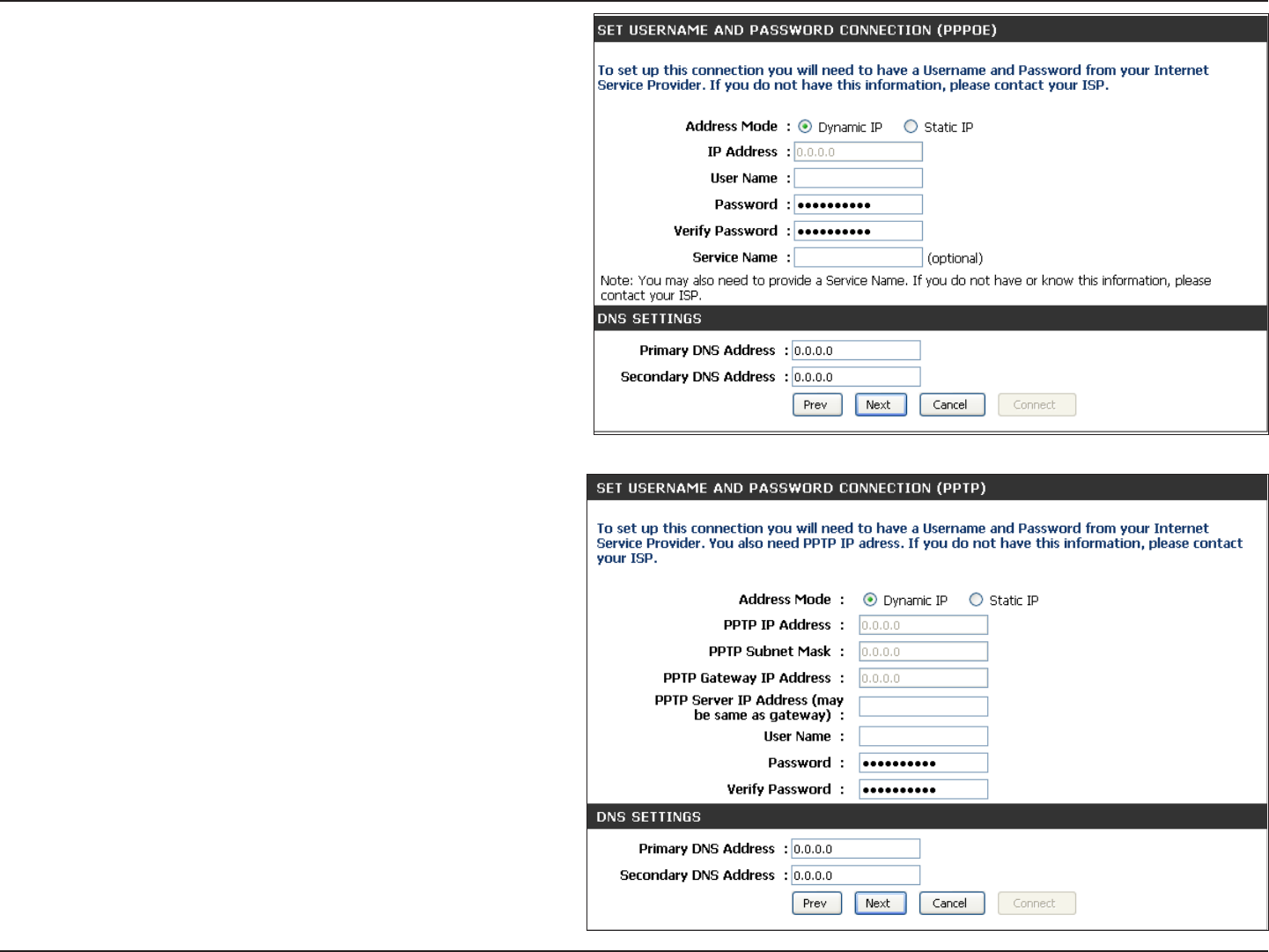
22D-Link DIR-615 User Manual
Section 3 - Conguration
If you selected PPTP, enter your PPTP username and password.
Click Next to continue.
If you selected PPPoE, enter your PPPoE username and password.
Click Next to continue.
Select Static if your ISP assigned you the IP address, subnet mask,
gateway, and DNS server addresses.
Note: Make sure to remove your PPPoE software from your computer.
The software is no longer needed and will not work through a router.
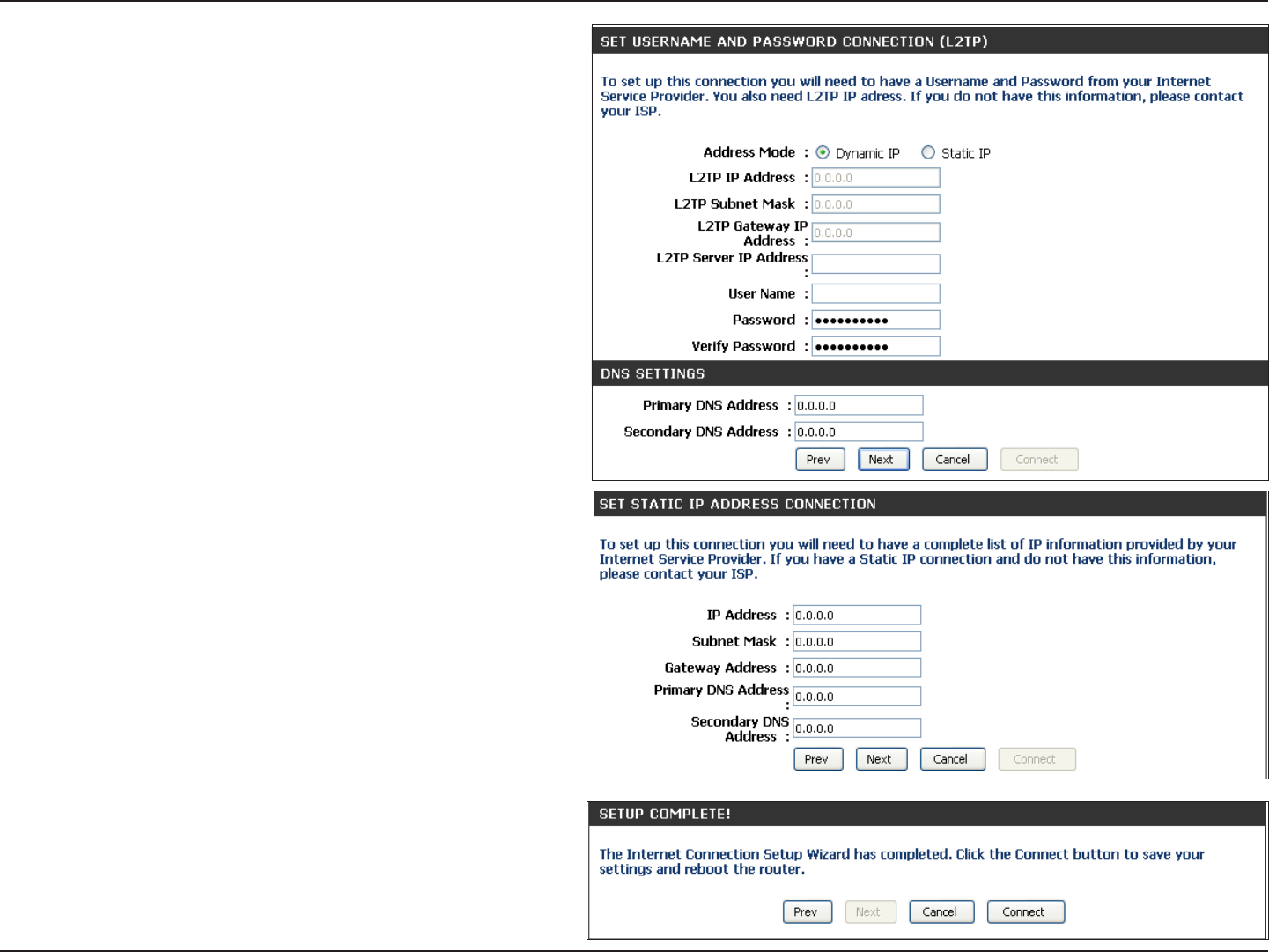
23D-Link DIR-615 User Manual
Section 3 - Conguration
If you selected L2TP, enter your L2TP username and password.
Click Next to continue.
If you selected Static, enter your network settings supplied by
your Internet provider. Click Next to continue.
The Setup is now complete. Click the Connect to save your
settings. Please allow 1-2 minutes to connect.
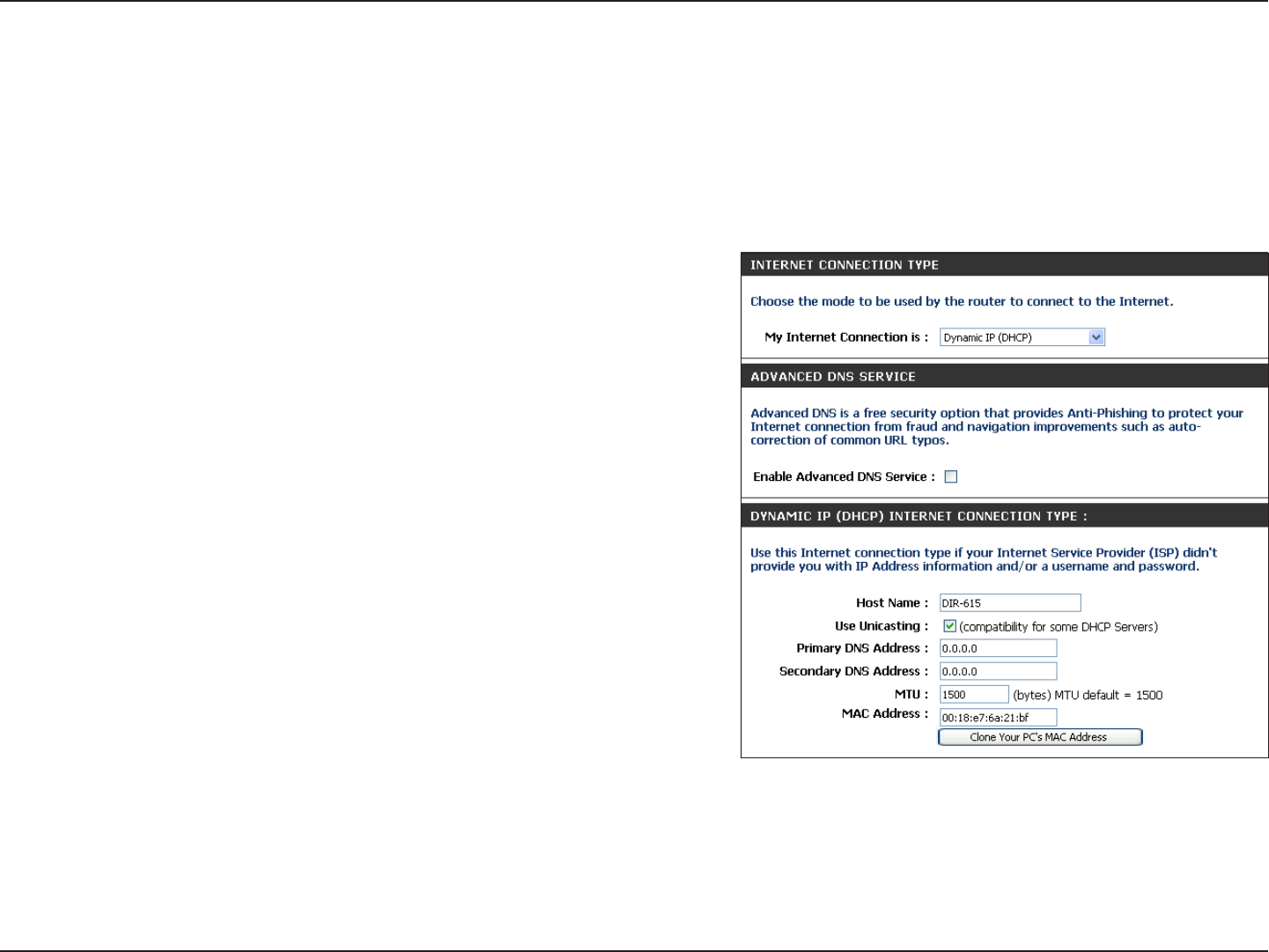
24D-Link DIR-615 User Manual
Section 3 - Conguration
If you opt to set up your Internet connection manually, you will be redirected to a WAN page that allows you to select your
Internet type and enter the correct conguration parameters. Click the Save Settings button when you have congured the
connection.
Manual Conguration
Dynamic (Cable)
Select Dynamic IP (DHCP) to obtain IP Address information automatically
from your ISP. Select this option if your ISP does not give you any IP numbers
to use. This option is commonly used for cable modem services such as
Comcast and Cox.
Advanced Domain Name System (DNS) services enhances your Internet
performance by getting you the information and web pages you are looking
for faster and more reliably. In addition, it improves your overall Internet
experience by correcting many common typo mistakes automatically, taking
you where you intended to go and saving you valuable time.
Disclaimer: D-Link makes no warranty as to the availability, reliability,
functionality and operation of the Advanced DNS service or its features.
The Host Name is optional but may be required by some ISPs. Leave blank
if you are not sure.
Check the box if you are having problems obtaining an IP address from
your ISP.
Enter the Primary and secondary DNS server IP addresses assigned by your
ISP. These addresses are usually obtained automatically from your ISP. Leave
at 0.0.0.0 if you did not specically receive these from your ISP.
My Internet
Connection:
Enable Advanced
DNS Service:
Host Name:
Use Unicasting:
Primary/Secondary
DNS Server:

25D-Link DIR-615 User Manual
Section 3 - Conguration
MAC Address:
MTU: Maximum Transmission Unit - you may need to change the MTU for optimal performance with your specic ISP. 1500 is the default MTU.
The default MAC Address is set to the Internet port’s physical interface MAC address on the Broadband Router. It is not recommended that you change the
default MAC address unless required by your ISP. You can use the Clone Your PC’s MAC Address button to replace the Internet port’s MAC address with the
MAC address of your Ethernet card.
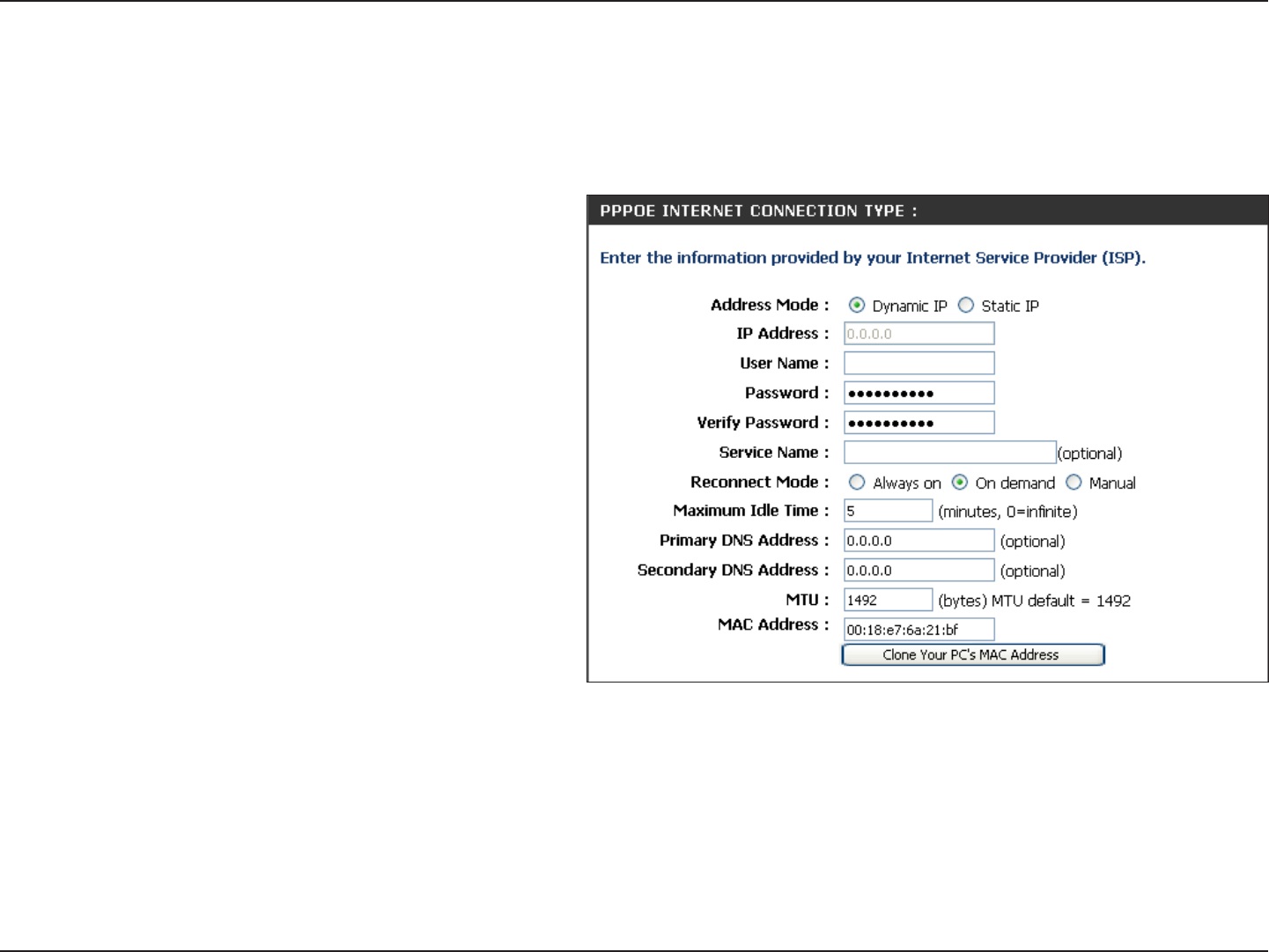
26D-Link DIR-615 User Manual
Section 3 - Conguration
Select PPPoE (Username/Password) from the drop-down
menu.
Select Static if your ISP assigned you the IP address, subnet
mask, gateway, and DNS server addresses. In most cases,
select Dynamic.
Enter the IP address (Static PPPoE only).
Enter your PPPoE user name.
Enter your PPPoE password and then retype the password
in the next box.
Enter the ISP Service Name (optional).
Select either Always-on, On-Demand, or Manual.
Enter a maximum idle time during which the Internet
connection is maintained during inactivity. To disable this
feature, enable Auto-reconnect.
Enter the Primary and Secondary DNS Server Addresses (Static PPPoE only).
Maximum Transmission Unit - you may need to change the MTU for optimal performance with your specic ISP. 1492 is the default MTU.
The default MAC Address is set to the Internet port’s physical interface MAC address on the Broadband Router. It is not recommended that you change the
default MAC address unless required by your ISP. You can use the Clone Your PC’s MAC Address button to replace the Internet port’s MAC address with the
MAC address of your Ethernet card.
My Internet
Connection:
Address Mode:
IP Address:
User Name:
Password:
Service Name:
Reconnection
Mode:
Maximum Idle
Time:
DNS Addresses:
MTU:
MAC Address:
PPPoE (DSL)
Choose PPPoE (Point to Point Protocol over Ethernet) if your ISP uses a PPPoE connection. Your ISP will provide you with a username and password.
This option is typically used for DSL services. Make sure to remove your PPPoE software from your computer. The software is no longer needed and
will not work through a router.
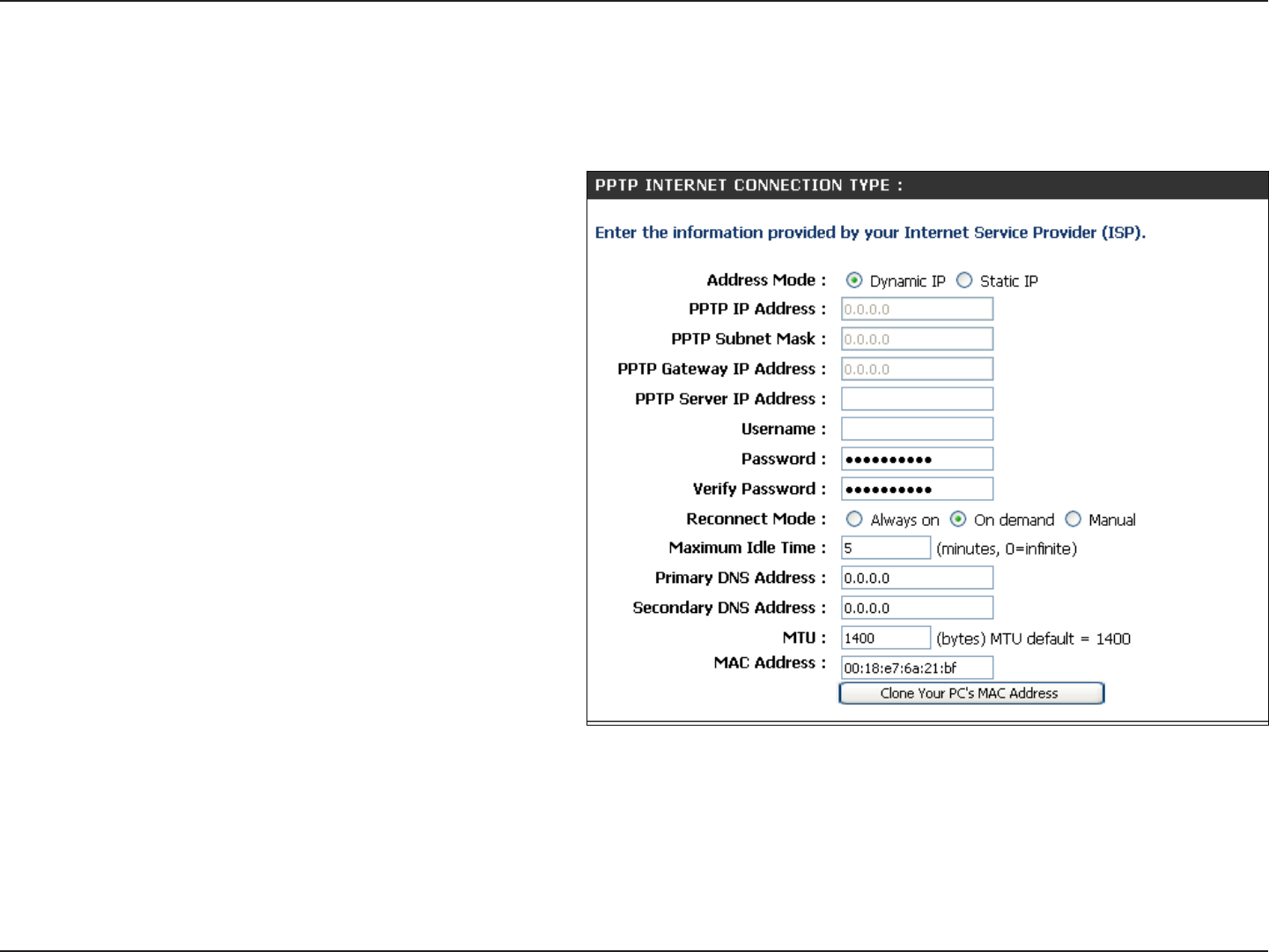
27D-Link DIR-615 User Manual
Section 3 - Conguration
Select Static if your ISP assigned you the IP address, subnet
mask, gateway, and DNS server addresses. In most cases,
select Dynamic.
Enter the IP address (Static PPTP only).
Enter the Primary and Secondary DNS Server Addresses (Static
PPTP only).
Enter the Gateway IP Address provided by your ISP.
Enter the Server IP provided by your ISP (optional).
Enter your PPTP username.
Enter your PPTP password and then retype the password in
the next box.
Select either Always-on, On-Demand, or Manual.
Enter a maximum idle time during which the Internet
connection is maintained during inactivity. To disable this
feature, enable Auto-reconnect.
The DNS server information will be supplied by your ISP (Internet Service Provider.)
Maximum Transmission Unit - you may need to change the MTU for optimal performance with your specic ISP. 1400 is the default MTU.
The default MAC Address is set to the Internet port’s physical interface MAC address on the Broadband Router. It is not recommended that you change the
default MAC address unless required by your ISP. You can use the Clone Your PC’s MAC Address button to replace the Internet port’s MAC address with the
MAC address of your Ethernet card.
Address Mode:
PPTP IP
Address:
PPTP Subnet
Mask:
PPTP Gateway:
PPTP Server
IP:
PPTP
Choose PPTP (Point-to-Point-Tunneling Protocol ) if your ISP uses a PPTP connection. Your ISP will provide you with a username and password. This
option is typically used for DSL services.
Username:
Password:
Reconnect
Mode:
Maximum Idle
Time:
DNS Servers:
MTU:
MAC Address:
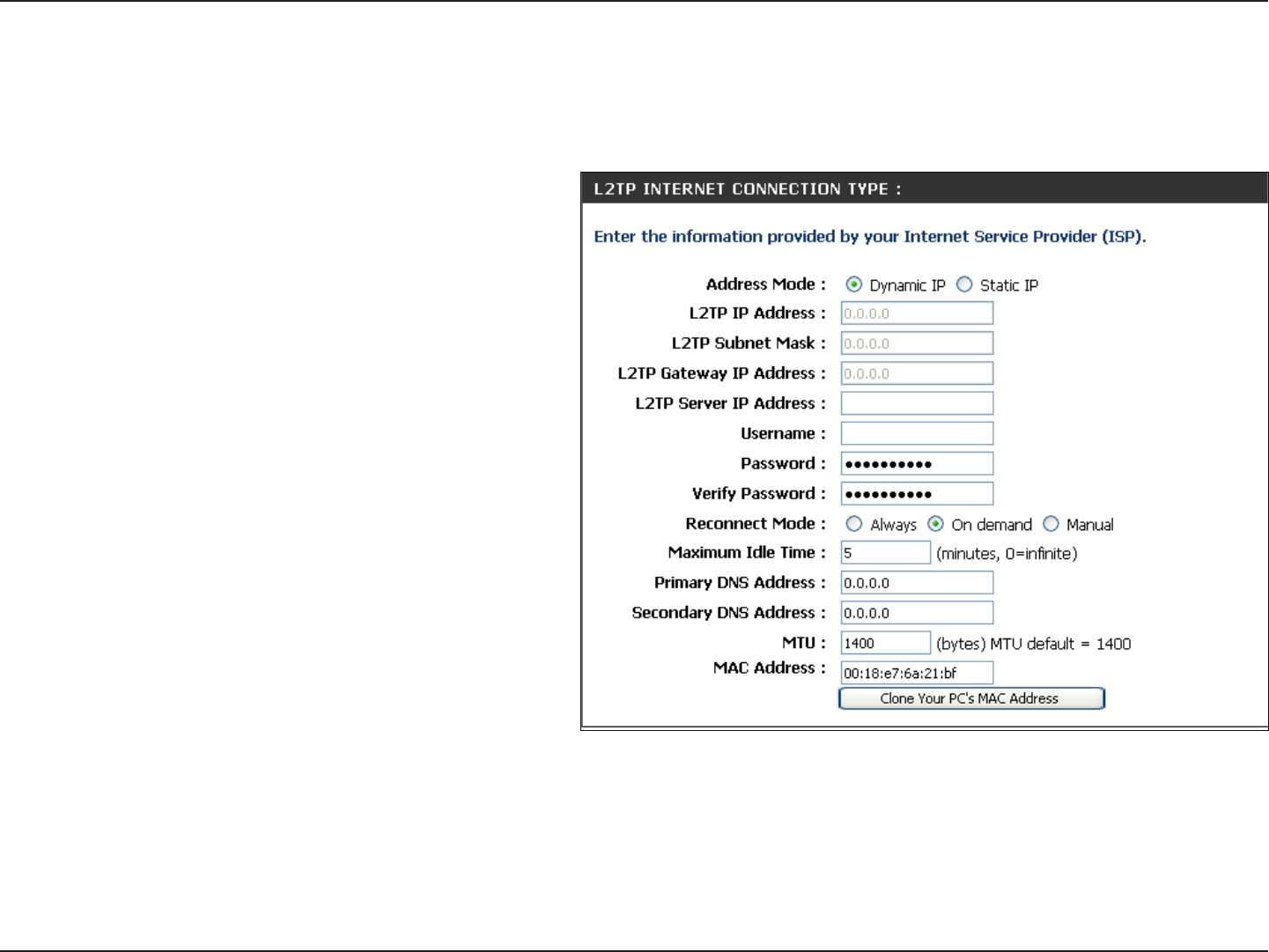
28D-Link DIR-615 User Manual
Section 3 - Conguration
Select Static if your ISP assigned you the IP address,
subnet mask, gateway, and DNS server addresses. In most
cases, select Dynamic.
Enter the L2TP IP address supplied by your ISP (Static only).
Enter the Subnet Mask supplied by your ISP (Static only).
Enter the Gateway IP Address provided by your ISP.
Enter the Server IP provided by your ISP (optional).
Enter your L2TP username.
Enter your L2TP password and then retype the password
in the next box.
Select either Always-on, On-Demand, or Manual.
Enter a maximum idle time during which the Internet
connection is maintained during inactivity. To disable this
feature, enable Auto-reconnect.
Enter the Primary and Secondary DNS Server Addresses (Static L2TP only).
Address Mode:
L2TP IP Address:
L2TP Subnet
Mask:
L2TP Gateway:
L2TP Server IP:
Username:
Password:
Reconnect Mode:
Maximum Idle
Time:
DNS Servers:
L2TP
Choose L2TP (Layer 2 Tunneling Protocol) if your ISP uses a L2TP connection. Your ISP will provide you with a username and password. This option
is typically used for DSL services.

29D-Link DIR-615 User Manual
Section 3 - Conguration
MTU:
Clone MAC
Address:
Maximum Transmission Unit - you may need to change the MTU for optimal performance with your specic ISP. 1400 is the default MTU.
The default MAC Address is set to the Internet port’s physical interface MAC address on the Broadband Router. It is not recommended that you change the
default MAC address unless required by your ISP. You can use the Clone Your PC’s MAC Address button to replace the Internet port’s MAC address with the
MAC address of your Ethernet card.
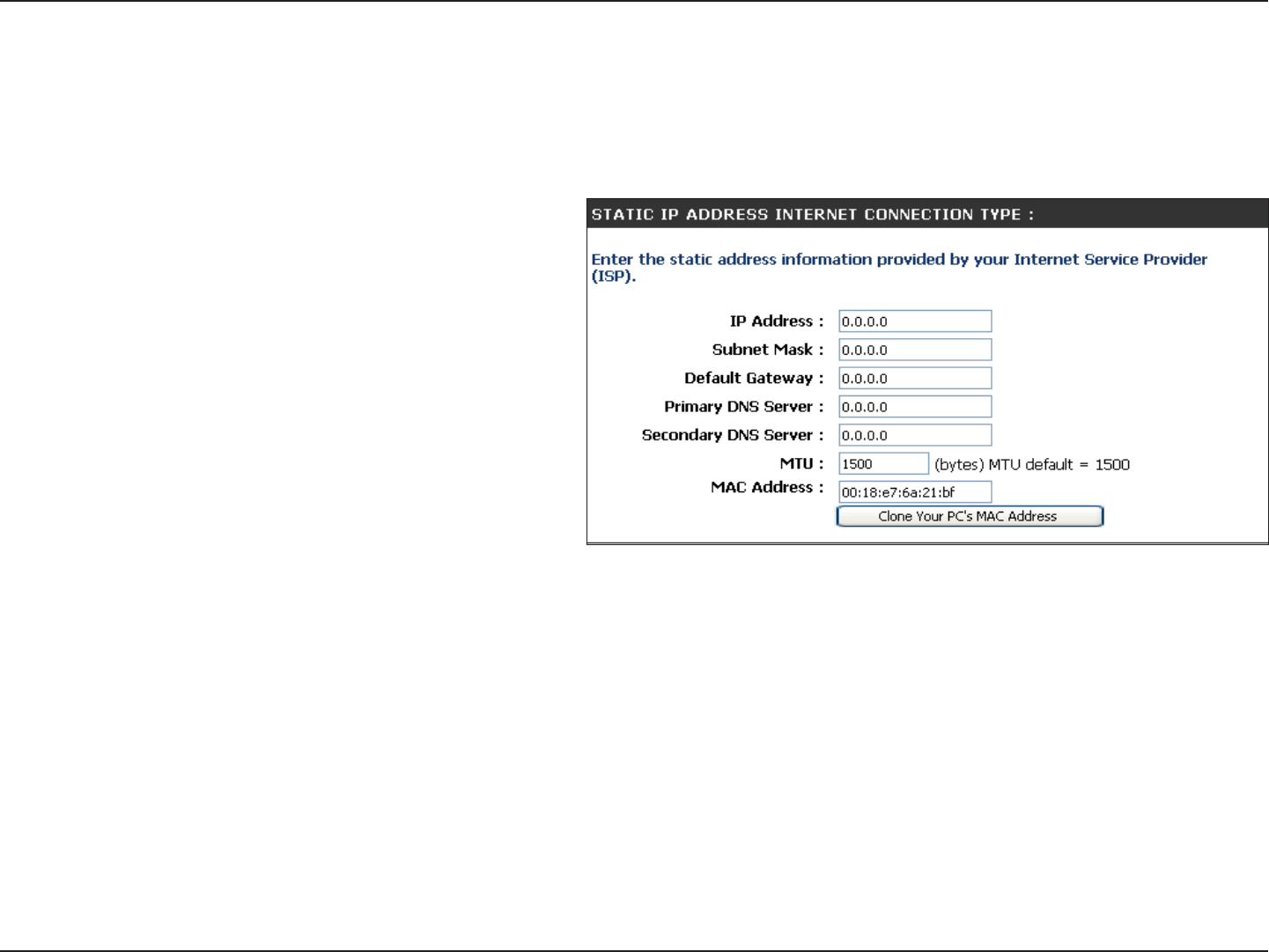
30D-Link DIR-615 User Manual
Section 3 - Conguration
Enter the IP address assigned by your ISP.
Enter the Subnet Mask assigned by your ISP.
Enter the Gateway assigned by your ISP.
The DNS server information will be supplied by your ISP
(Internet Service Provider.)
Maximum Transmission Unit - you may need to change the
MTU for optimal performance with your specic ISP. 1500
is the default MTU.
The default MAC Address is set to the Internet port’s physical
interface MAC address on the Broadband Router. It is not
recommended that you change the default MAC address
unless required by your ISP. You can use the Clone Your
PC’s MAC Address button to replace the Internet port’s
MAC address with the MAC address of your Ethernet card.
IP Address:
Subnet Mask:
Default
Gateway:
DNS Servers:
MTU:
MAC Address:
Static IP Address
Select Static IP Address if all the Internet port’s IP information is provided to you by your ISP. You will need to enter in the IP address, subnet mask,
gateway address, and DNS address(es) provided to you by your ISP. Each IP address entered in the elds must be in the appropriate IP form, which
are four octets separated by a dot (x.x.x.x). The Router will not accept the IP address if it is not in this format.
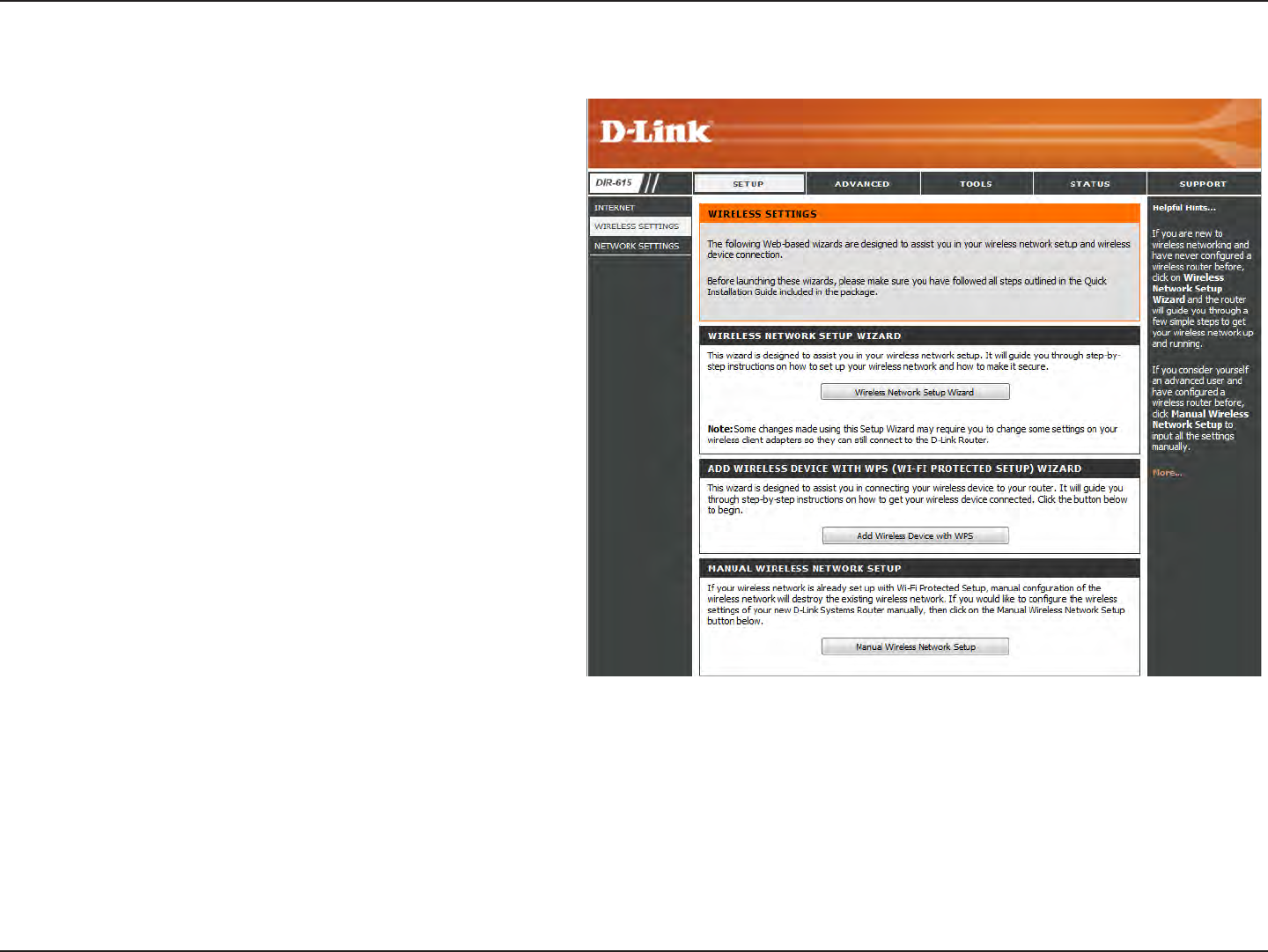
31D-Link DIR-615 User Manual
Section 3 - Conguration
Wireless Settings
If you want to congure the wireless settings on your router using
the wizard, click Wireless Network Setup Wizard and refer to
page 69.
Click Add Wireless Device with WPS if you want to add a wireless
device using Wi-Fi Protected Setup (WPS) and refer to page 72.
If you want to manually congure the wireless settings on your
router click Manual Wireless Network Setup and refer to the
next page.
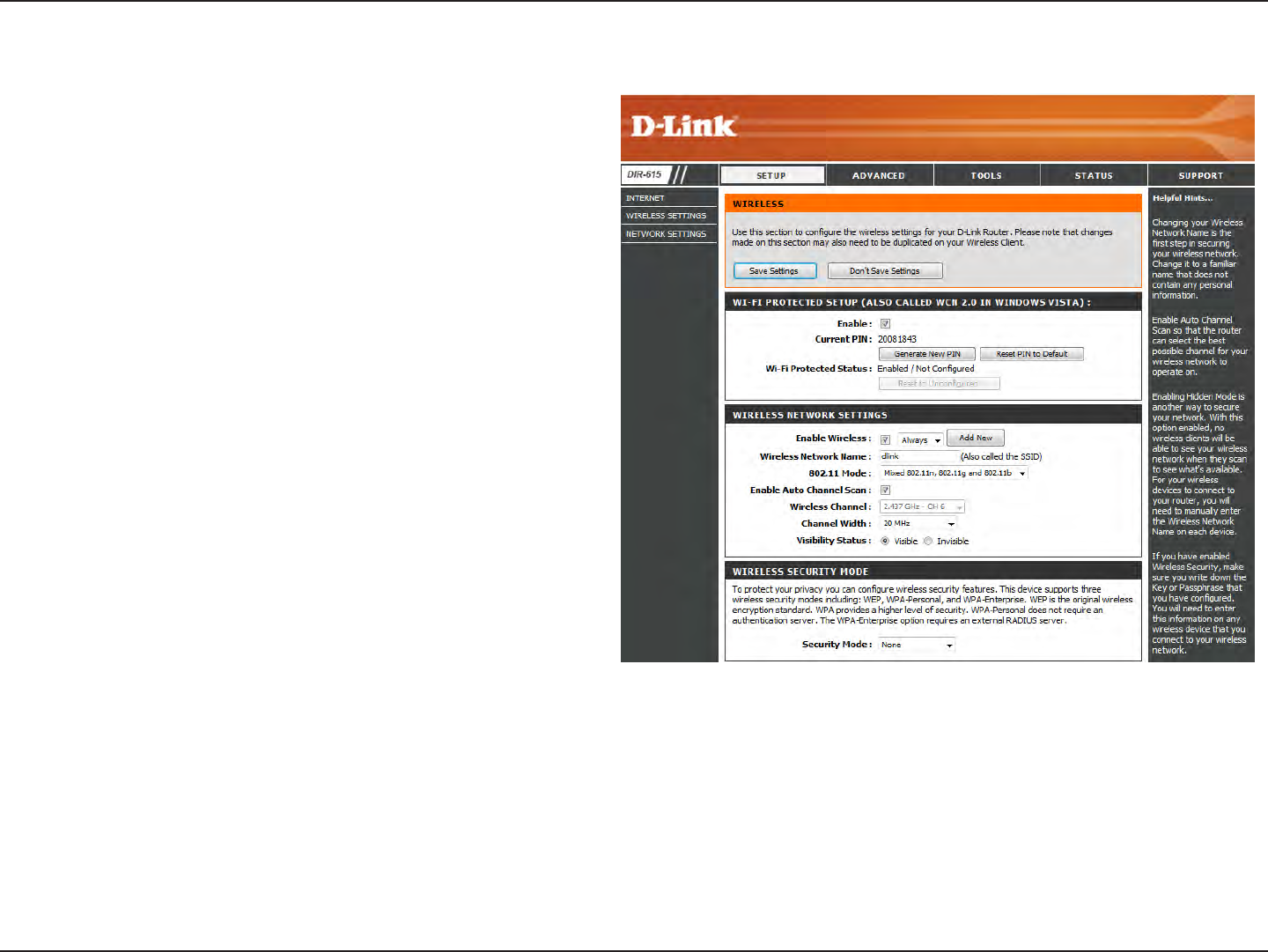
32D-Link DIR-615 User Manual
Section 3 - Conguration
Manual Wireless Network Setup
Check the box to enable the wireless function. If you do not
want to use wireless, uncheck the box to disable all the wireless
functions. Click Add New to create your own time schedule to
enable the wireless function.
Service Set Identier (SSID) is the name of your wireless network.
Create a name using up to 32 characters. The SSID is case-
sensitive.
Select one of the following:
802.11g Only - Select if all of your wireless clients are
802.11g.
802.11n Only - Select only if all of your wireless clients are
802.11n.
Mixed 802.11n and 802.11g - Select if you are using a mix
of 802.11n and 802.11g wireless clients.
The Auto Channel Scan setting can be selected to allow the DIR-
615 to choose the channel with the least amount of interference.
Indicates the channel setting for the DIR-615. By default the
channel is set to 6. The Channel can be changed to t the channel
setting for an existing wireless network or to customize the
wireless network. If you enable Auto Channel Scan, this option
will be greyed out.
Select the transmit rate. It is strongly suggested to select Best
(Auto) for best performance.
Select the Channel Width:
Auto 20/40 - Select if you are using both 802.11n and non-802.11n wireless devices.
20MHz - Select if you are not using any 802.11n wireless clients. This is the default setting.
Select Invisible if you do not want the SSID of your wireless network to be broadcasted by the DIR-615. If Invisible is selected, the SSID of the DIR-615 will not
be seen by Site Survey utilities so your wireless clients will have to know the SSID of your DIR-615 in order to connect to it.
Refer to page 79 for more information regarding wireless security.
Enable Wireless:
Wireless
Network Name:
802.11 Mode:
Enable Auto
Channel Scan:
Wireless
Channel:
Transmission
Rate:
Channel Width:
Visibility Status:
Wireless
Security:
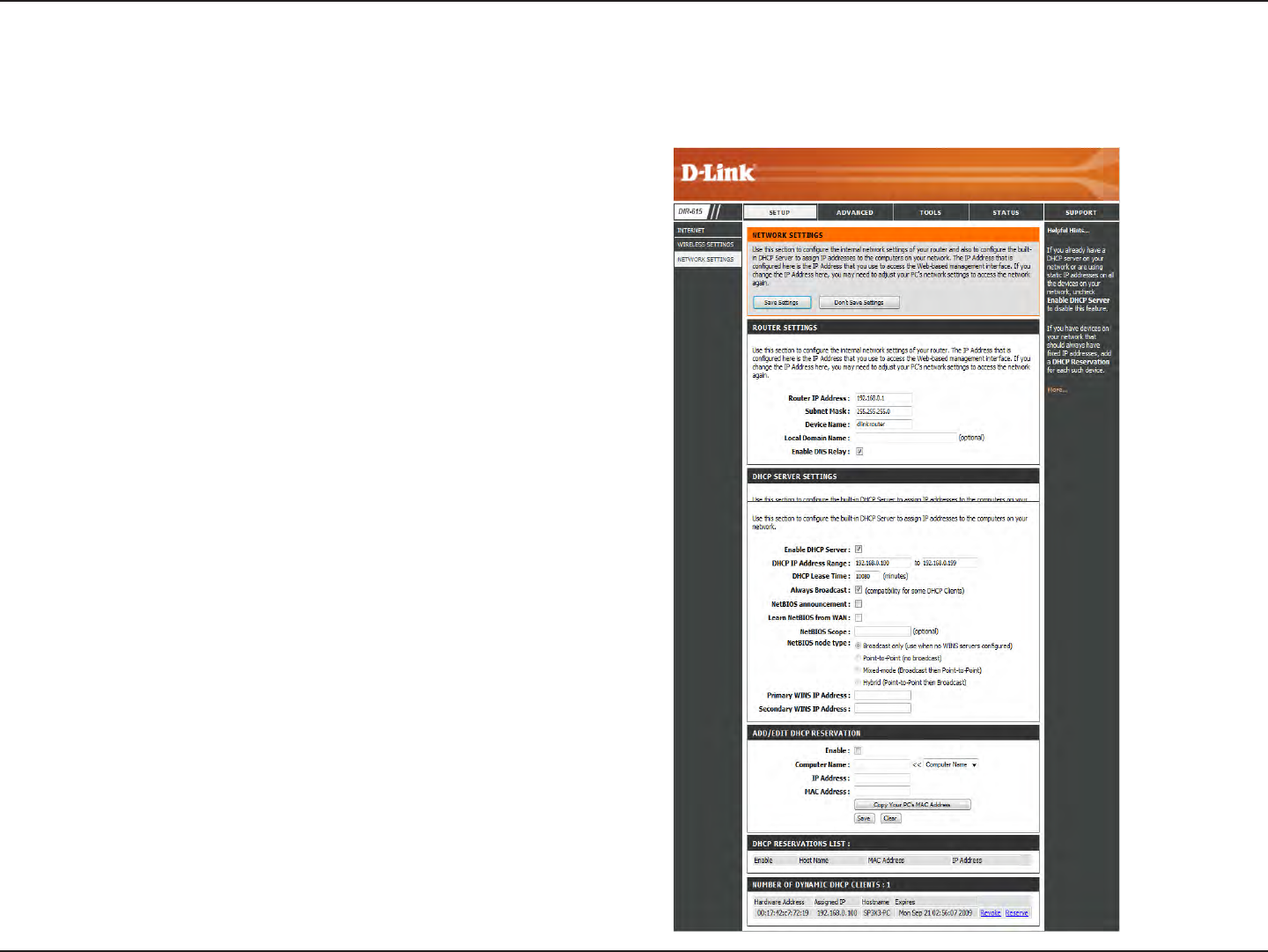
33D-Link DIR-615 User Manual
Section 3 - Conguration
This section will allow you to change the local network settings of the router and to congure the DHCP settings.
Network Settings
Enter the IP address of the router. The default IP address is 192.168.0.1.
If you change the IP address, once you click Apply, you will need
to enter the new IP address in your browser to get back into the
conguration utility.
Enter the Subnet Mask. The default subnet mask is 255.255.255.0.
Enter the Domain name (Optional).
Uncheck the box to transfer the DNS server information from your
ISP to your computers. If checked, your computers will use the router
for a DNS server.
IP Address:
Subnet Mask:
Local Domain:
Enable DNS Relay:
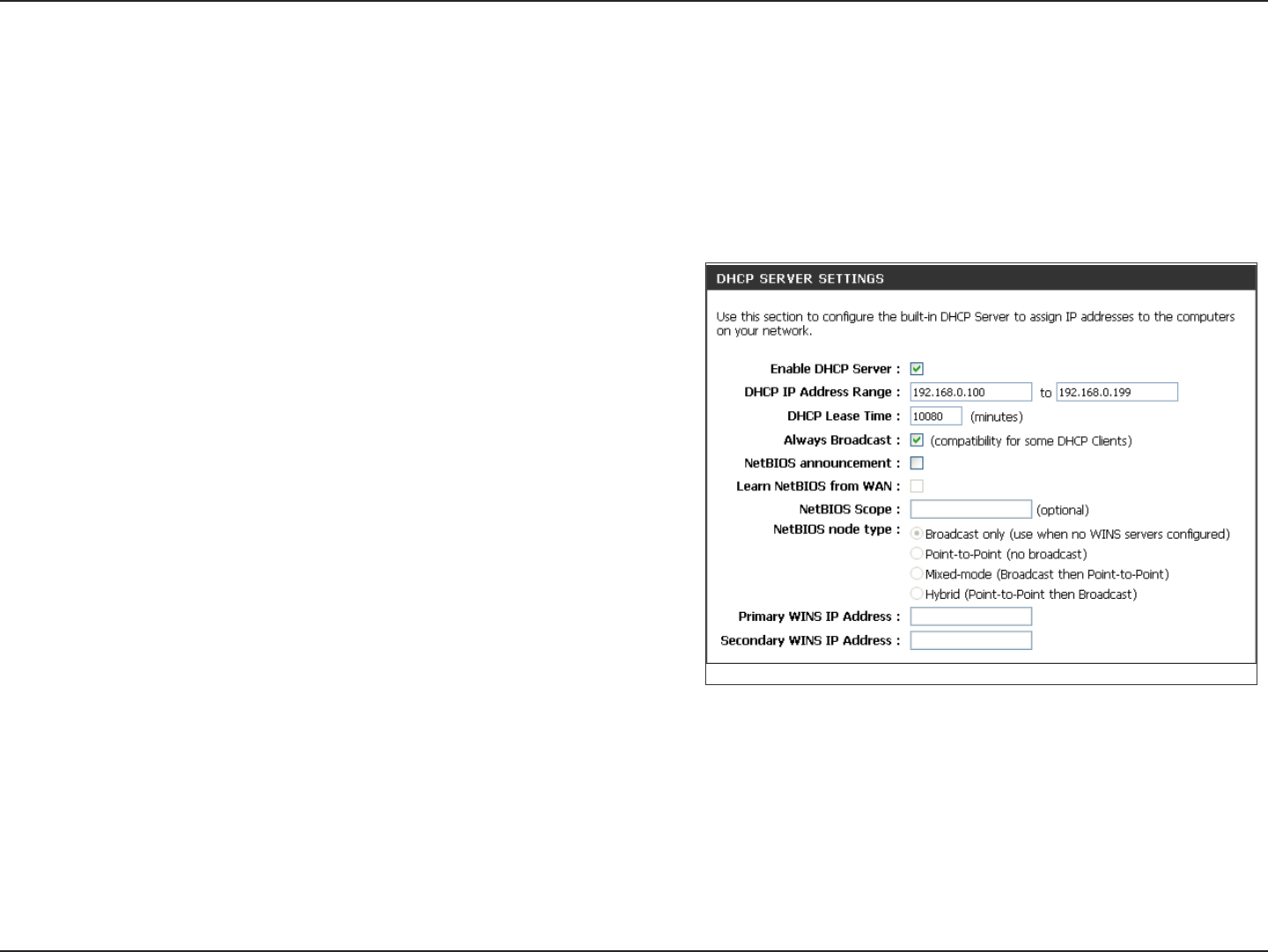
34D-Link DIR-615 User Manual
Section 3 - Conguration
Check this box to enable the DHCP server on your router. Uncheck to disable
this function.
Enter the starting and ending IP addresses for the DHCP server’s IP assignment.
Note: If you statically (manually) assign IP addresses to your computers or devices,
make sure the IP addresses are outside of this range or you may have an IP conict.
The length of time for the IP address lease. Enter the Lease time in minutes.
Enable this function to ensure compatibility with some DHCP clients.
If NetBIOS advertisement is switched on, switching this setting on causes WINS
information to be learned from the WAN side, if available. Turn this setting o
to congure manually.
This is an advance setting and is normally left blank. This allows the conguration
of NetBIOS domain name under which network hosts operate. This setting has
no eect if the “ Learn NetBIOS information form WAN is activated.
Enable DHCP
Server:
DHCP IP
Address Range:
Lease Time:
Always
Broadcast:
Learn NetBIOS
WAN:
NetBIOS scope:
DHCP Server Settings
DHCP stands for Dynamic Host Control Protocol. The DIR-615 has a built-in DHCP server. The DHCP Server will automatically assign an IP address
to the computers on the LAN/private network. Be sure to set your computers to be DHCP clients by setting their TCP/IP settings to “Obtain an IP
Address Automatically.” When you turn your computers on, they will automatically load the proper TCP/IP settings provided by the DIR-615. The
DHCP Server will automatically allocate an unused IP address from the IP address pool to the requesting computer. You must specify the starting
and ending address of the IP address pool.
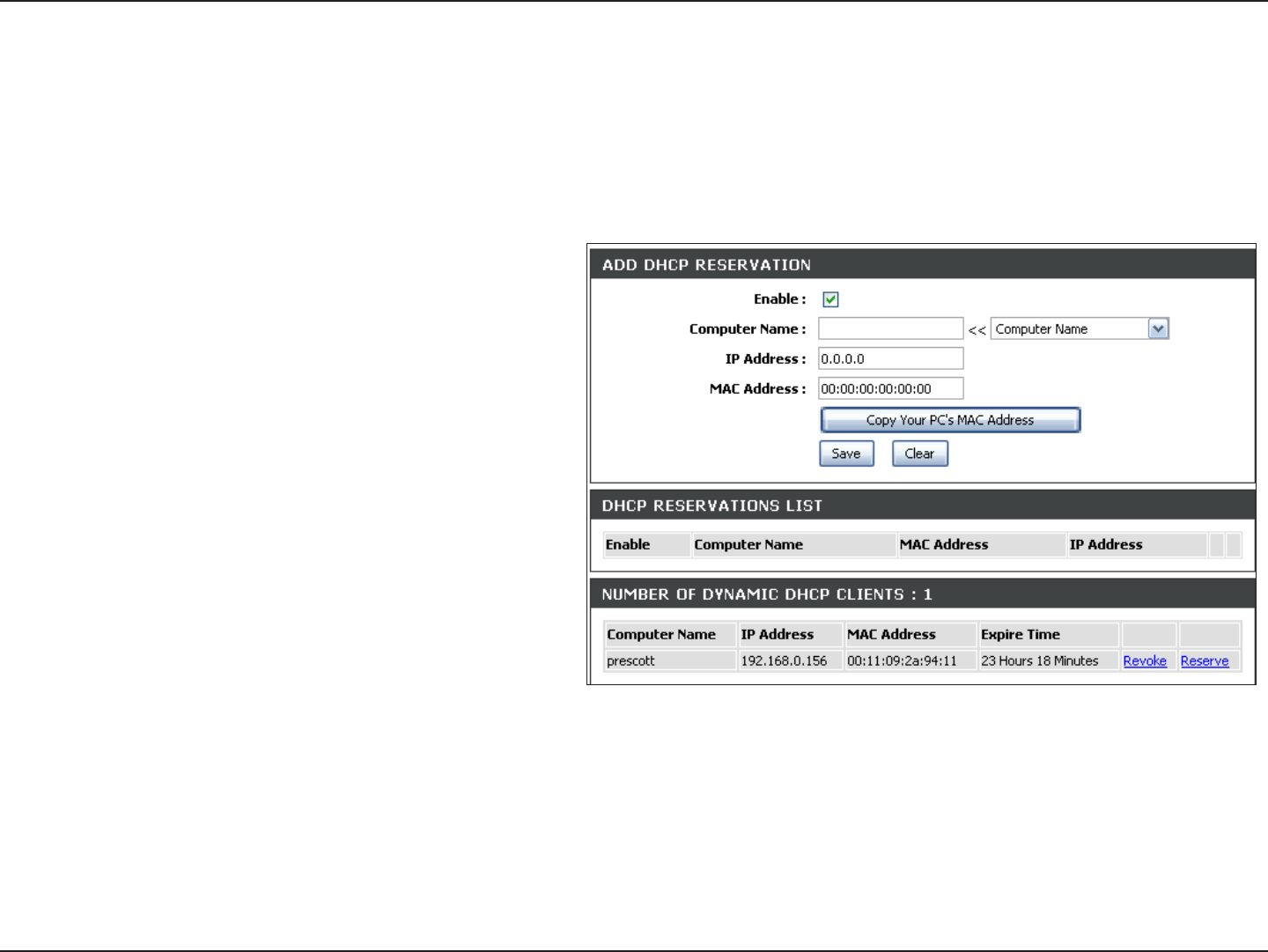
35D-Link DIR-615 User Manual
Section 3 - Conguration
DHCP Reservation
If you want a computer or device to always have the same IP address assigned, you can create a DHCP reservation. The router will assign the IP
address only to that computer or device.
Note: This IP address must be within the DHCP IP Address Range.
Check this box to enable the reservation.
Enter the computer name or select from the drop-down menu
and click <<.
Enter the IP address you want to assign to the computer or
device. This IP Address must be within the DHCP IP Address
Range.
Enter the MAC address of the computer or device.
If you want to assign an IP address to the computer you are
currently on, click this button to populate the elds.
Click Save to save your entry. You must click Save Settings at
the top to activate your reservations.
In this section you can see what LAN devices are currently
leasing IP addresses.
Click Revoke to cancel the lease for a specic LAN device and
free an entry in the lease table. Do this only if the device no
longer needs the leased IP address, because, for example, it has been removed from the network.
Note: The Revoke option will not disconnect a PC with a current network session from the network; you would need to use MAC Address Filter to do that. Revoke will
only free up a DHCP Address for the very next requester. If the previous owner is still available, those two devices may both receive an IP Address Conict error, or the
second device may still not receive an IP Address; in that case, you may still need to extend the “DHCP IP Address Range” to address the issue, it is located in the DHCP
Server section.
The Reserve option converts this dynamic IP allocation into a DHCP Reservation and adds the corresponding entry to the DHCP Reservations List.
Enable:
Computer
Name:
IP Address:
MAC Address:
Copy Your PC’s
MAC Address:
Save:
Dynamic DHCP
Clients:
Revoke:
Reserve:
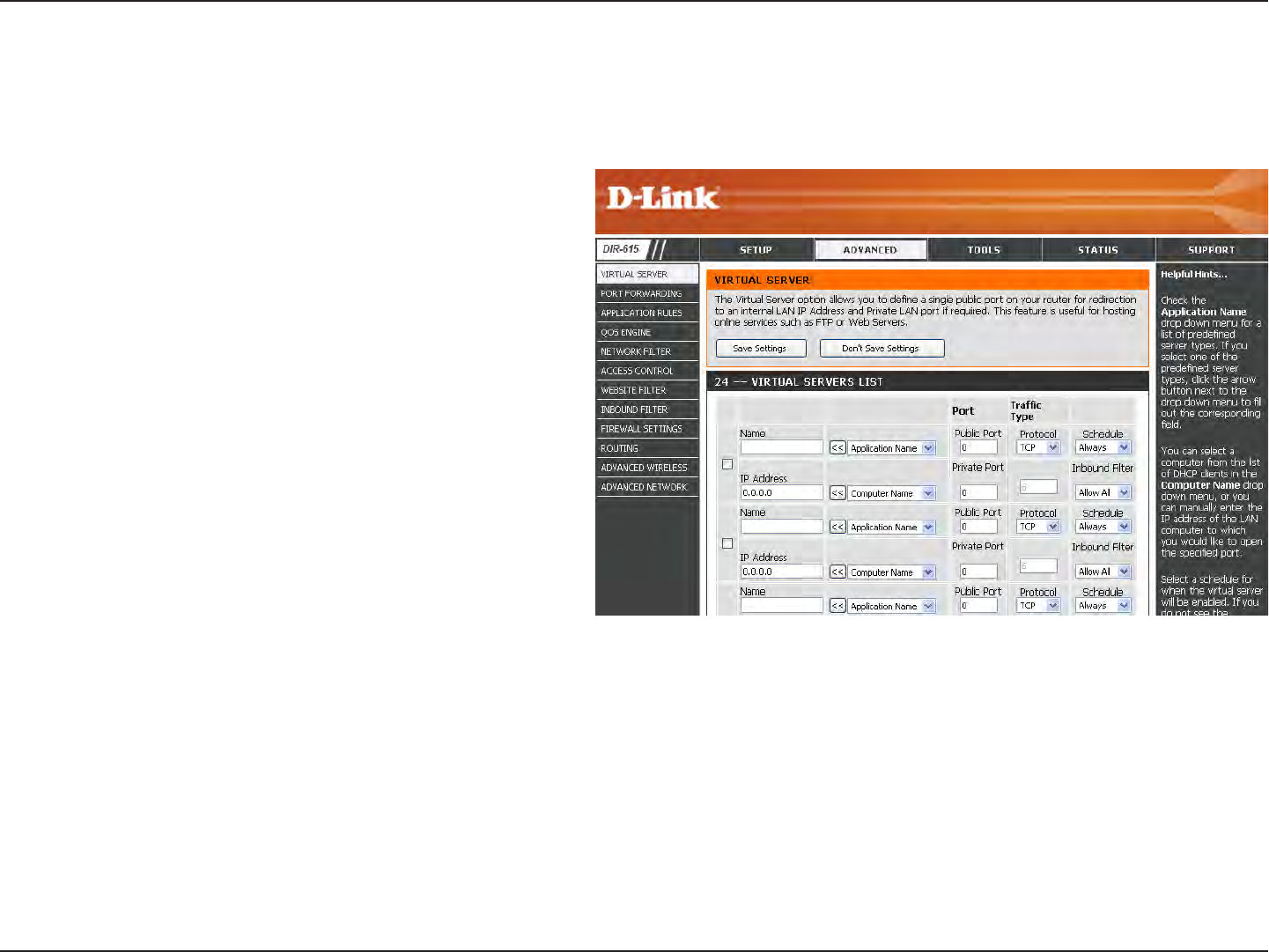
36D-Link DIR-615 User Manual
Section 3 - Conguration
The DIR-615 can be congured as a virtual server so that remote users accessing Web or FTP services via the public IP address can be automatically
redirected to local servers in the LAN (Local Area Network).
The DIR-615 rewall feature lters out unrecognized packets to
protect your LAN network so all computers networked with the
DIR-615 are invisible to the outside world. If you wish, you can
make some of the LAN computers accessible from the Internet by
enabling Virtual Server. Depending on the requested service, the
DIR-615 redirects the external service request to the appropriate
server within the LAN network.
The DIR-615 is also capable of port-redirection meaning incoming
trac to a particular port may be redirected to a dierent port
on the server computer.
Each virtual service that is created will be listed at the
bottom of the screen in the Virtual Servers List. There are
pre-dened virtual services already in the table. You may use
them by enabling them and assigning the server IP to use that
particular virtual service.
For a list of ports for common applications, please visit http://
support.dlink.com/faq/view.asp?prod_id=1191.
Virtual Server
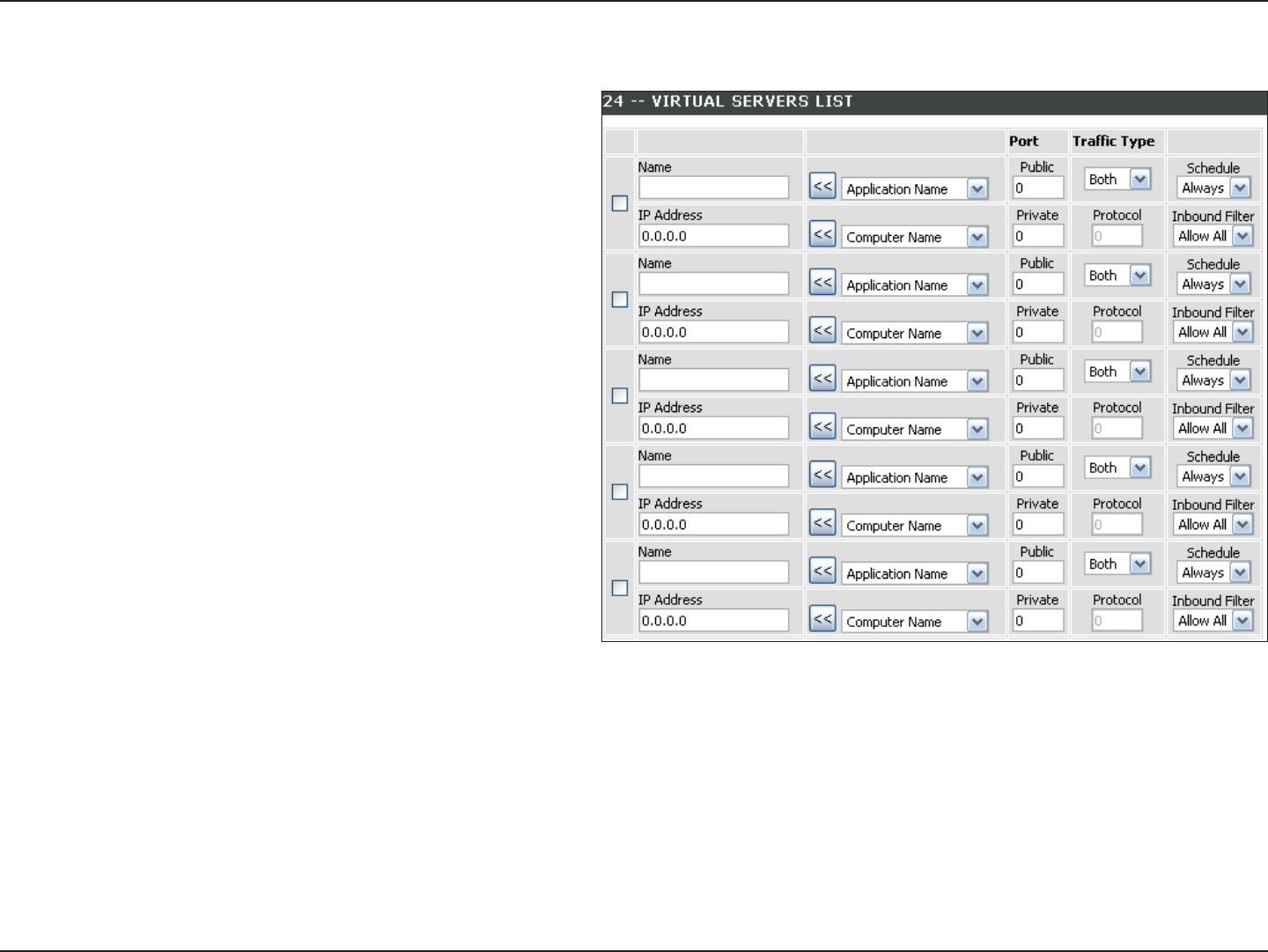
37D-Link DIR-615 User Manual
Section 3 - Conguration
This will allow you to open a single port. If you would like to open a range of ports, refer to the next page.
Enter a name for the rule or select an application from the drop-
down menu. Select an application and click << to populate the
elds.
Enter the IP address of the computer on your local network that
you want to allow the incoming service to. If your computer is
receiving an IP address automatically from the router (DHCP),
you computer will be listed in the “Computer Name” drop-down
menu. Select your computer and click <<.
Enter the port that you want to open next to Private Port and
Public Port. The private and public ports are usually the same.
The public port is the port seen from the Internet side, and the
private port is the port being used by the application on the
computer within your local network.
Select TCP, UDP, Both or Other from the drop-down menu.
Select Allow All (most common) or a created Inbound lter.
You may create your own inbound lters in the Advanced >
Inbound Filter page.
The schedule of time when the Virtual Server Rule will be
enabled. The schedule may be set to Always, which will allow
the particular service to always be enabled. You can create your
own times in the Tools > Schedules section.
Name:
IP Address:
Private Port/
Public Port:
Protocol Type:
Inbound Filter:
Schedule:
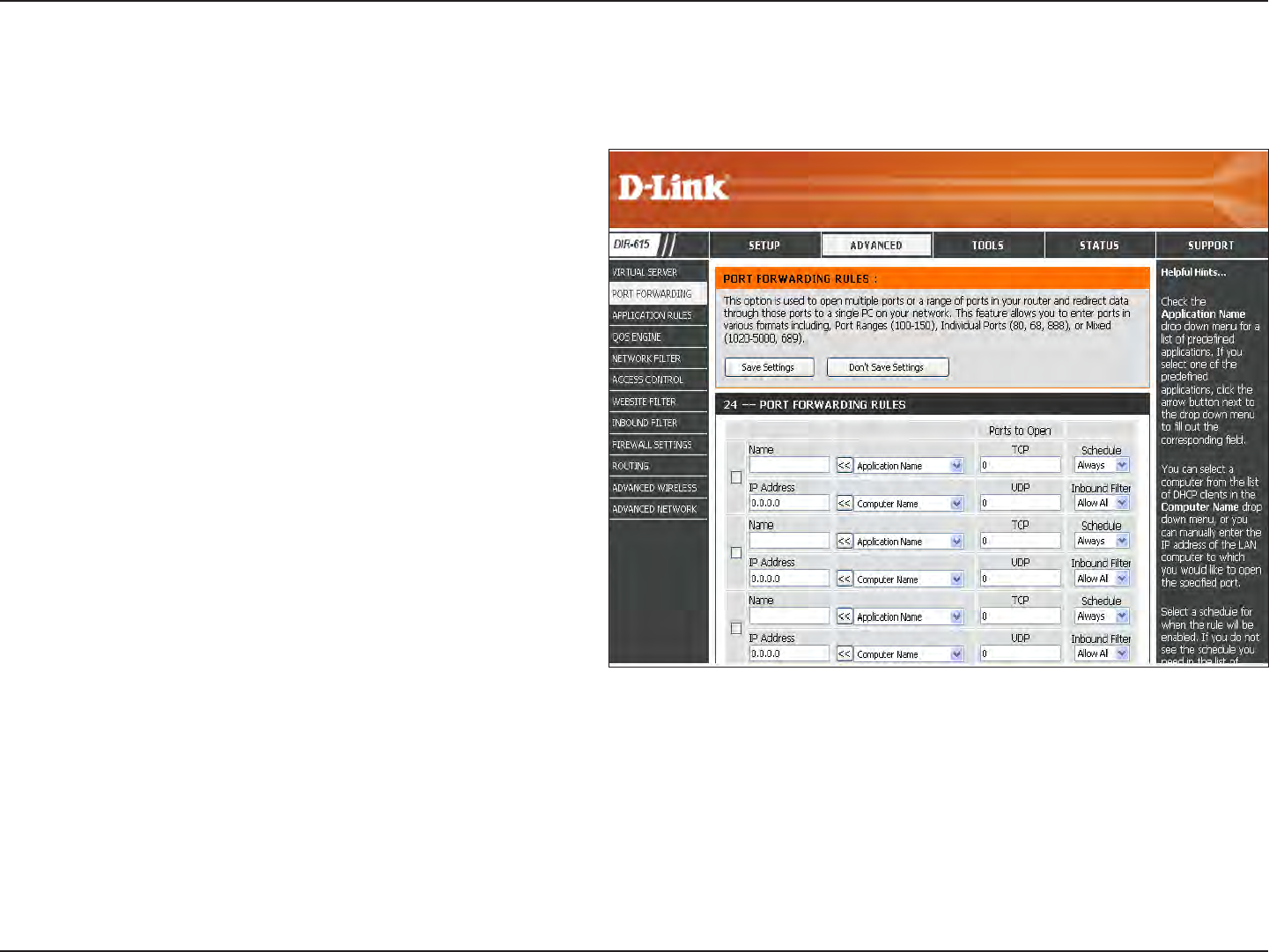
38D-Link DIR-615 User Manual
Section 3 - Conguration
This will allow you to open a single port or a range of ports.
Port Forwarding
Enter a name for the rule or select an application from the drop-
down menu. Select an application and click << to populate the
elds.
Enter the IP address of the computer on your local network that
you want to allow the incoming service to. If your computer is
receiving an IP address automatically from the router (DHCP),
you computer will be listed in the “Computer Name” drop-down
menu. Select your computer and click <<.
Enter the TCP and/or UDP port or ports that you want to open.
You can enter a single port or a range of ports. Separate ports
with a common.
Example: 24,1009,3000-4000
Select Allow All (most common) or a created Inbound lter. You
may create your own inbound lters in the Advanced > Inbound
Filter page.
The schedule of time when the Virtual Server Rule will be enabled.
The schedule may be set to Always, which will allow the particular
service to always be enabled. You can create your own times in the
Tools > Schedules section.
Name:
IP Address:
TCP/UDP:
Inbound Filter:
Schedule:
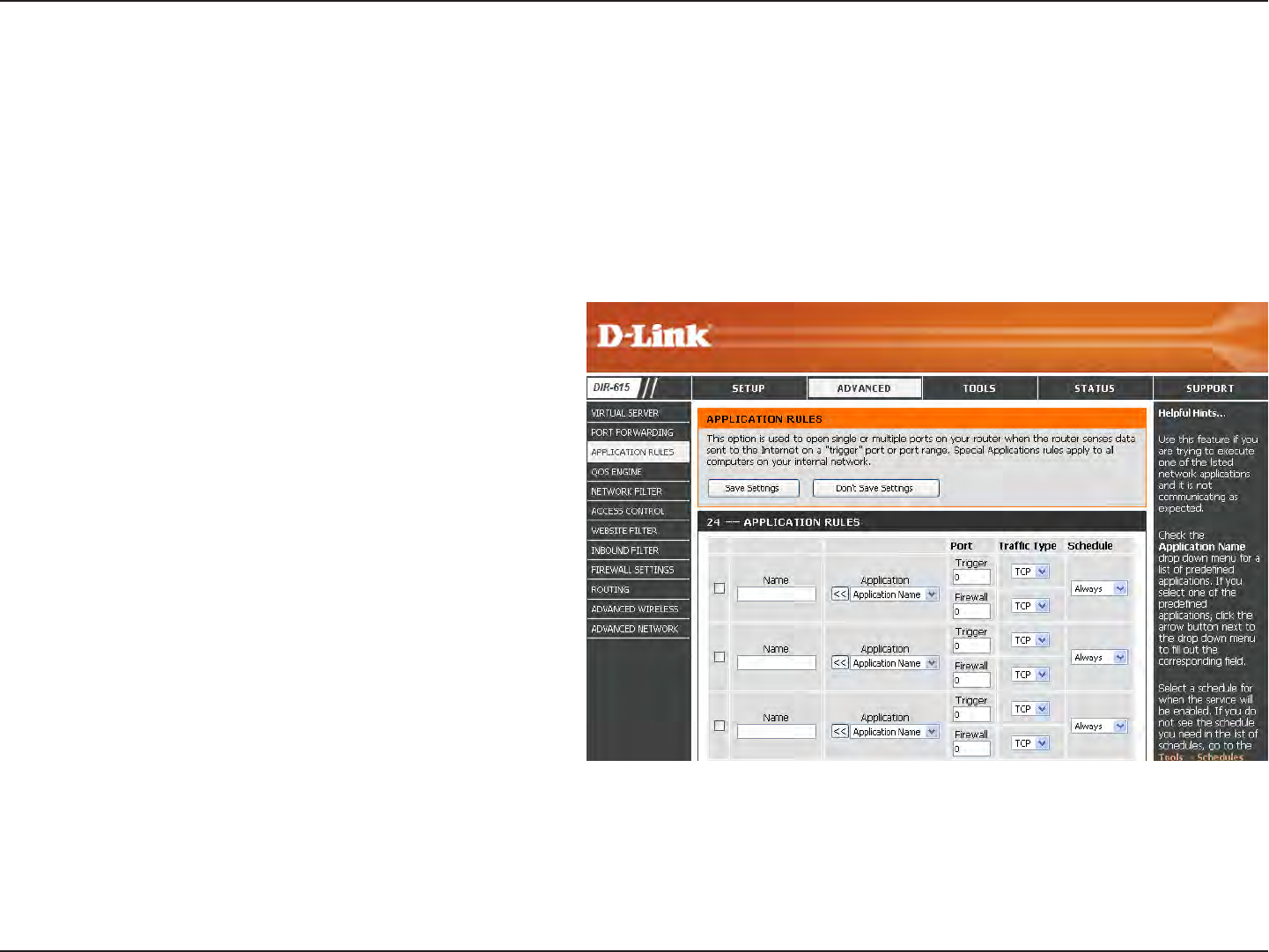
39D-Link DIR-615 User Manual
Section 3 - Conguration
Enter a name for the rule. You may select a pre-dened
application from the drop-down menu and click <<.
This is the port used to trigger the application. It can be either
a single port or a range of ports.
Select the protocol of the trigger port (TCP, UDP, or Both).
This is the port number on the Internet side that will be used
to access the application. You may dene a single port or a
range of ports. You can use a comma to add multiple ports
or port ranges.
Select the protocol of the rewall port (TCP, UDP, or Any).
The schedule of time when the Application Rule will be
enabled. The schedule may be set to Always, which will allow
the particular service to always be enabled. You can create
your own times in the Tools > Schedules section.
Name:
Trigger:
Trac Type:
Firewall:
Trac Type:
Schedule:
Application Rules
Some applications require multiple connections, such as Internet gaming, video conferencing, Internet telephony and others. These applications
have diculties working through NAT (Network Address Translation). Special Applications makes some of these applications work with the
DIR-615. If you need to run applications that require multiple connections, specify the port normally associated with an application in the
“Trigger Port” eld, select the protocol type as TCP or UDP, then enter the rewall (public) ports associated with the trigger port to open them
for inbound trac.
The DIR-615 provides some predened applications in the table on the bottom of the web page. Select the application you want to use and enable it.
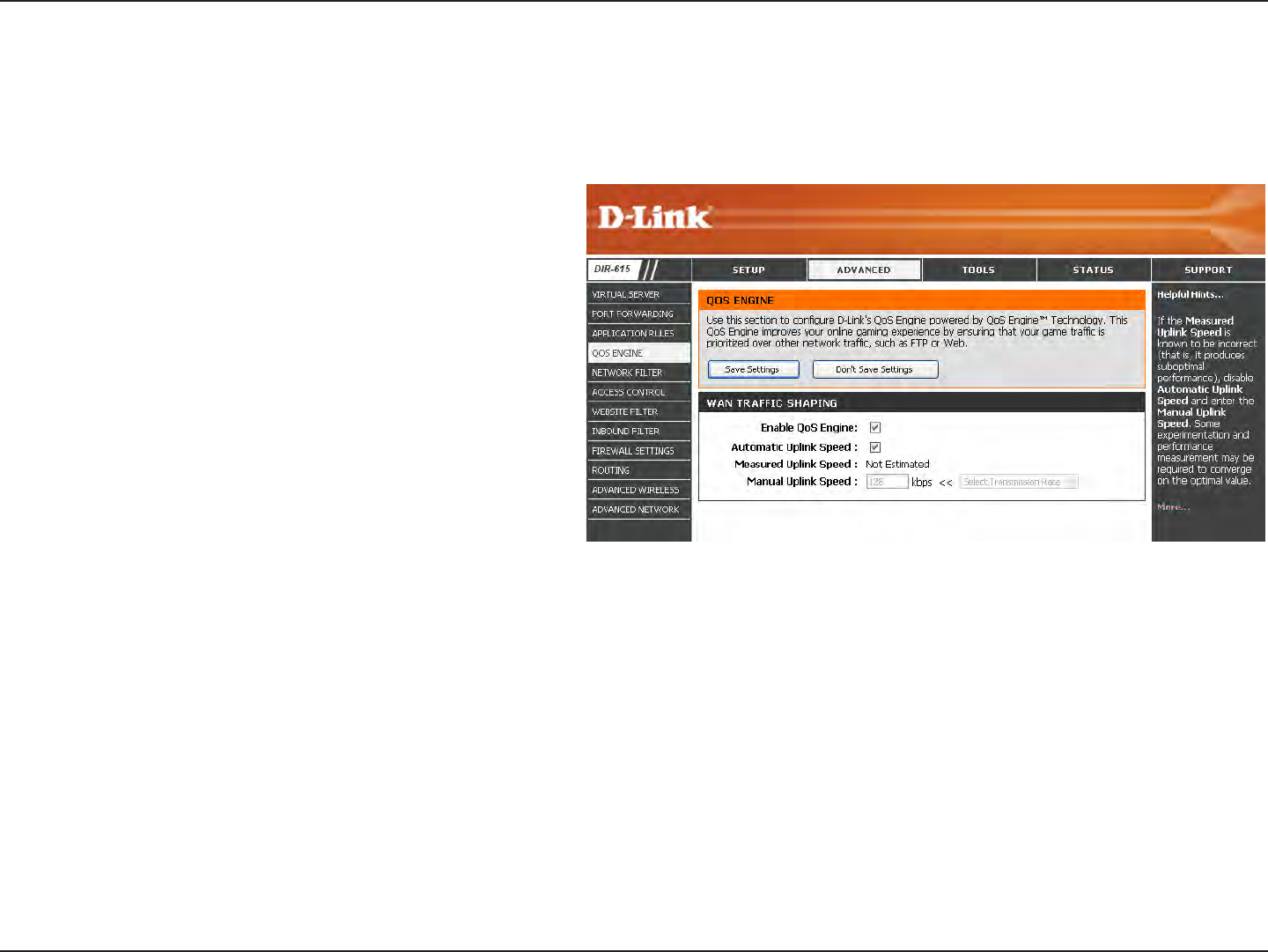
40D-Link DIR-615 User Manual
Section 3 - Conguration
QoS Engine
This option is disabled by default. Enable this option for
better performance and experience with online games and
other interactive applications, such as VoIP.
This option is enabled by default when the QoS Engine
option is enabled. This option will allow your router to
automatically determine the uplink speed of your Internet
connection.
This displays the detected uplink speed.
The speed at which data can be transferred from the router
to your ISP. This is determined by your ISP. ISP’s oer speed
as a download/upload pair. For example, 1.5Mbits/284Kbits.
Using this example, you would enter 284. Alternatively you
can test your uplink speed with a service such as www.
dslreports.com.
Enable QoS
Engine:
Automatic
Uplink Speed:
Measured
Uplink Speed:
Manual Uplink
Speed:
The QoS Engine option helps improve your network gaming performance by prioritizing applications. By default the QoS Engine settings are
disabled and application priority is not classied automatically.
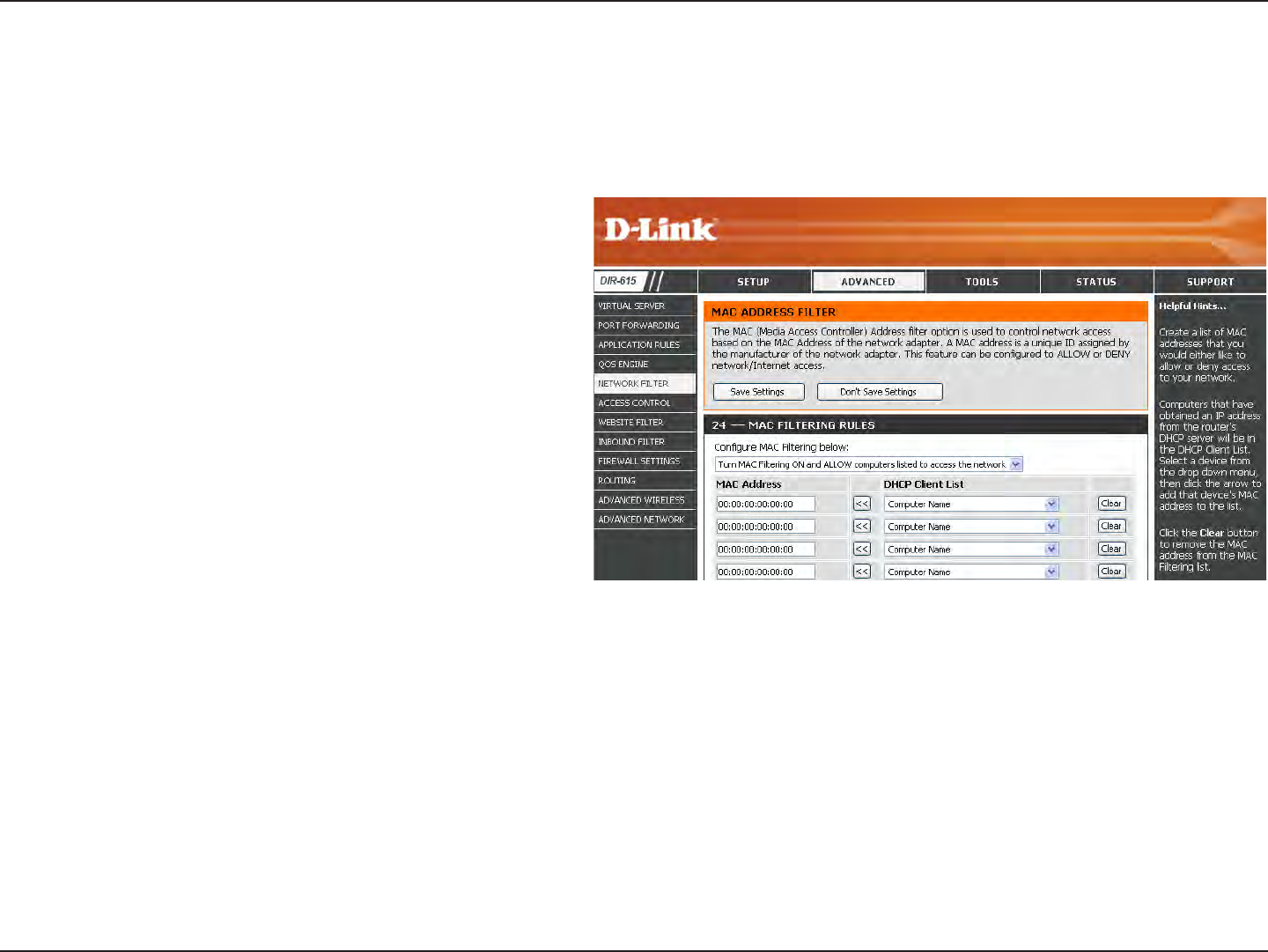
41D-Link DIR-615 User Manual
Section 3 - Conguration
Network Filters
Select Turn MAC Filtering O, allow MAC addresses listed below,
or deny MAC addresses listed below from the drop-down menu.
Enter the MAC address you would like to lter.
To nd the MAC address on a computer, please refer to the
Networking Basics section in this manual.
Select a DHCP client from the drop-down menu and click <<
to copy that MAC Address.
Congure MAC
Filtering:
MAC Address:
DHCP Client:
Use MAC (Media Access Control) Filters to allow or deny LAN (Local Area Network) computers by their MAC addresses from accessing the Network.
You can either manually add a MAC address or select the MAC address from the list of clients that are currently connected to the Broadband Router.
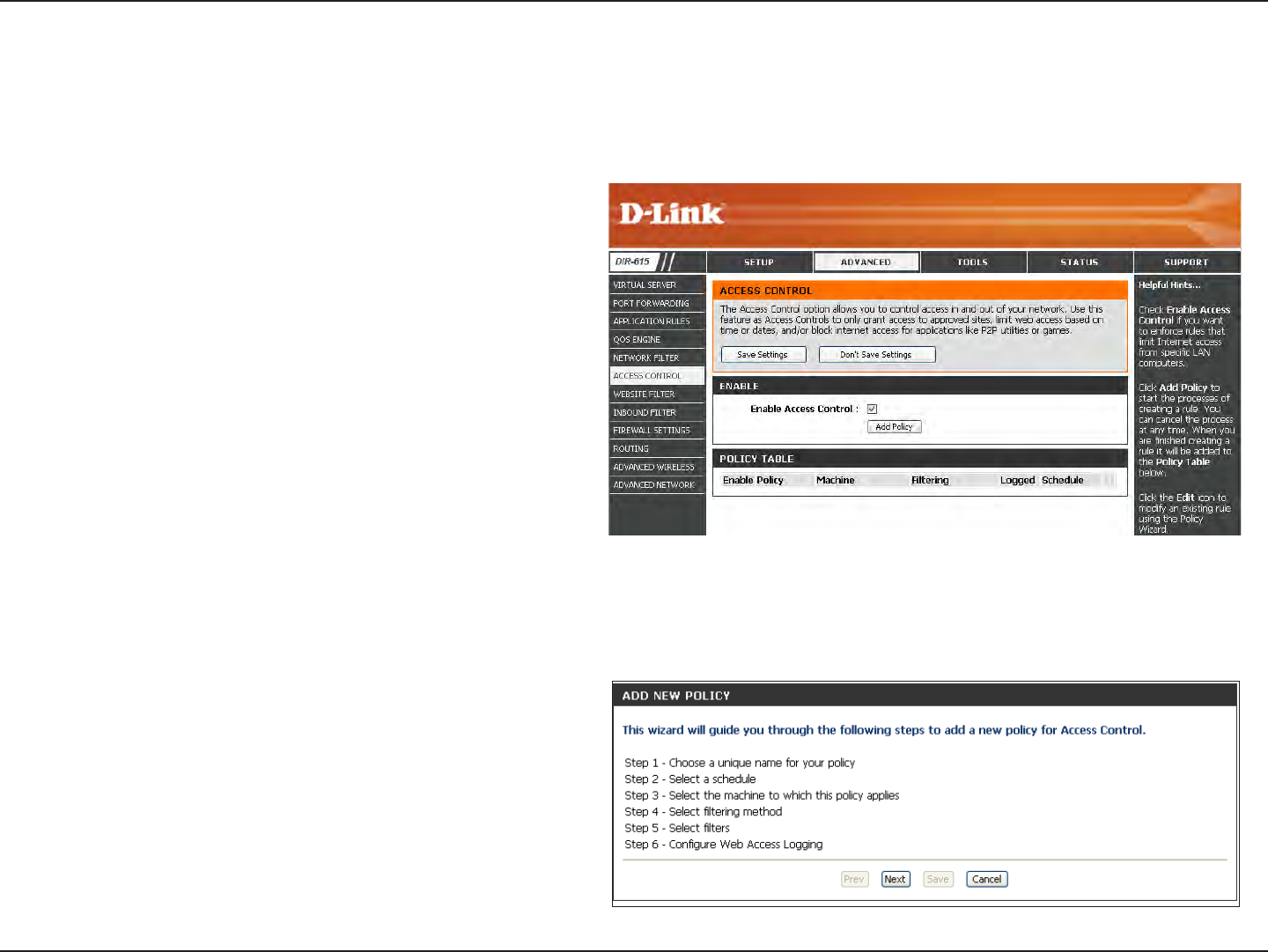
42D-Link DIR-615 User Manual
Section 3 - Conguration
Access Control
Check the Enable Access Control check box and click the
Add Policy button to start the Access Control Wizard.
Add Policy:
The Access Control section allows you to control access in and out of your network. Use this feature as Parental Controls to only grant access to
approved sites, limit web access based on time or dates, and/or block access from applications like P2P utilities or games.
Click Next to continue with the wizard.
Access Control Wizard
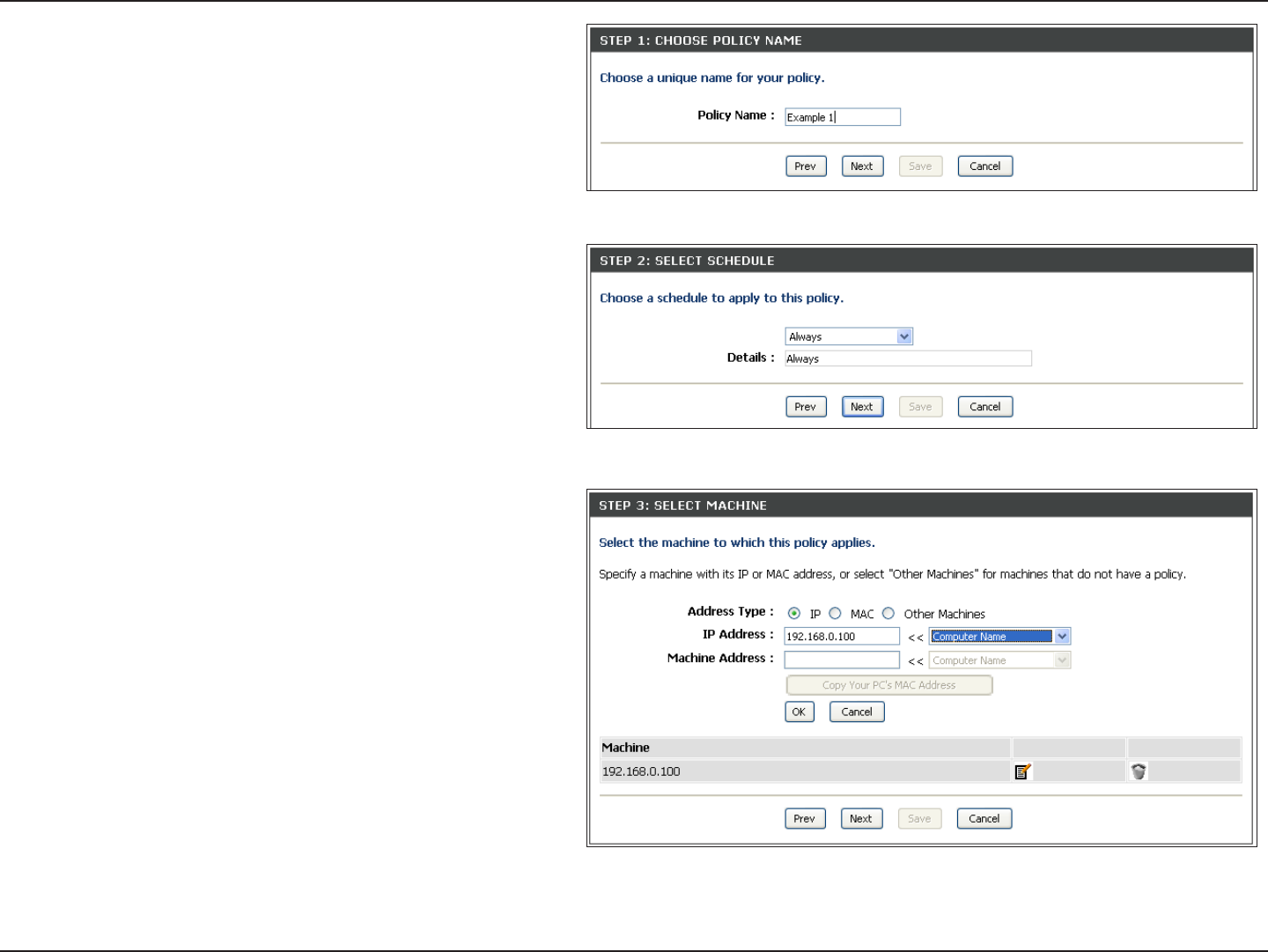
43D-Link DIR-615 User Manual
Section 3 - Conguration
Enter a name for the policy and then click Next to continue.
Select a schedule (I.E. Always) from the drop-down menu and
then click Next to continue.
Enter the following information and then click Next to continue.
• Address Type - Select IP address, MAC address, or Other Machines.
• IP Address - Enter the IP address of the computer you want to apply
the rule to.
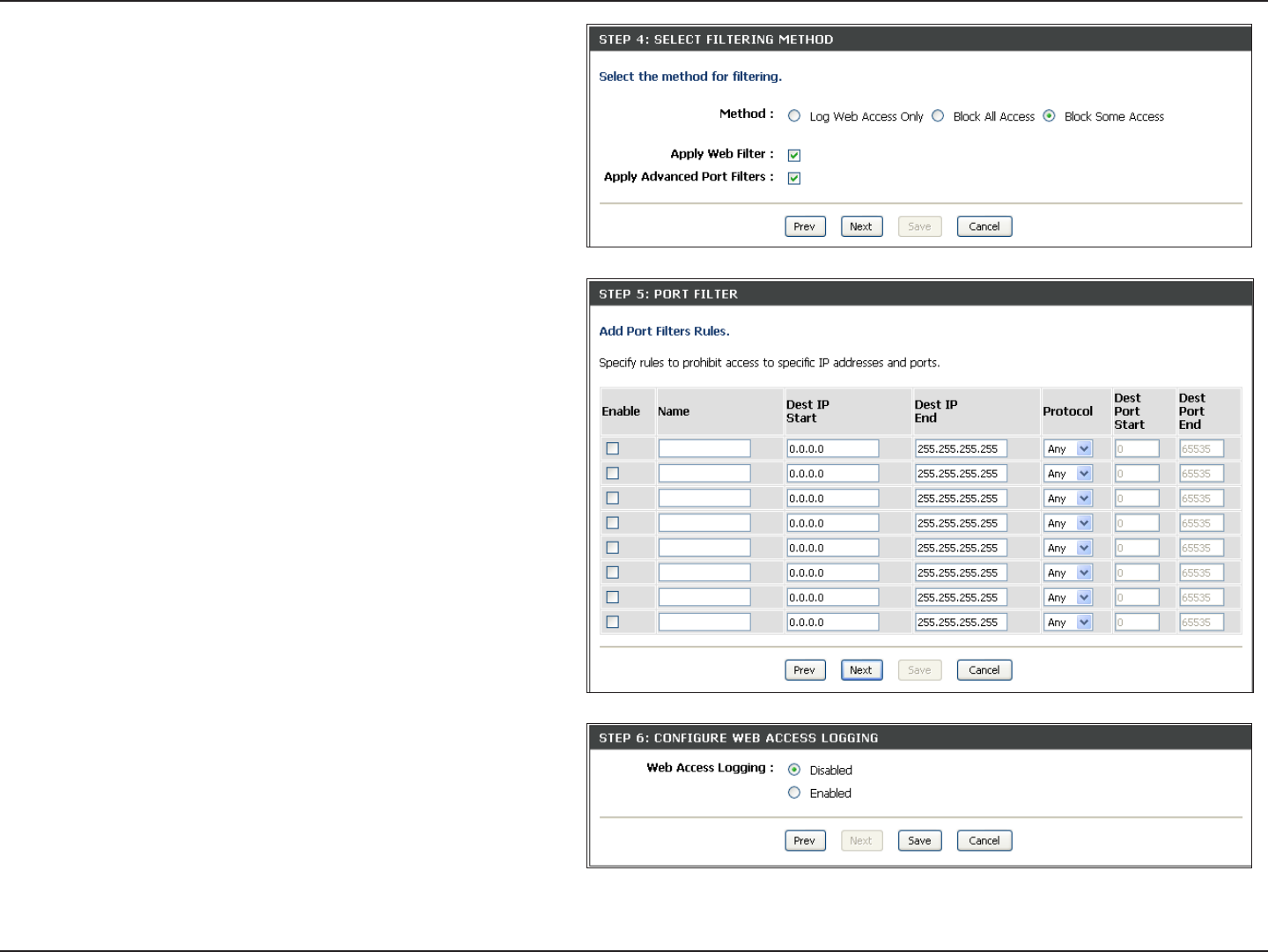
44D-Link DIR-615 User Manual
Section 3 - Conguration
Select the ltering method and then click Next to continue.
Enter the rule:
Enable - Check to enable the rule.
Name - Enter a name for your rule.
Dest IP Start - Enter the starting IP address.
Dest IP End - Enter the ending IP address.
Protocol - Select the protocol.
Dest Port Start - Enter the starting port number.
Dest Port End - Enter the ending port number.
To enable web logging, click Enable.
Click Save to save the access control rule.
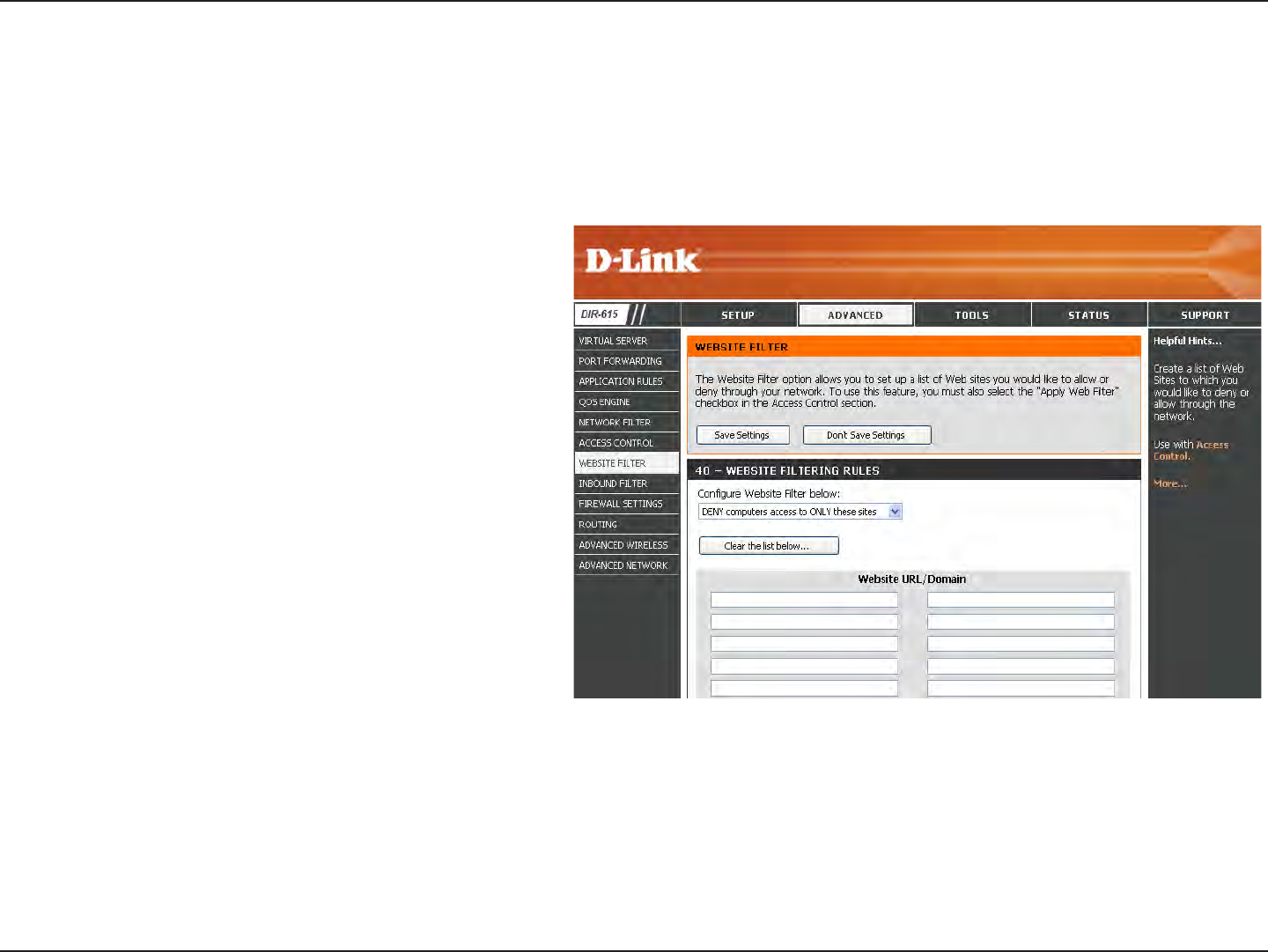
45D-Link DIR-615 User Manual
Section 3 - Conguration
Select Deny or Allow computers access to only these
sites.
Click to delete all entries in the list.
Enter the keywords or URLs that you want to allow
or deny.
Congure Website
Filter Below:
Clear the list below:
Website URL/
Domain:
Website Filters
Website Filters are used to allow you to set up a list of allowed Web sites that can be used by multiple users through the network. To use this feature
select to Allow or Deny, enter the domain or website and click Add, and then click Save Settings. You must also select Apply Web Filter under
the Access Control section (page 42).
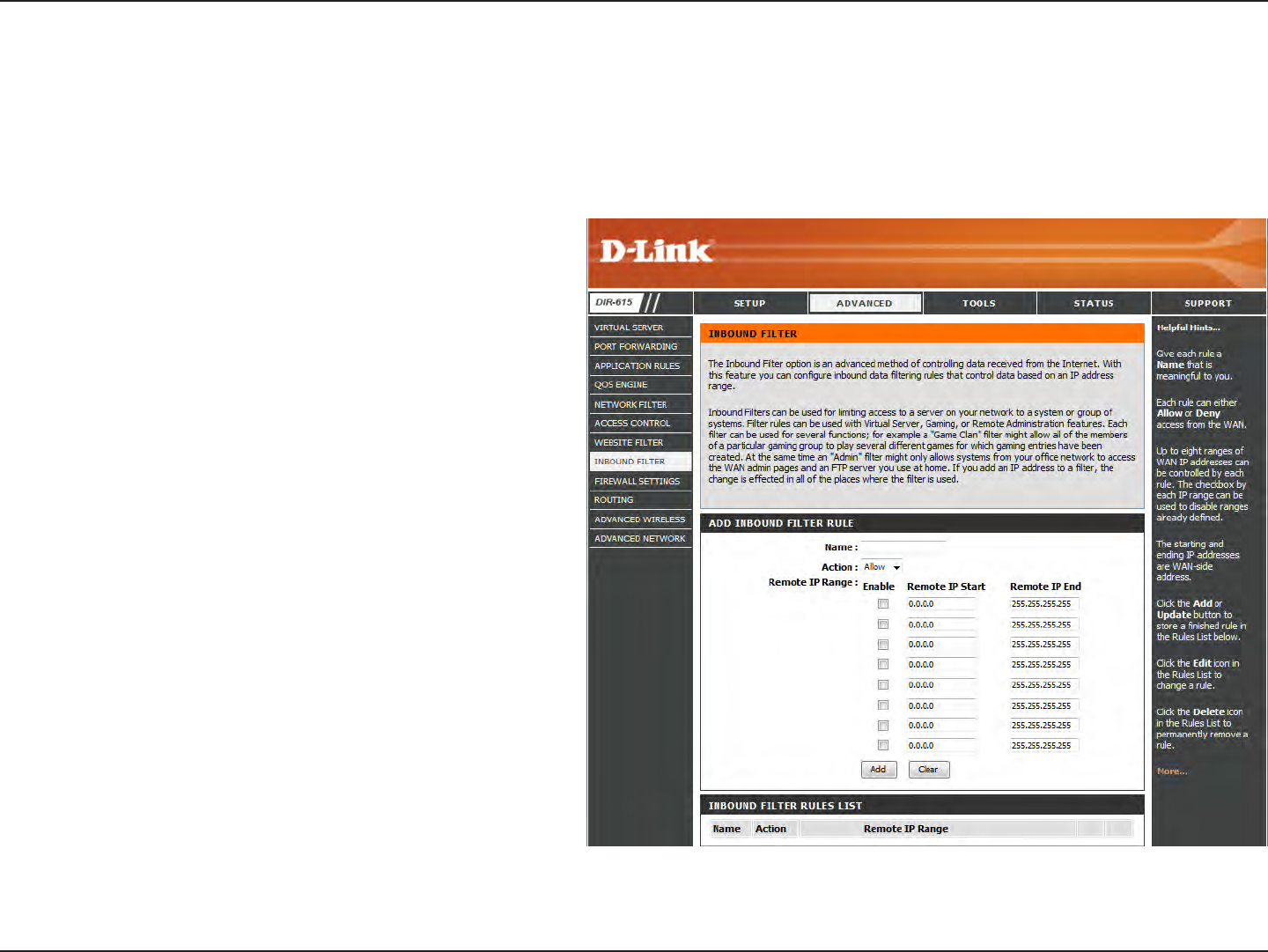
46D-Link DIR-615 User Manual
Section 3 - Conguration
Enter a name for the inbound lter rule.
Select Allow or Deny.
Check to enable rule.
Enter the starting IP address. Enter 0.0.0.0 if you do not want
to specify an IP range.
Enter the ending IP address. Enter 255.255.255.255 if you do
not want to specify and IP range.
Click the Save button to apply your settings. You must click
Save Settings at the top to save the settings.
This section will list any rules that are created. You may click
the Edit icon to change the settings or enable/disable the
rule, or click the Delete icon to remove the rule.
Name:
Action:
Enable:
Source IP Start:
Source IP End:
Save:
Inbound Filter
Rules List:
The Inbound Filter option is an advanced method of controlling data received from the Internet. With this feature you can congure inbound
data ltering rules that control data based on an IP address range. Inbound Filters can be used with Virtual Server, Port Forwarding, or Remote
Administration features.
Inbound Filters
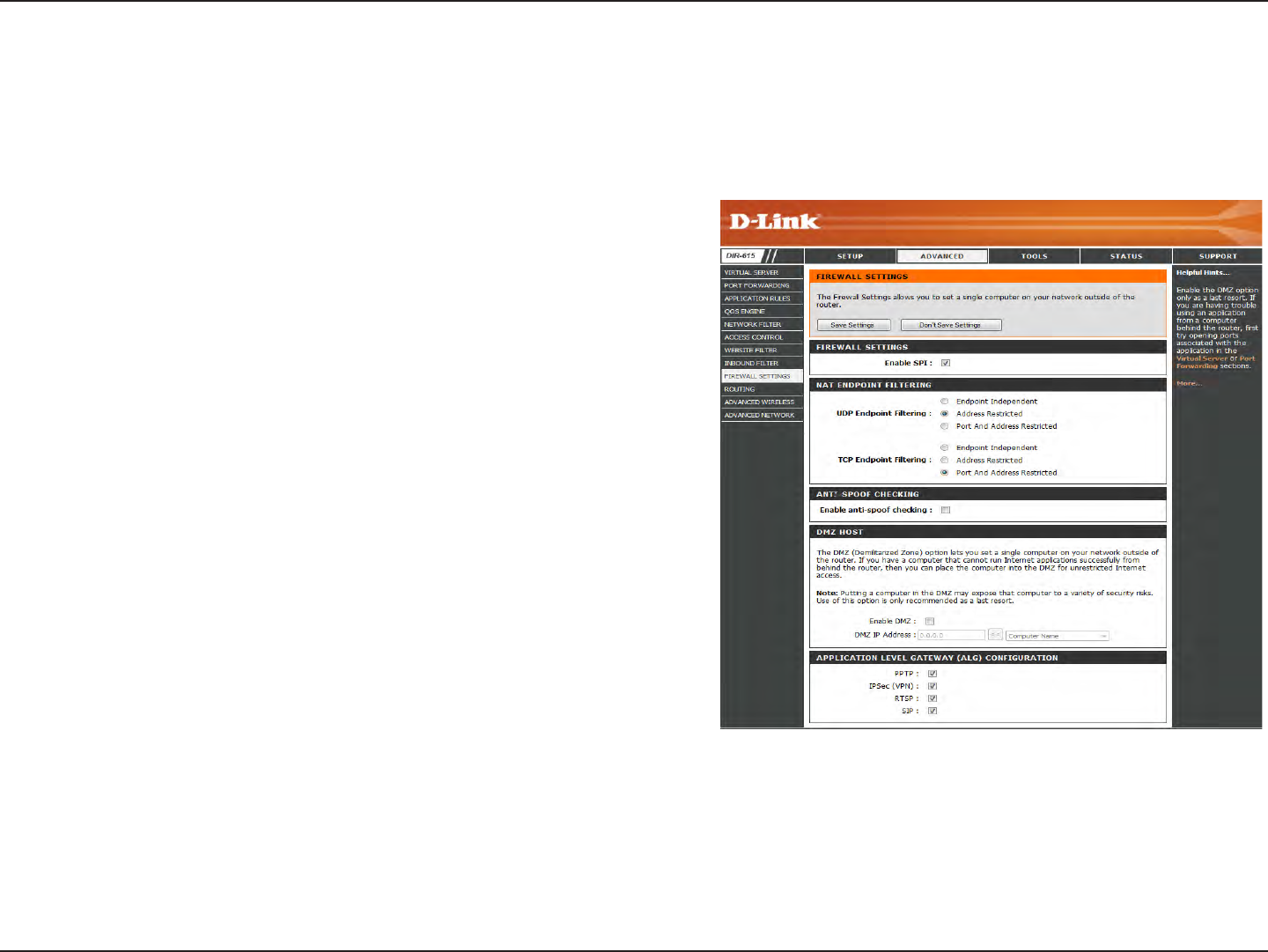
47D-Link DIR-615 User Manual
Section 3 - Conguration
SPI (Stateful Packet Inspection, also known as dynamic packet ltering) helps
to prevent cyber attacks by tracking more state per session. It validates that
the trac passing through the session conforms to the protocol.
Select one of the following for TCP and UDP ports:
Endpoint Independent - Any incoming trac sent to an open port will be
forwarded to the application that opened the port. The port will close if idle
for 5 minutes.
Address Restricted - Incoming trac must match the IP address of the
outgoing connection.
Address + Port Restriction - Incoming trac must match the IP address and
port of the outgoing connection.
Enable this option to provide protection from certain kinds of “spoong”
attacks.
If an application has trouble working from behind the router, you can expose
one computer to the Internet and run the application on that computer.
Note: Placing a computer in the DMZ may expose that computer to a variety of
security risks. Use of this option is only recommended as a last resort.
Specify the IP address of the computer on the LAN that you want to have unrestricted Internet communication. If this computer obtains its IP address
automatically using DHCP, be sure to make a static reservation on the System > Network Settings page so that the IP address of the DMZ machine does
not change.
Enable SPI:
NAT Endpoint
Filtering:
Enable Anti-
Spoof Checking:
Enable DMZ
Host:
IP Address:
Firewall Settings
A rewall protects your network from the outside world. The D-Link DIR-615 oers a rewall type functionality. The SPI feature helps prevent cyber
attacks. Sometimes you may want a computer exposed to the outside world for certain types of applications. If you choose to expose a computer,
you can enable DMZ. DMZ is short for Demilitarized Zone. This option will expose the chosen computer completely to the outside world.
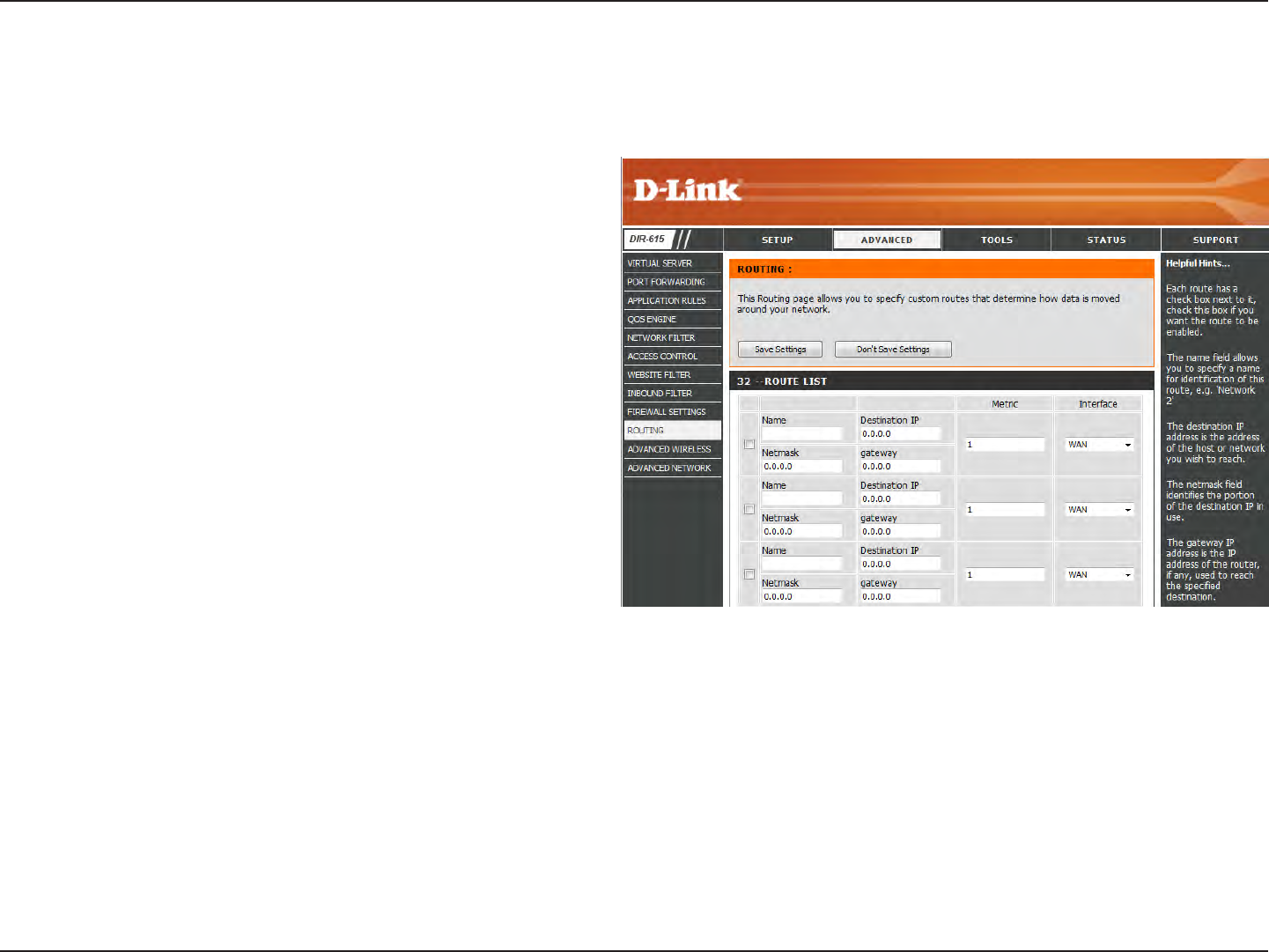
48D-Link DIR-615 User Manual
Section 3 - Conguration
Routing
This page allows you to specify custom routes that determine how data is moved around your network.
Routing List:
Metric:
Name:
Metric:
Interface:
Destination IP:
Netmask:
Gateway:
Each Route has a checkbox next to it, check the box of the route
you wish to enable.
The route metric is a value from 1 to 16 that indicates the cost
of using this route. A value 1 is the lowest cost and 15 is the
highest cost.
Specify a name for identication of this route.
The route metric is a value from 1 to 16 that indicates the cost
of using this route. A value 1 is the lowest cost and 15 is the
highest cost.
Select the interface which the IP packet must use to transit out
of the router when this route is used.
Enter the address of the host or network you wish to access.
This eld identies the portion of the destination IP in use.
The IP address of the router will be displayed here.
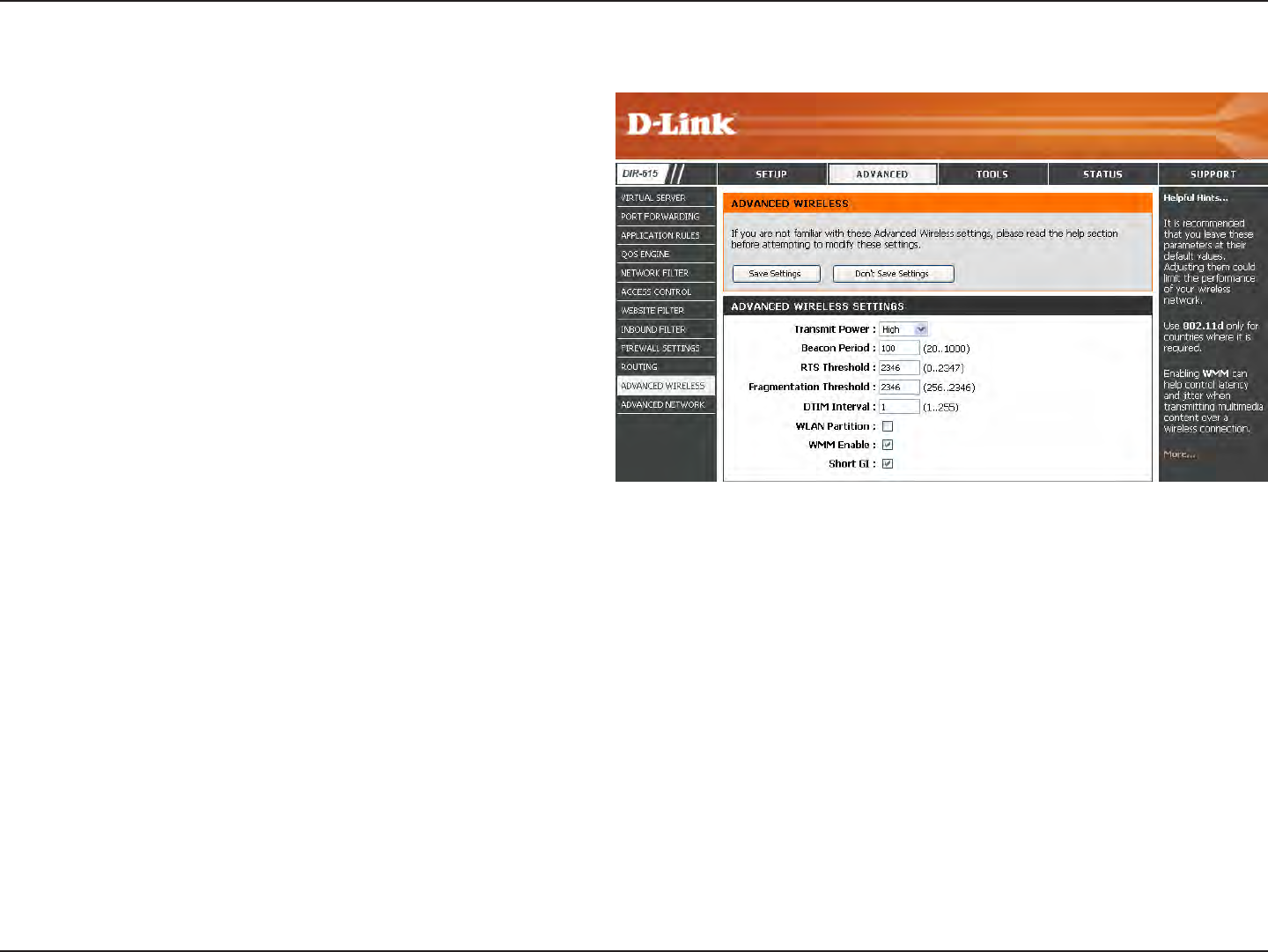
49D-Link DIR-615 User Manual
Section 3 - Conguration
Set the transmit power of the antennas.
Beacons are packets sent by an Access Point to synchronize a
wireless network. Specify a value. 100 is the default setting and
is recommended.
This value should remain at its default setting of 2346. If
inconsistent data ow is a problem, only a minor modication
should be made.
The fragmentation threshold, which is specified in bytes,
determines whether packets will be fragmented. Packets
exceeding the 2346 byte setting will be fragmented before
transmission. 2346 is the default setting.
(Delivery Trac Indication Message) 3 is the default setting. A
DTIM is a countdown informing clients of the next window for
listening to broadcast and multicast messages.
This enables 802.11d operation. 802.11d is a wireless specication developed to allow implementation of wireless networks in countries that cannot use the
802.11 standard. This feature should only be enabled if you are in a country that requires it.
WMM is QoS for your wireless network. This will improve the quality of video and voice applications for your wireless clients.
Check this box to reduce the guard interval time therefore increasing the data capacity. However, it’s less reliable and may create higher data loss.
Transmit Power:
Beacon Period:
RTS Threshold:
Fragmentation
Threshold:
DTIM Interval:
WLAN Partition:
WMM Enable:
Short GI:
Advanced Wireless Settings
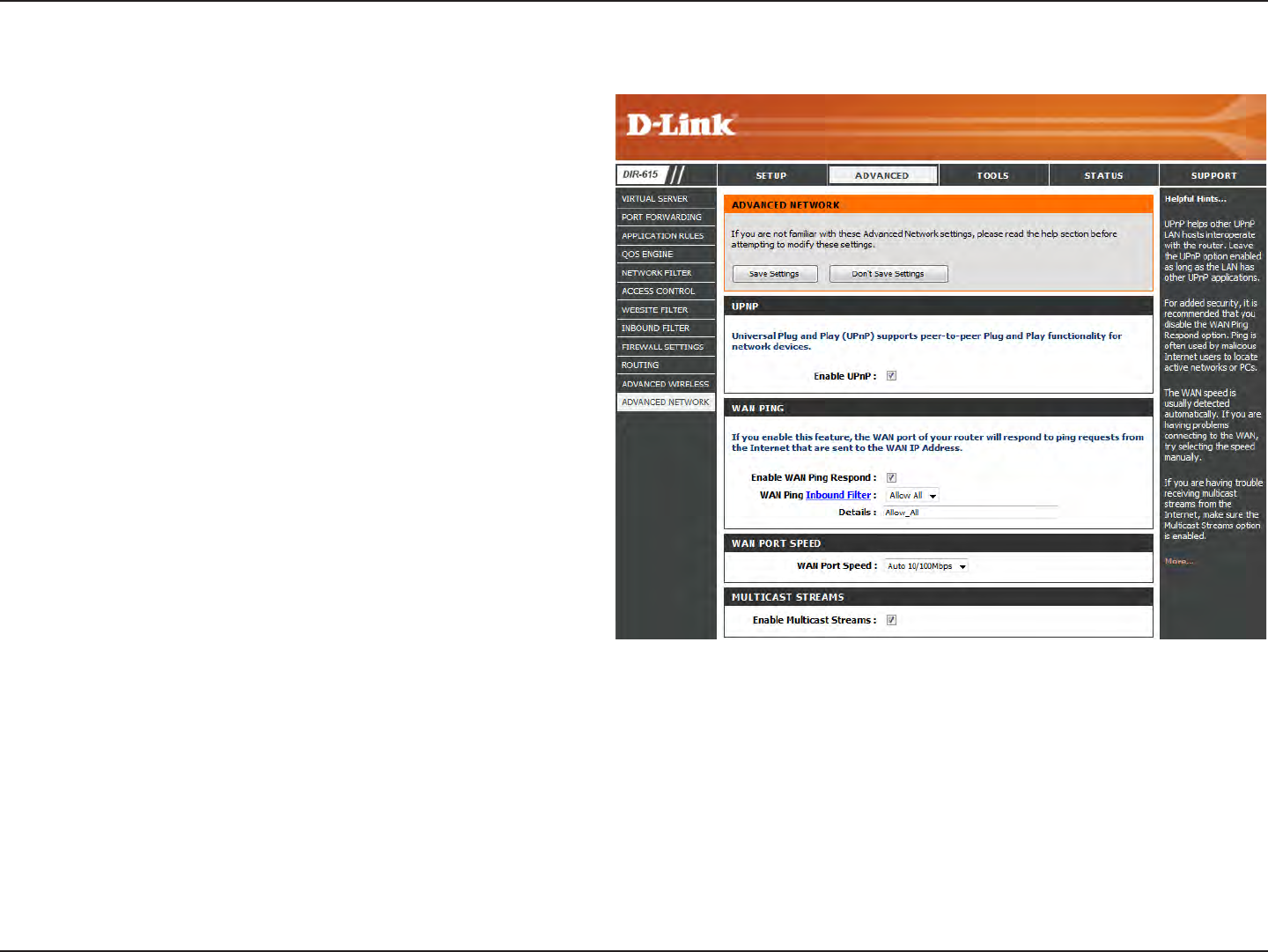
50D-Link DIR-615 User Manual
Section 3 - Conguration
UPnP
Internet Ping Block
Internet Port Speed
Multicast Streams
To use the Universal Plug and Play (UPnP™) feature click on
Enabled. UPNP provides compatibility with networking
equipment, software and peripherals.
Unchecking the box will not allow the DIR-615 to respond to
pings. Blocking the Ping may provide some extra security from
hackers. Check the box to allow the Internet port to be “pinged”.
You may set the port speed of the Internet port to 10Mbps,
100Mbps, or auto. Some older cable or DSL modems may
require you to set the port speed to 10Mbps.
Check the box to allow multicast trac to pass through the
router from the Internet.
UPnP Settings:
WAN Ping:
WAN Port Speed:
Multicast Streams:
Advanced Network Settings
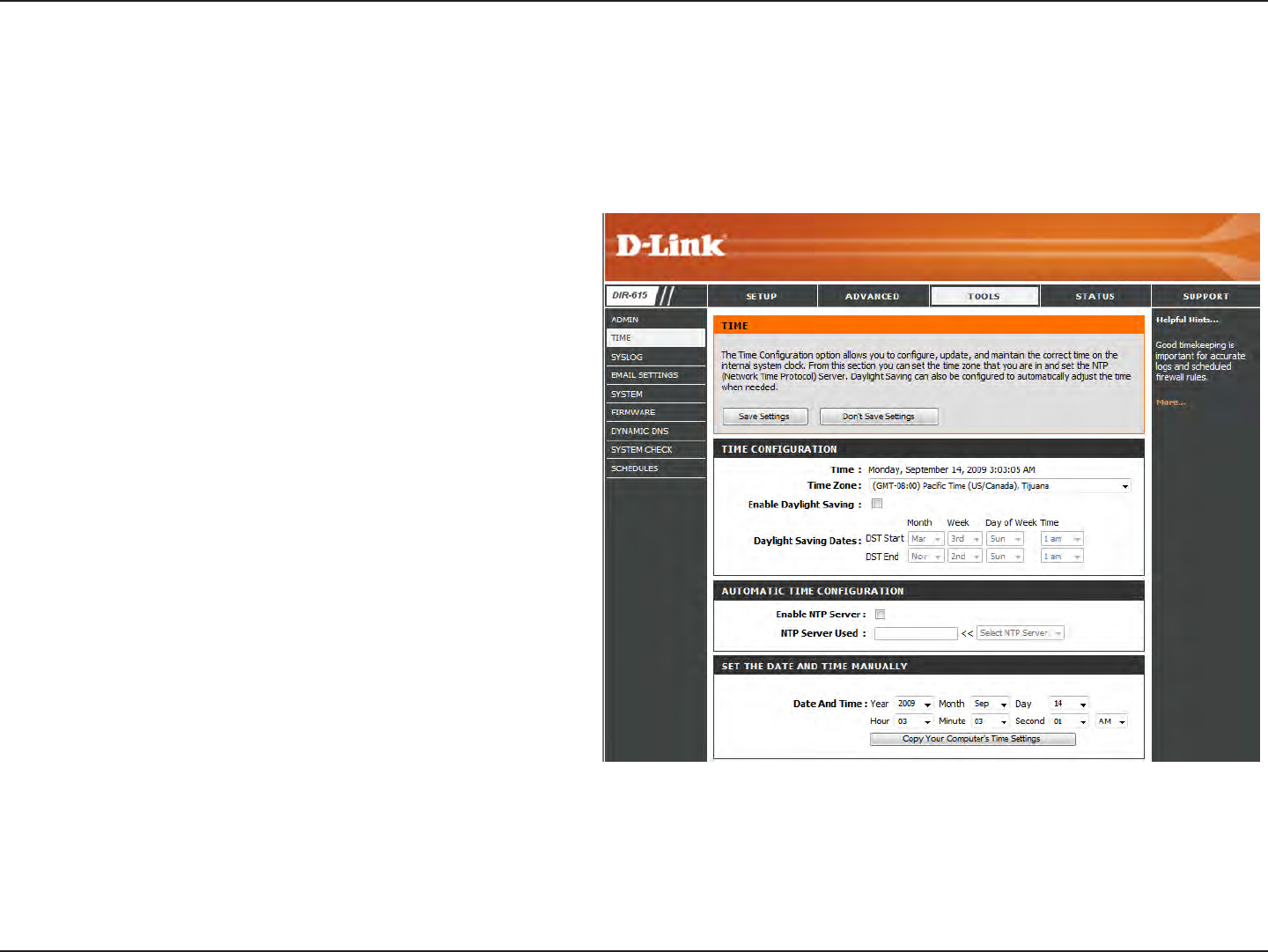
51D-Link DIR-615 User Manual
Section 3 - Conguration
Time Settings
Select the Time Zone from the drop-down menu.
To select Daylight Saving time manually, select enabled or
disabled, and enter a start date and an end date for daylight
saving time.
NTP is short for Network Time Protocol. NTP synchronizes
computer clock times in a network of computers. Check this
box to use a NTP server. This will only connect to a server on
the Internet, not a local server.
Enter the NTP server or select one from the drop down menu.
To manually input the time, enter the values in these elds
for the Year, Month, Day, Hour, Minute, and Second and then
click Set Time. You can also click Copy Your Computer’s
Time Settings.
Time Zone:
Daylight Saving:
Enable NTP
Server:
NTP Server
Used:
Manual:
The Time Conguration option allows you to congure, update, and maintain the correct time on the internal system clock. From this section you
can set the time zone that you are in and set the Time Server. Daylight Saving can also be congured to automatically adjust the time when needed.
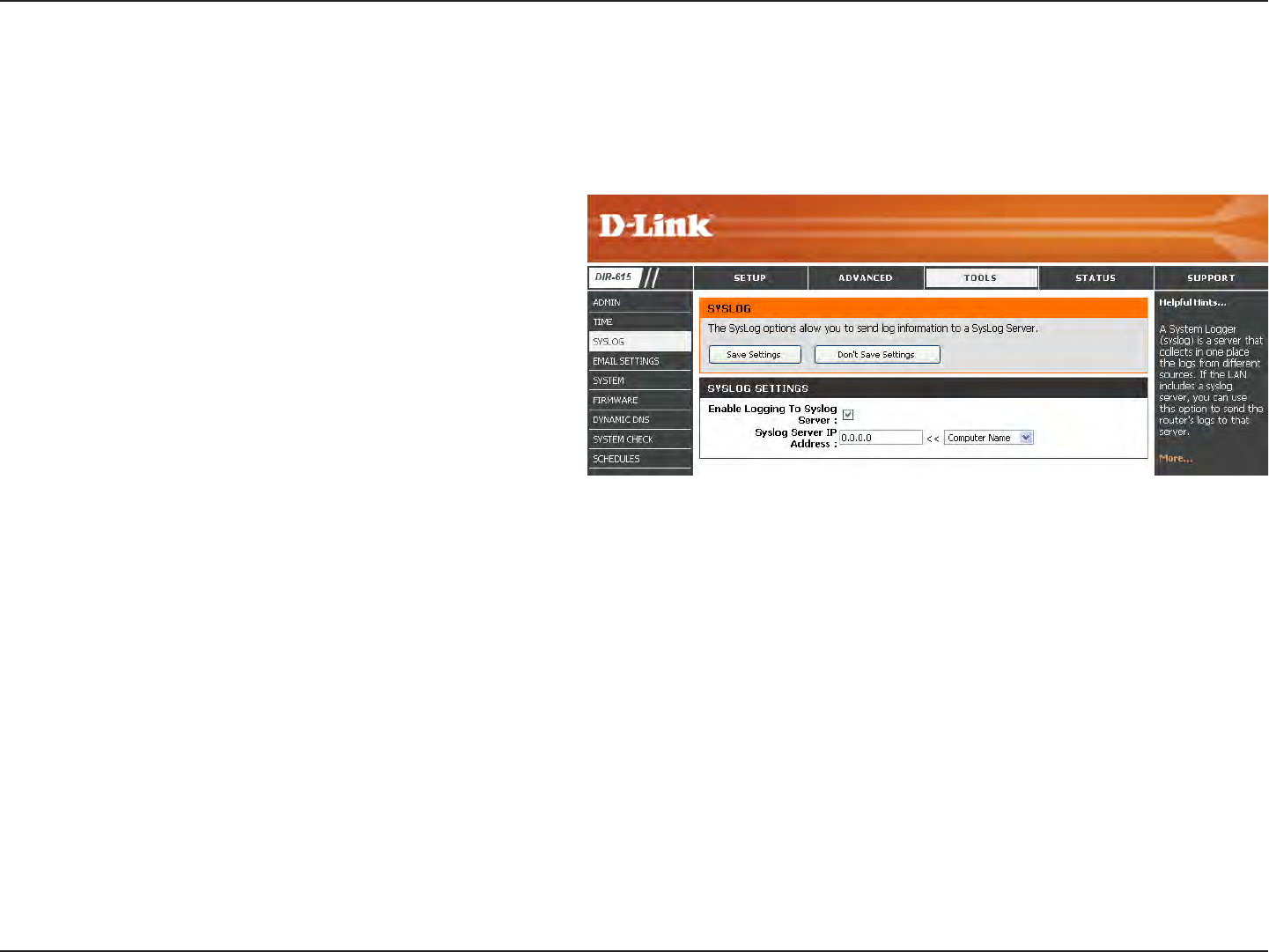
52D-Link DIR-615 User Manual
Section 3 - Conguration
SysLog
The Broadband Router keeps a running log of events and activities occurring on the Router. You may send these logs to a SysLog server on your
network.
Enable Logging to
SysLog Server:
SysLog Server IP
Address:
Check this box to send the router logs to a SysLog Server.
The address of the SysLog server that will be used to send
the logs. You may also select your computer from the drop-
down menu (only if receiving an IP address from the router
via DHCP).
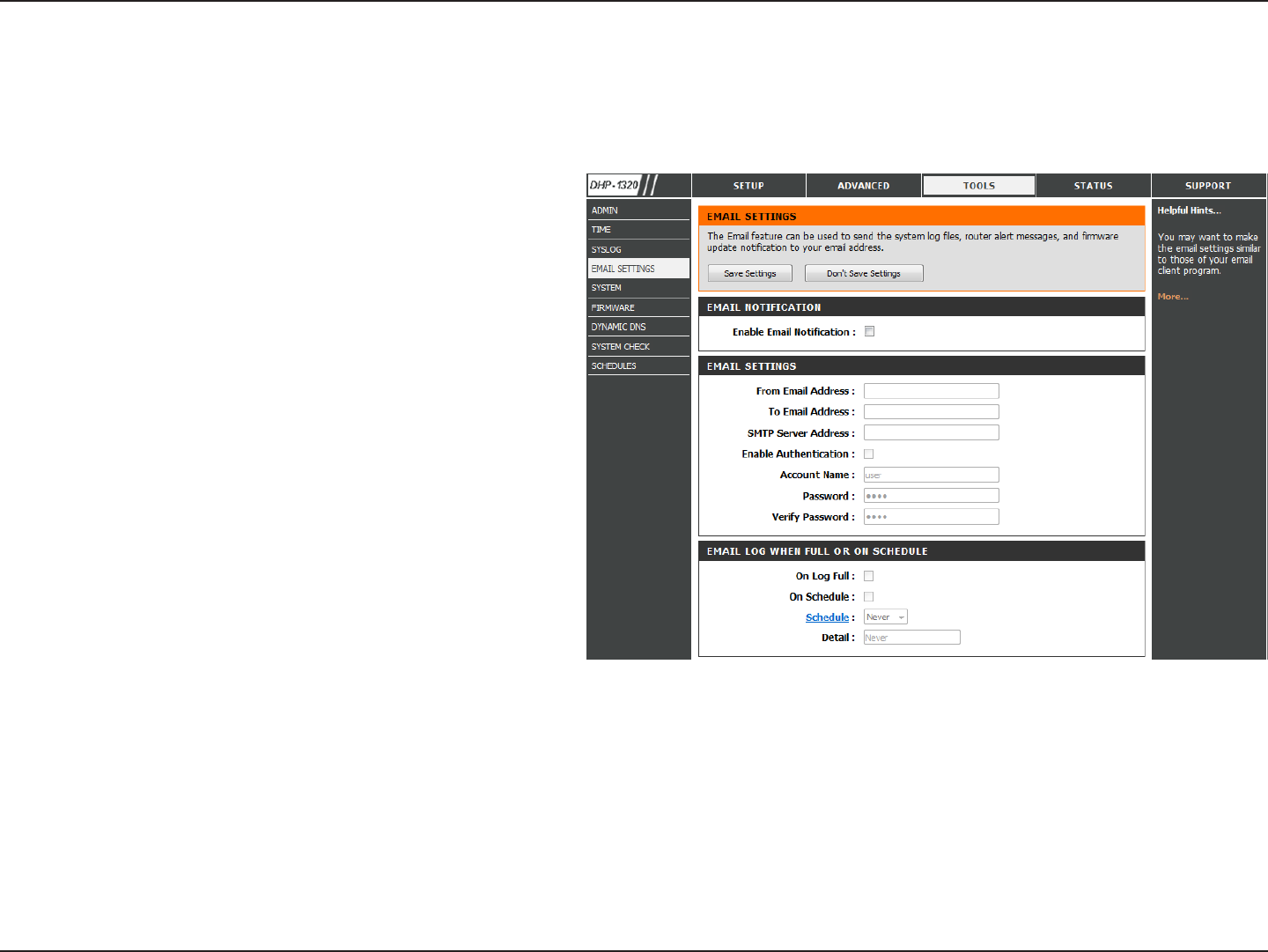
53D-Link DIR-615 User Manual
Section 3 - Conguration
E-mail Settings
The Email feature can be used to send the system log les, router alert messages, and rmware update notication to your e-mail address.
Enable Email
Notication:
From Email
Address:
To Email Address:
SMTP Server
Address:
Enable
Authentication:
Account Name:
Password:
On Log Full:
On Schedule:
Schedule:
When this option is enabled, router activity logs are e-mailed
to a designated e-mail address.
This e-mail address will appear as the sender when you
receive a log le or rmware upgrade notication via e-mail.
Enter the e-mail address where you want the email sent.
Enter the SMTP server address for sending e-mail. If your
SMTP server requires authentication, select this option.
Check this box if your SMTP server requires authentication.
Enter your account for sending e-mail.
Enter the password associated with the account. Re-type
the password associated with the account.
When this option is selected, logs will be sent via e-mail
when the log is full.
Selecting this option will send the logs via e-mail according
to schedule.
This option is enabled when On Schedule is selected. You
can select a schedule from the list of dened schedules. To
create a schedule, go to Tools > Schedules.
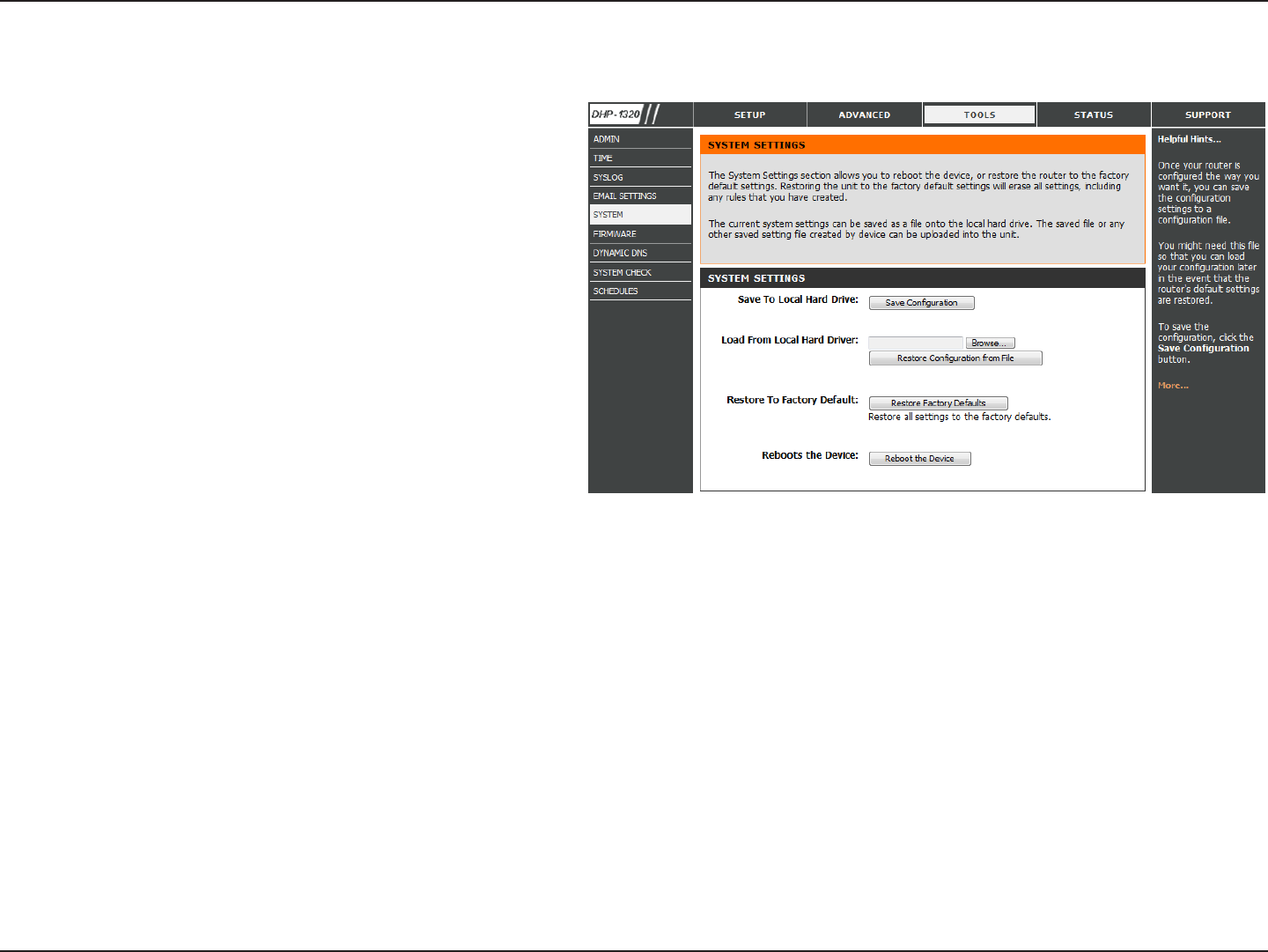
54D-Link DIR-615 User Manual
Section 3 - Conguration
Use this option to save the current router conguration
settings to a le on the hard disk of the computer you are
using. First, click the Save button. You will then see a le
dialog, where you can select a location and le name for
the settings.
Use this option to load previously saved router conguration
settings. First, use the Browse control to nd a previously save
le of conguration settings. Then, click the Load button to
transfer those settings to the router.
This option will restore all conguration settings back to
the settings that were in eect at the time the router was
shipped from the factory. Any settings that have not been
saved will be lost, including any rules that you have created.
If you want to save the current router conguration settings,
use the Save button above.
Click to reboot the router.
Save Settings to
Local Hard Drive:
Load Settings from
Local Hard Drive:
Restore to Factory
Default Settings:
Reboot Device:
System Settings
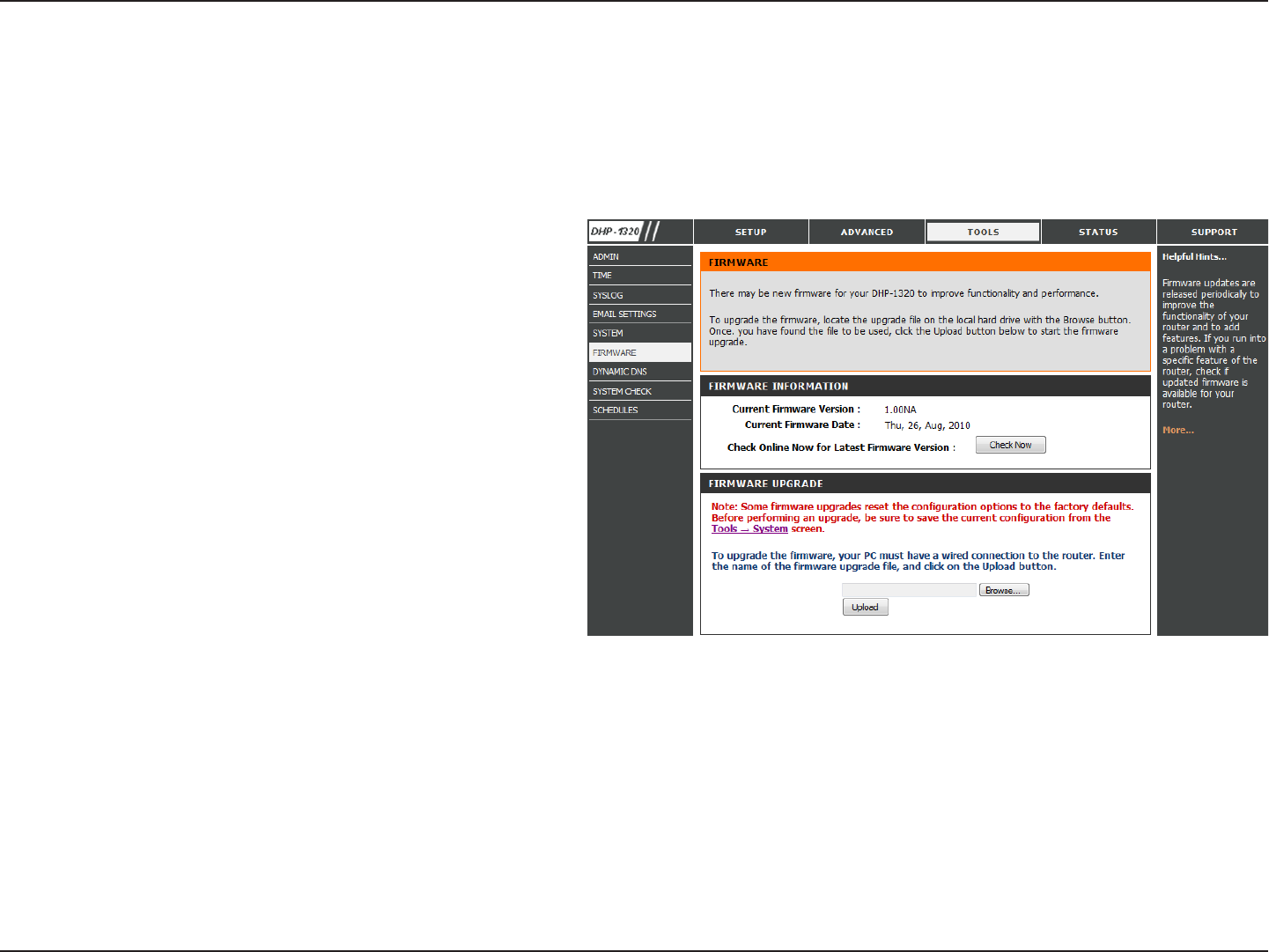
55D-Link DIR-615 User Manual
Section 3 - Conguration
Click on the Check Now button to nd out if there is an
updated rmware or language pack version; if so, download
the new rmware to your hard drive.
To remove the language pack, click Remove.
Note: The Remove button will show up after a language pack
is uploaded.
After you have downloaded the new rmware, click Browse
to locate the rmware update on your hard drive. Click
Upload to complete the rmware upgrade.
To upgrade the language pack, follow these steps:
1. Click the Browse button to locate the D-Link language
pack upgrade le on your computer.
Note: Language pack le extension will be *.lng
2. Once you have found the le, click the Upload button to
begin the language pack upgrade process. This can take
a minute or more.
3. Wait for the router to reboot. This process can take about
75 seconds.
Firmware
Information:
Remove:
Firmware
Upgrade:
Language Pack
Upgrade:
Firmware
You can upgrade the rmware of the Router here. Make sure the rmware you want to use is on the local hard drive of the computer. Click on Browse
to locate the rmware le to be used for the update. Please check the D-Link support site for rmware updates at http://support.dlink.com. You
can download rmware upgrades to your hard drive from the D-Link support site.
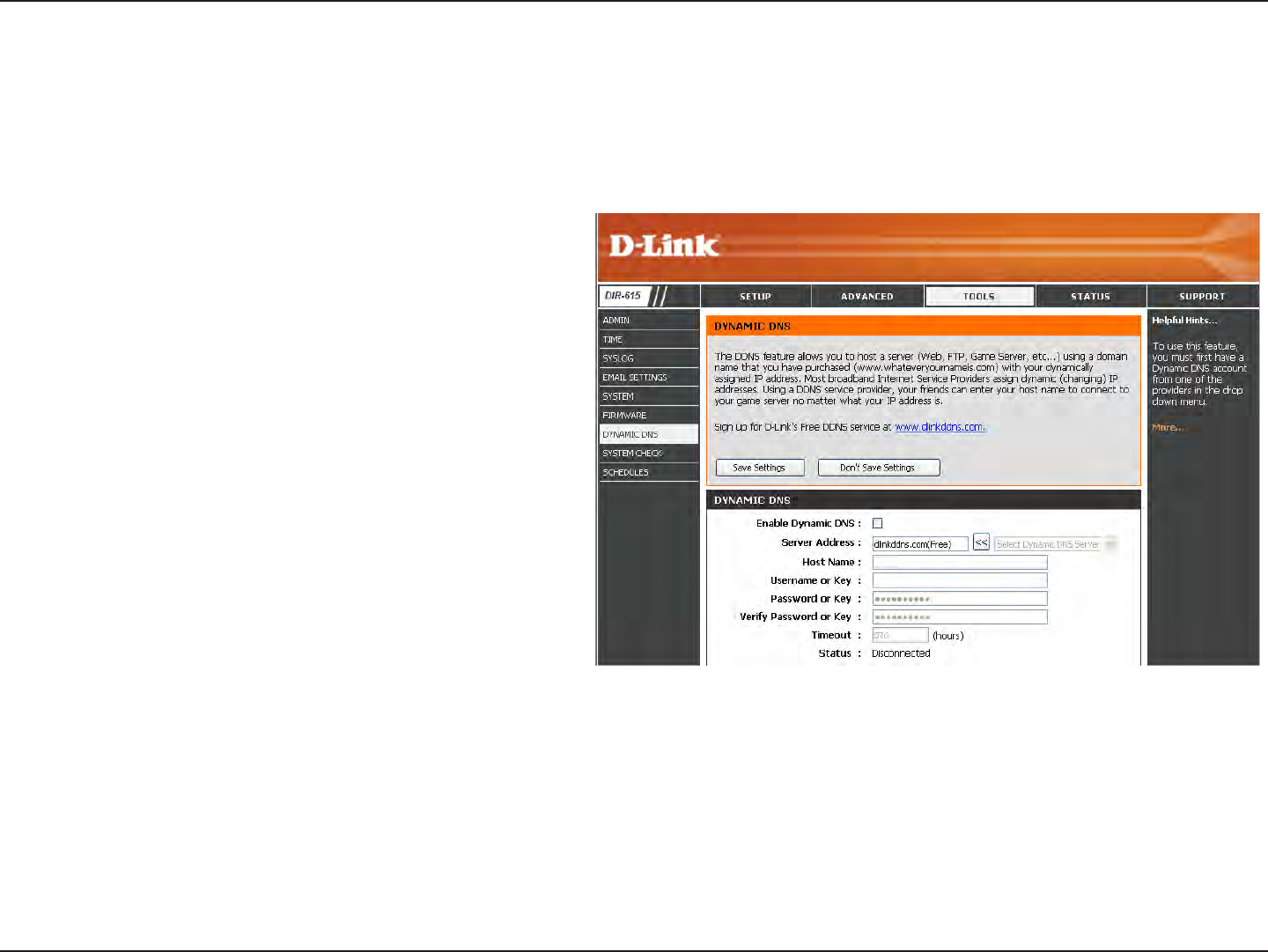
56D-Link DIR-615 User Manual
Section 3 - Conguration
Dynamic Domain Name System is a method of keeping a
domain name linked to a changing IP Address. Check the
box to enable DDNS.
Choose your DDNS provider from the drop down menu.
Enter the Host Name that you registered with your DDNS
service provider.
Enter the Username for your DDNS account.
Enter the Password for your DDNS account.
Enter a time (in hours).
Displays the current connection status to your DDNS server.
DDNS:
Server Address:
Host Name:
Username or Key:
Password or Key:
Timeout:
Status:
DDNS
The DDNS feature allows you to host a server (Web, FTP, Game Server, etc…) using a domain name that you have purchased (www.whateveryournameis.
com) with your dynamically assigned IP address. Most broadband Internet Service Providers assign dynamic (changing) IP addresses. Using a DDNS
service provider, your friends can enter in your domain name to connect to your server no matter what your IP address is.
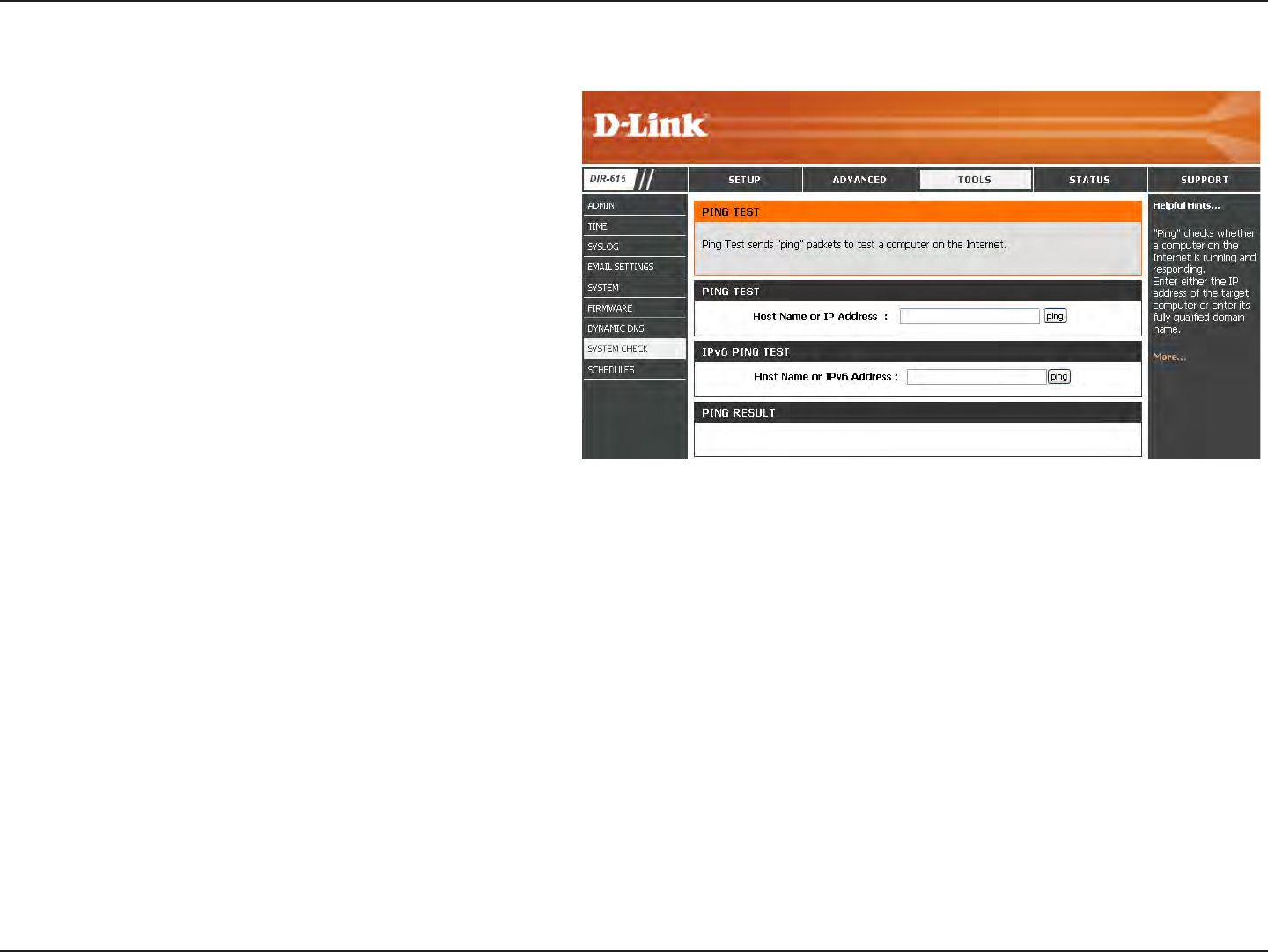
57D-Link DIR-615 User Manual
Section 3 - Conguration
System Check
The Ping Test is used to send Ping packets to test if a
computer is on the Internet. Enter the IP Address that you
wish to Ping, and click Ping.
The results of your ping attempts will be displayed here.
Ping Test:
Ping Results:
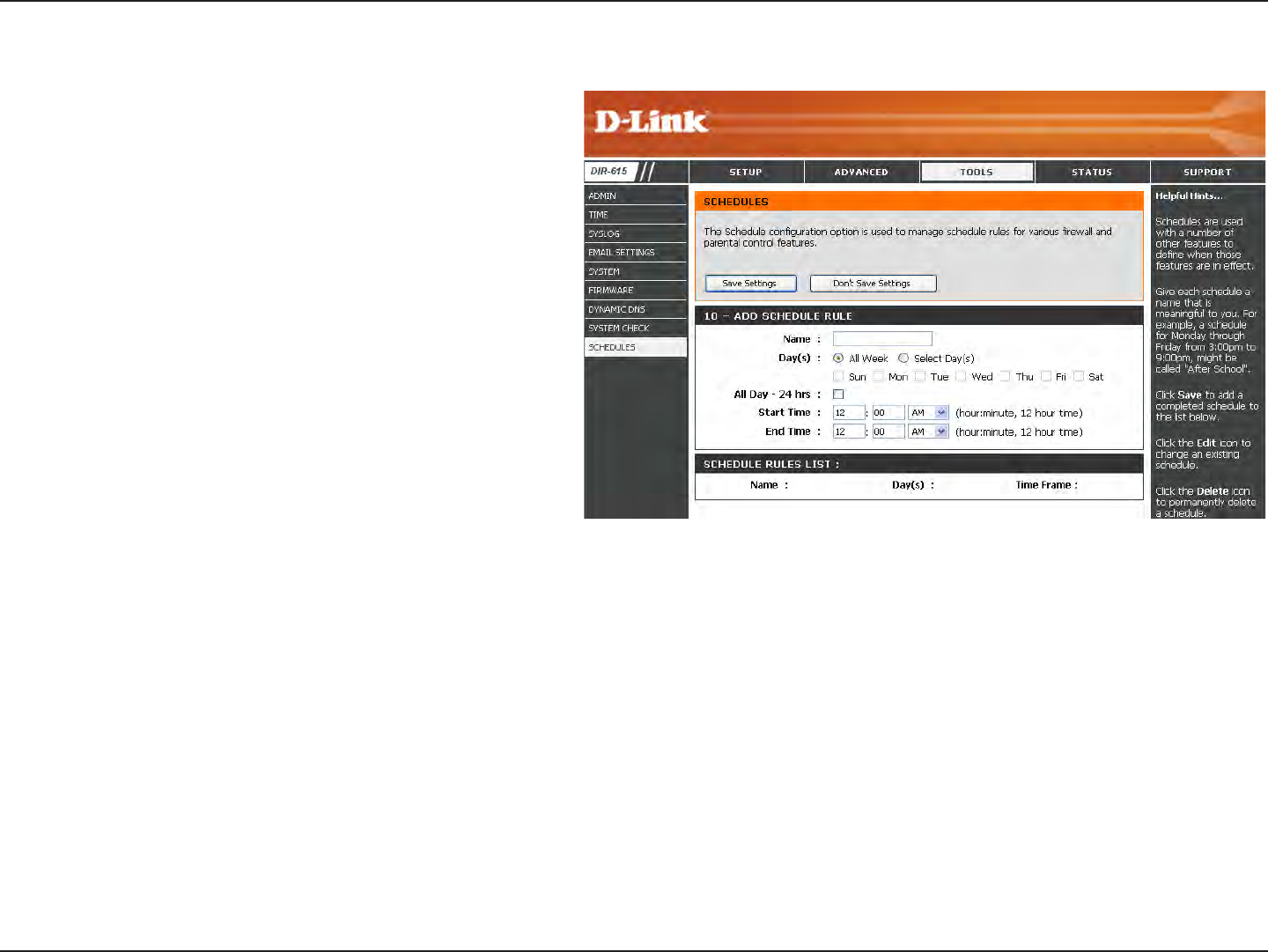
58D-Link DIR-615 User Manual
Section 3 - Conguration
Enter a name for your new schedule.
Select a day, a range of days, or All Week to include every
day.
Check All Day - 24hrs or enter a start and end time for
your schedule.
Click Save to save your schedule. You must click Save
Settings at the top for your schedules to go into eect.
The list of schedules will be listed here. Click the Edit icon
to make changes or click the Delete icon to remove the
schedule.
Name:
Days:
Time:
Save:
Schedule Rules
List:
Schedules
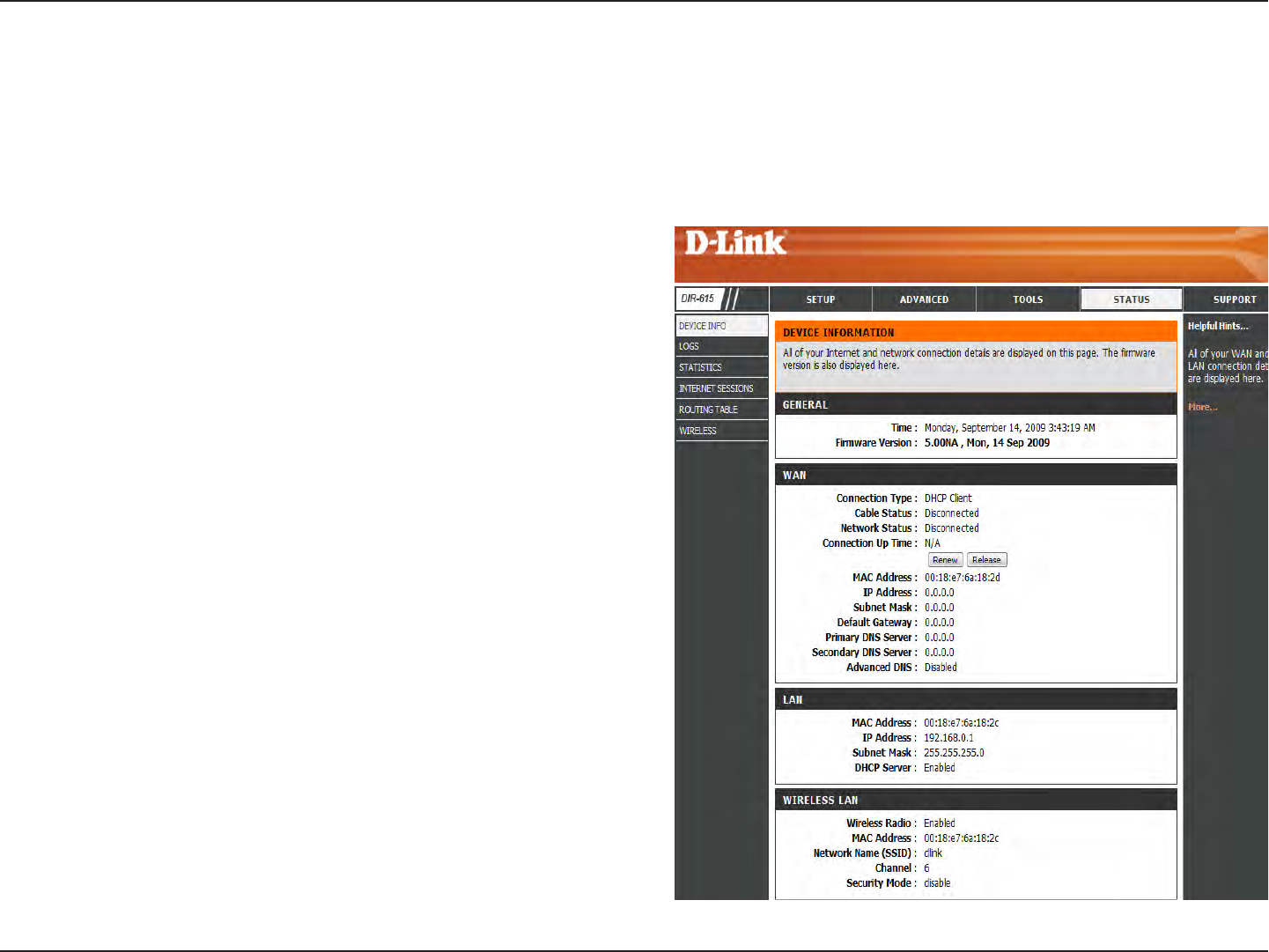
59D-Link DIR-615 User Manual
Section 3 - Conguration
This page displays the current information for the DIR-615. It will display the LAN, WAN (Internet), and Wireless information.
If your Internet connection is set up for a Dynamic IP address then a Release button and a Renew button will be displayed. Use Release to disconnect
from your ISP and use Renew to connect to your ISP.
If your Internet connection is set up for PPPoE, a Connect button and a
Disconnect button will be displayed. Use Disconnect to drop the PPPoE
connection and use Connect to establish the PPPoE connection.
See the following page for more information.
Device Information
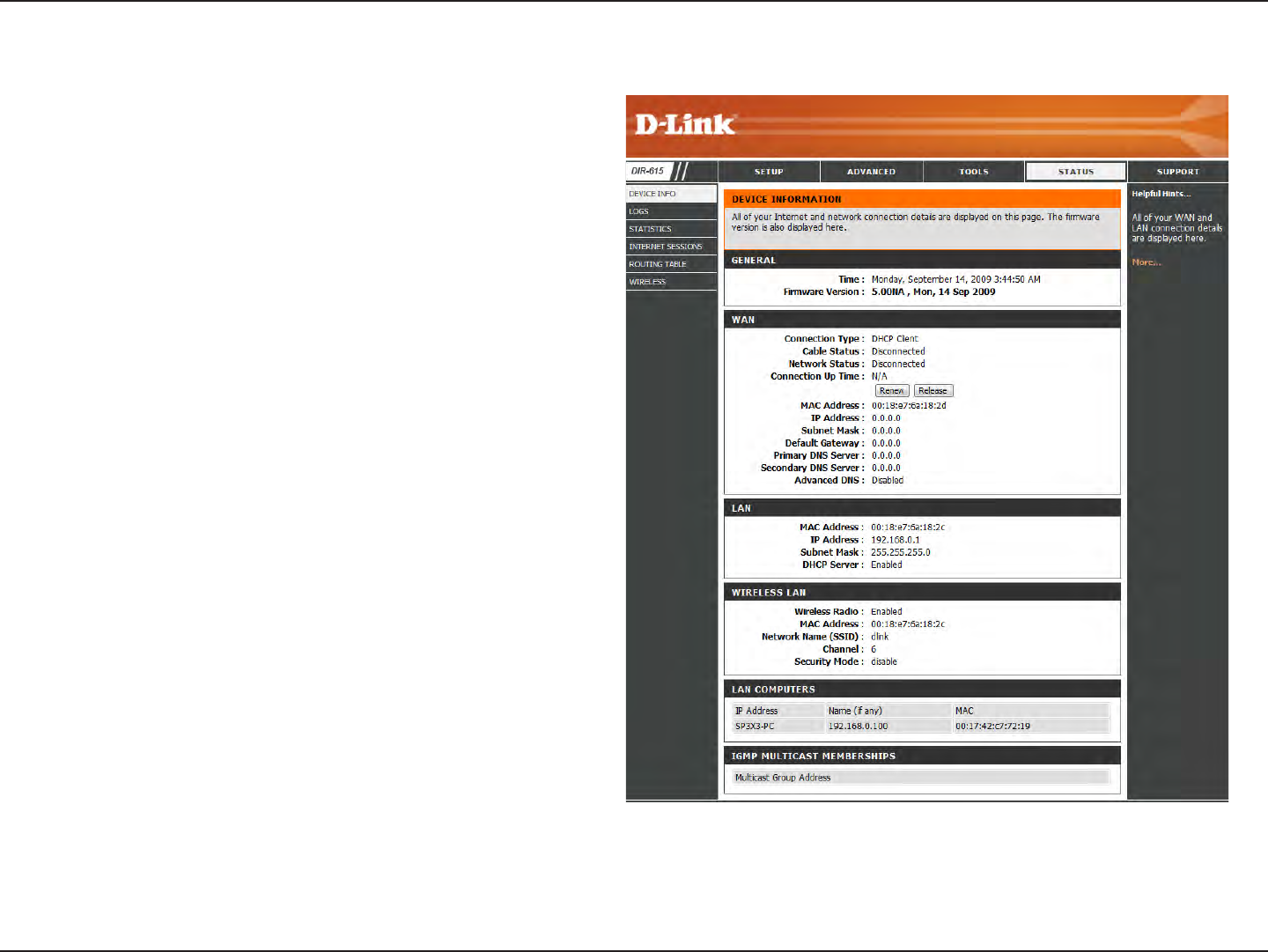
60D-Link DIR-615 User Manual
Section 3 - Conguration
Displays the router’s time and rmware version.
Displays the MAC address and the public IP settings for the router.
Displays the MAC address and the private (local) IP settings for
the router.
Displays the wireless MAC address and your wireless settings
such as SSID and Channel.
Displays computers and devices that are connected to the router
via Ethernet and that are receiving an IP address assigned by the
router (DHCP).
Displays the Multicast Group IP Address.
General:
WAN:
LAN:
Wireless LAN:
LAN Computers:
IGMP Multicast
Memberships:
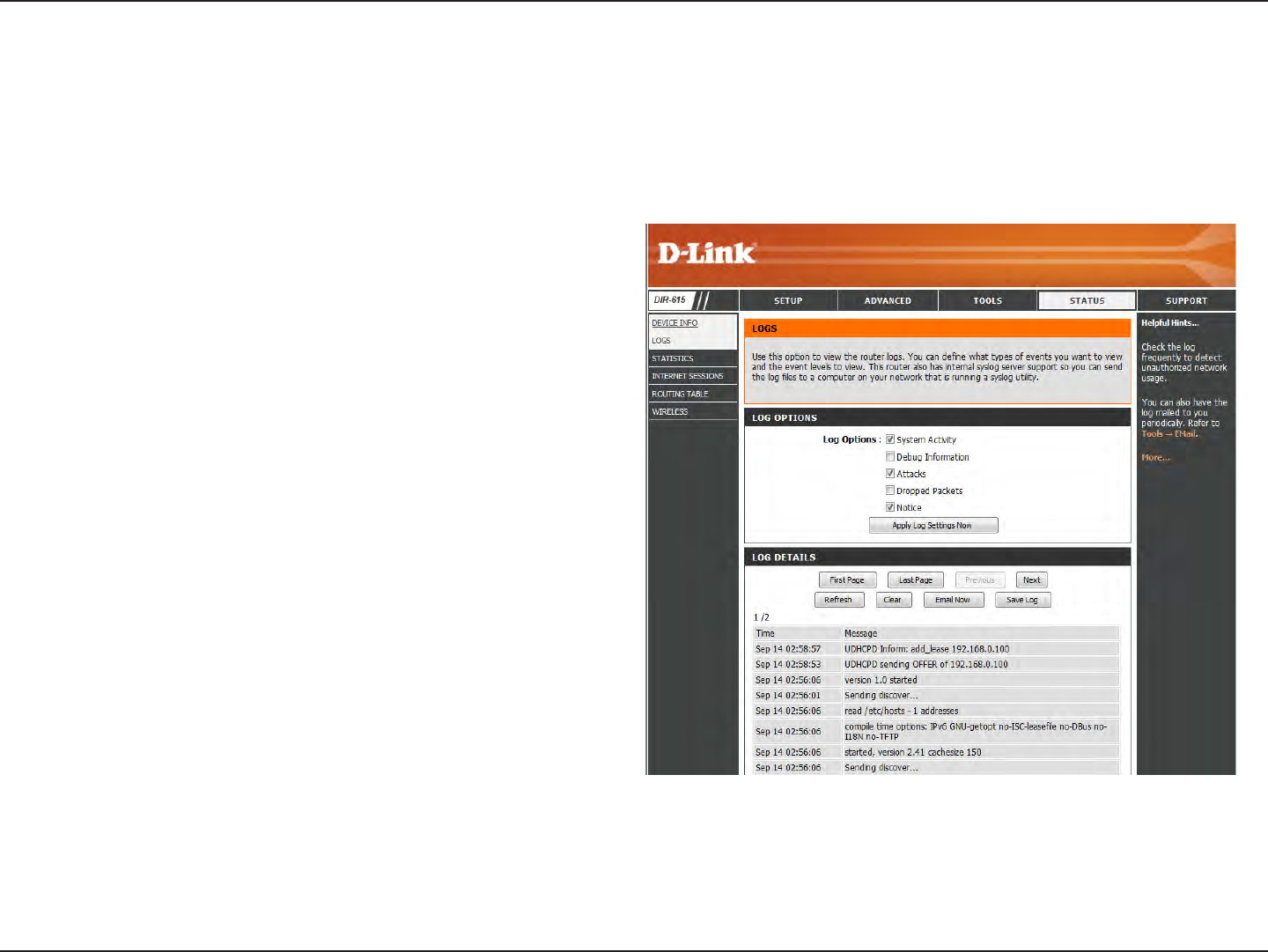
61D-Link DIR-615 User Manual
Section 3 - Conguration
Log
What to View:
View Levels:
Apply Log Settings:
Refresh:
Clear:
Email Now:
Save Log:
You can select the types of messages that you want to display from
the log. Firewall & Security, System, and Router Status messages
can be selected.
There are three levels of message importance: Informational,
Warning, and Critical. Select the levels that you want displayed in
the log.
Will lter the log results so that only the selected options appear.
Updates the log details on the screen so it displays any recent
activity.
Clears all of the log contents.
This option will send a copy of the router log to the e-mail address
congured in the Tools > Email Settings screen.
This option will save the router to a log le on your computer.
The router automatically logs (records) events of possible interest in it’s internal memory. If there isn’t enough internal memory for all events, logs
of older events are deleted but logs of the latest events are retained. The Logs option allows you to view the router logs. You can dene what types
of events you want to view and the level of the events to view. This router also has external Syslog Server support so you can send the log les to
a computer on your network that is running a Syslog utility.
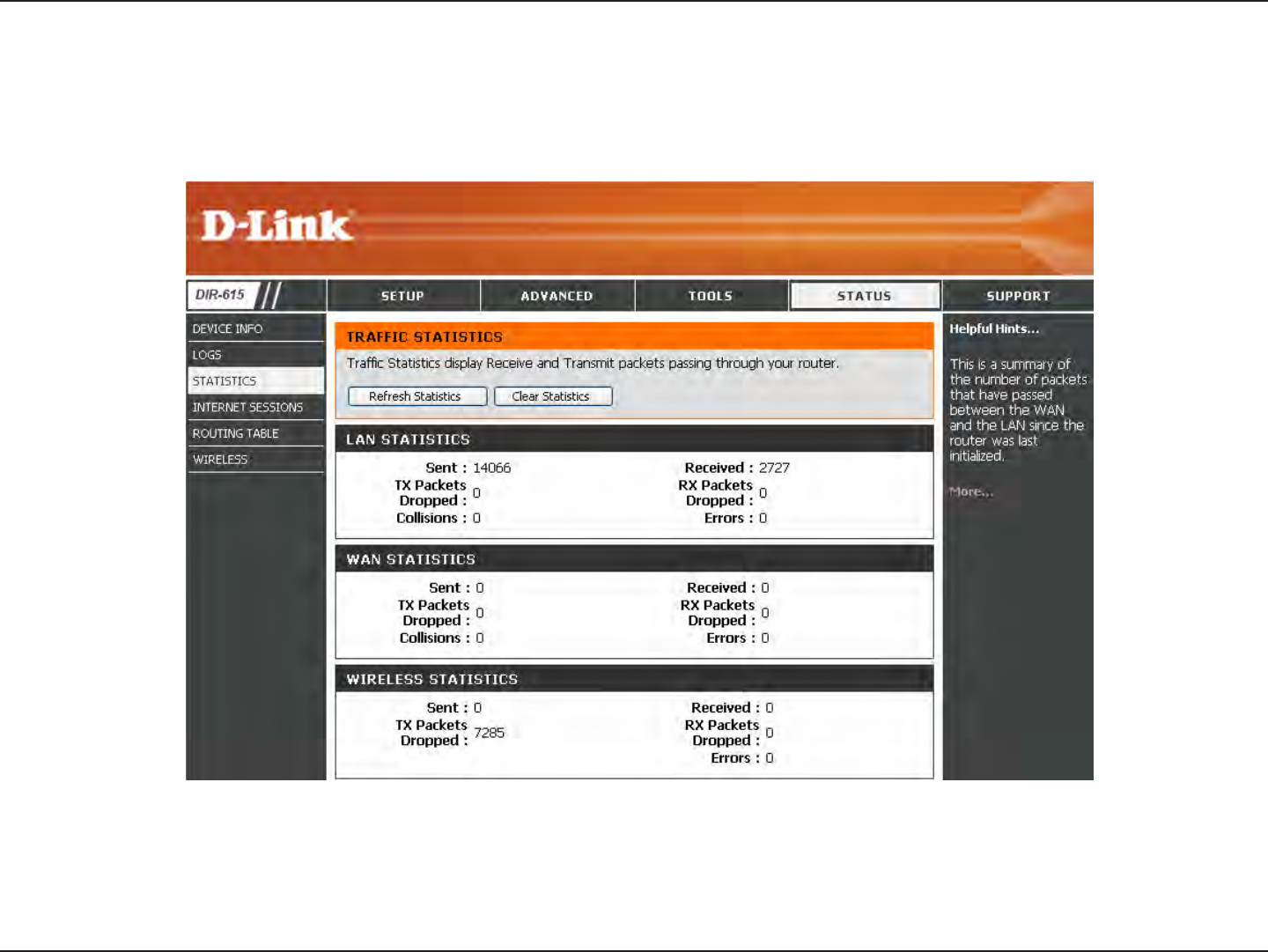
62D-Link DIR-615 User Manual
Section 3 - Conguration
Statistics
The screen below displays the Trac Statistics. Here you can view the amount of packets that pass through the DIR-615 on both the Internet and the LAN
ports. The trac counter will reset if the device is rebooted.
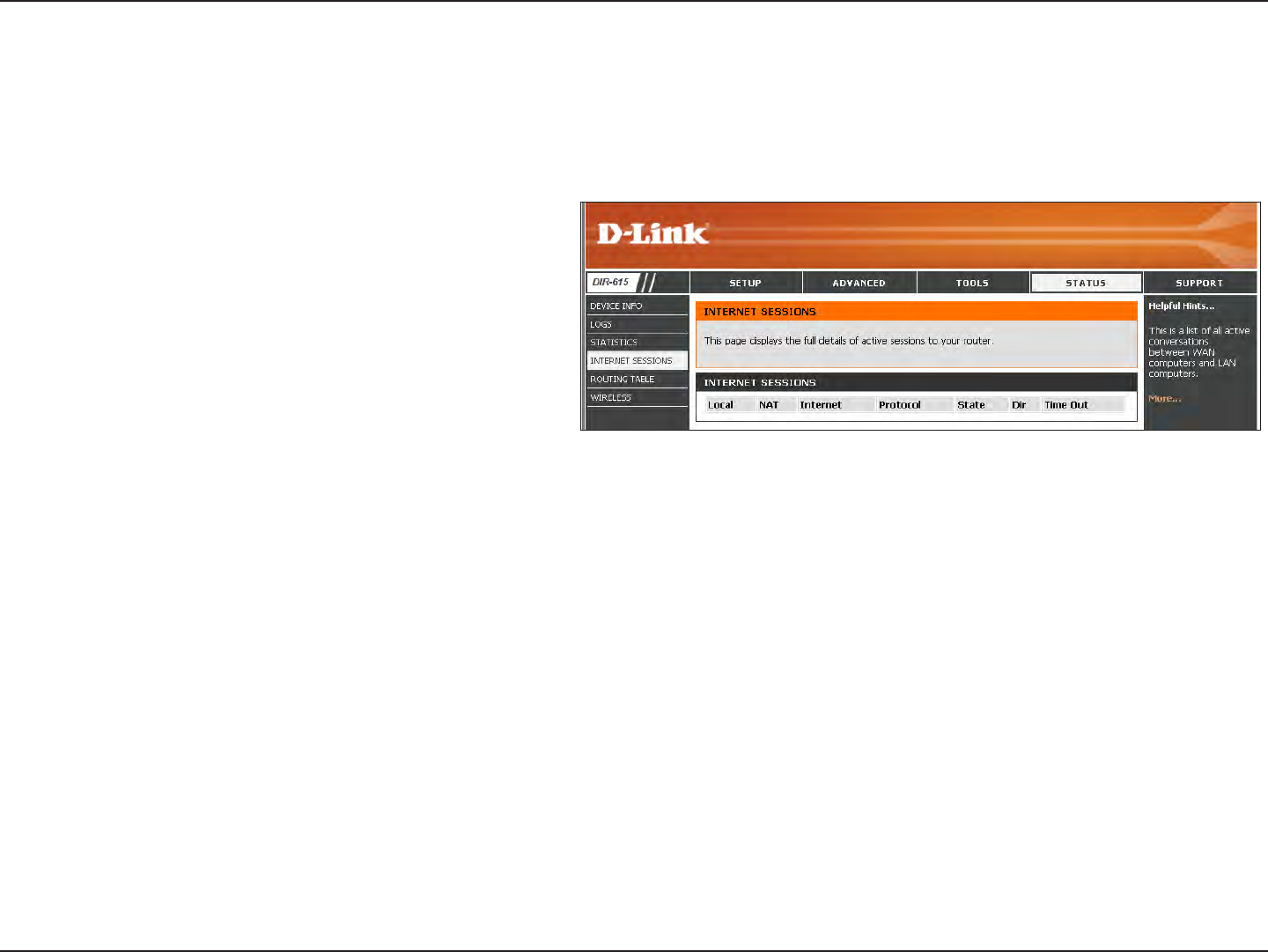
63D-Link DIR-615 User Manual
Section 3 - Conguration
Internet Sessions
The Internet Sessions page displays full details of active Internet sessions through your router. An Internet session is a conversation between a
program or application on a LAN-side computer and a program or application on a WAN-side computer.
Local:
NAT:
Internet:
Protocol:
State:
Dir:
Priority:
The IP address and, where appropriate, port number of the
local application.
The port number of the LAN-side application as viewed by
the WAN-side application.
The IP address and, where appropriate, port number of the
application on the Internet.
The communications protocol used for the conversation.
State for sessions that use the TCP protocol:
NO: None -- This entry is used as a placeholder for a future connection that may occur.
SS: SYN Sent -- One of the systems is attempting to start a connection.
EST: Established -- the connection is passing data.
FW: FIN Wait -- The client system has requested that the connection be stopped.
CW: Close Wait -- The server system has requested that the connection be stopped.
TW: Time Wait -- Waiting for a short time while a connection that was in FIN Wait is fully closed.
LA: Last ACK -- Waiting for a short time while a connection that was in Close Wait is fully closed.
CL: Closed -- The connection is no longer active but the session is being tracked in case there are any retransmitted packets still pending.
The direction of initiation of the conversation:
Out - Initiated from LAN to WAN.
In - Initiated from WAN to LAN.
The preference given to outbound packets of this conversation by the QoS Engine logic. Smaller numbers represent higher priority.

64D-Link DIR-615 User Manual
Section 3 - Conguration
Time Out: The number of seconds of idle time until the router considers the session terminated. The initial value of Time Out depends on the type and state of the connection.
300 seconds - UDP connections.
240 seconds - Reset or closed TCP connections. The connection does not close instantly so that lingering packets can pass or the connection can be
re-established.
7800 seconds - Established or closing TCP connections.
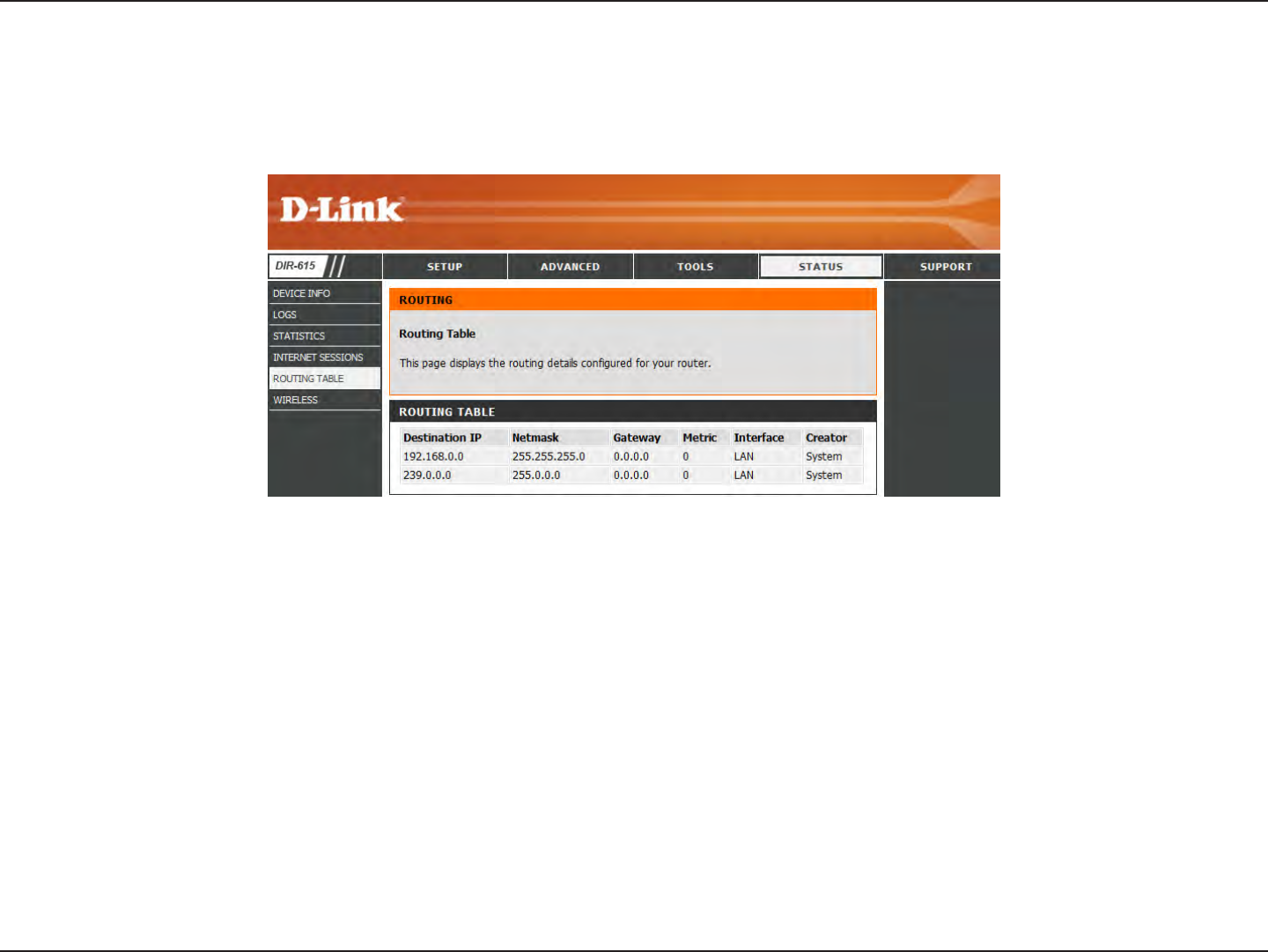
65D-Link DIR-615 User Manual
Section 3 - Conguration
Routing Table
This page displays the routing details congured for your router.
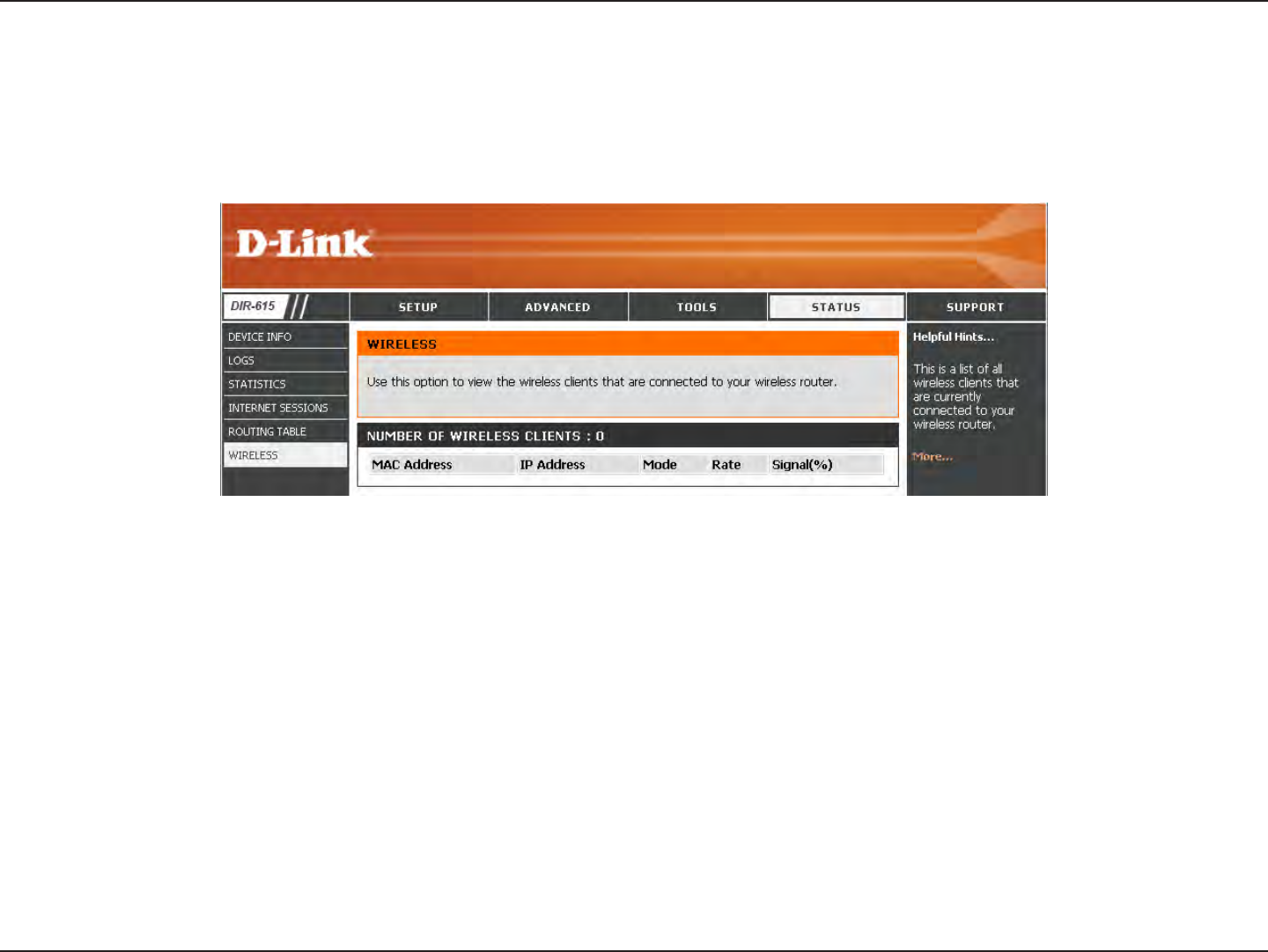
66D-Link DIR-615 User Manual
Section 3 - Conguration
The wireless client table displays a list of current connected wireless clients. This table also displays the connection time and MAC address of the
connected wireless clients.
Wireless
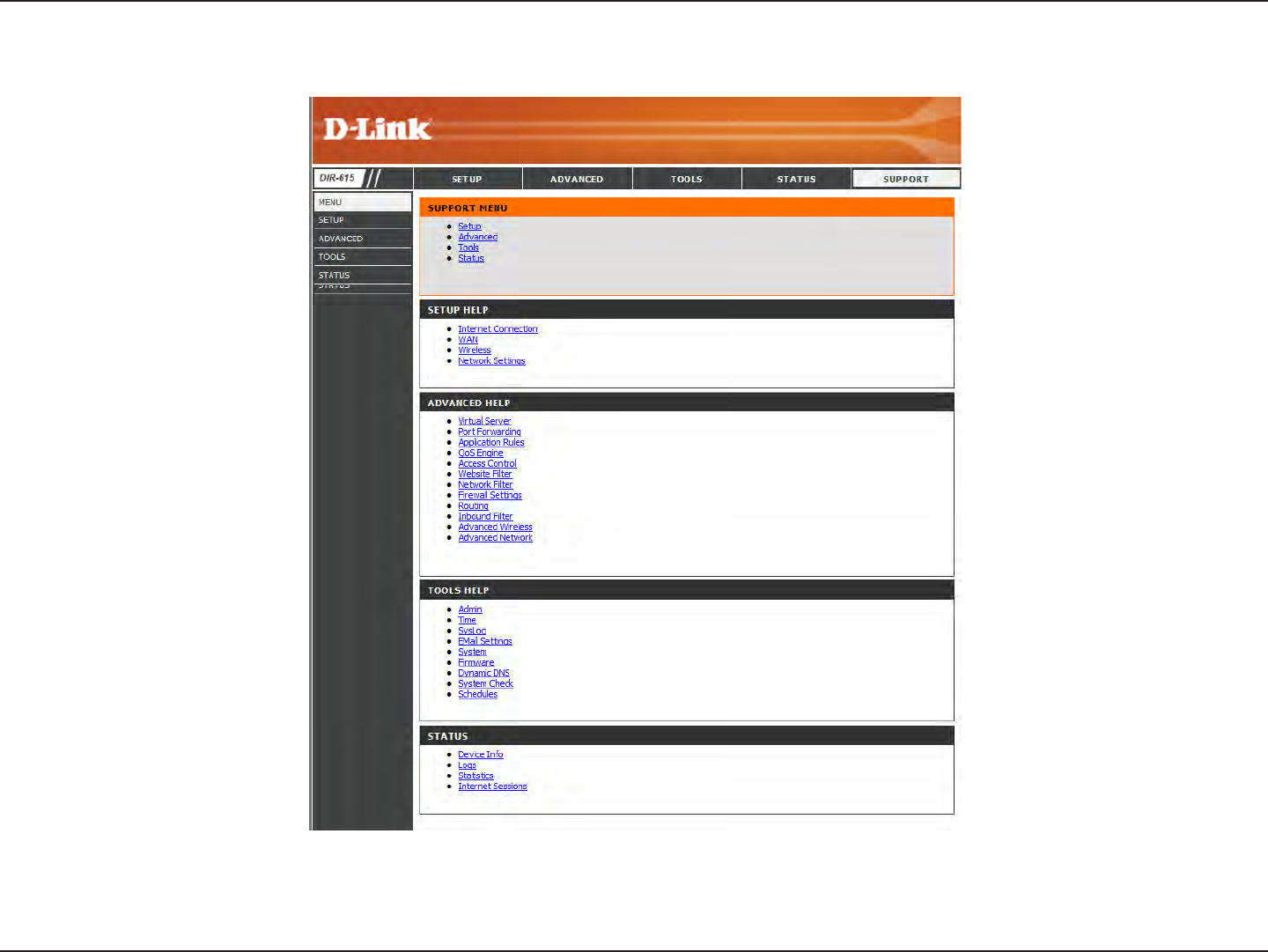
67D-Link DIR-615 User Manual
Section 3 - Conguration
Support

68D-Link DIR-615 User Manual
Section 4 - Security
Wireless Security
This section will show you the dierent levels of security you can use to protect your data from intruders. The DIR-615 oers the following types
of security:
• WPA2 (Wi-Fi Protected Access 2) • WPA2-PSK(Pre-Shared Key)
• WPA (Wi-Fi Protected Access) • WPA-PSK (Pre-Shared Key)
What is WPA?
WPA, or Wi-Fi Protected Access, is a Wi-Fi standard that was designed to improve the security features of WEP (Wired Equivalent Privacy).
The 2 major improvements over WEP:
• Improved data encryption through the Temporal Key Integrity Protocol (TKIP). TKIP scrambles the keys using a hashing algorithm
and, by adding an integrity-checking feature, ensures that the keys haven’t been tampered with. WPA2 is based on 802.11i and
uses Advanced Encryption Standard (AES) instead of TKIP.
• User authentication, which is generally missing in WEP, through the extensible authentication protocol (EAP). WEP regulates access
to a wireless network based on a computer’s hardware-specic MAC address, which is relatively simple to be snied out and stolen.
EAP is built on a more secure public-key encryption system to ensure that only authorized network users can access the network.
WPA-PSK/WPA2-PSK uses a passphrase or key to authenticate your wireless connection. The key is an alpha-numeric password between 8 and 63
characters long. The password can include symbols (!?*&_) and spaces. This key must be the exact same key entered on your wireless router or
access point.
WPA/WPA2 incorporates user authentication through the Extensible Authentication Protocol (EAP). EAP is built on a more secure public key encryption
system to ensure that only authorized network users can access the network.
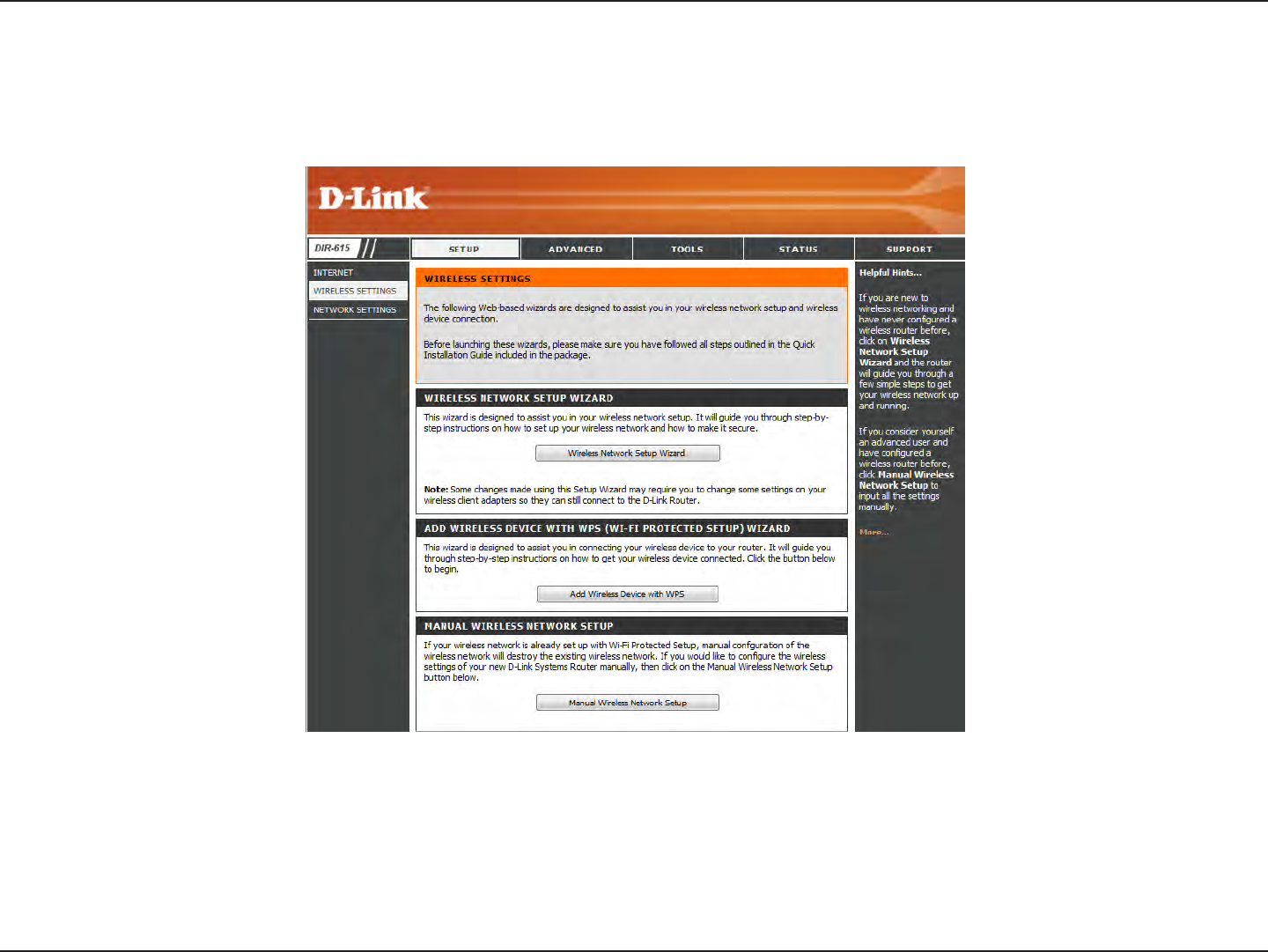
69D-Link DIR-615 User Manual
Section 4 - Security
Wireless Network Setup Wizard
To run the security wizard, browse to the Setup page and then click the Wireless Network Setup Wizard button.
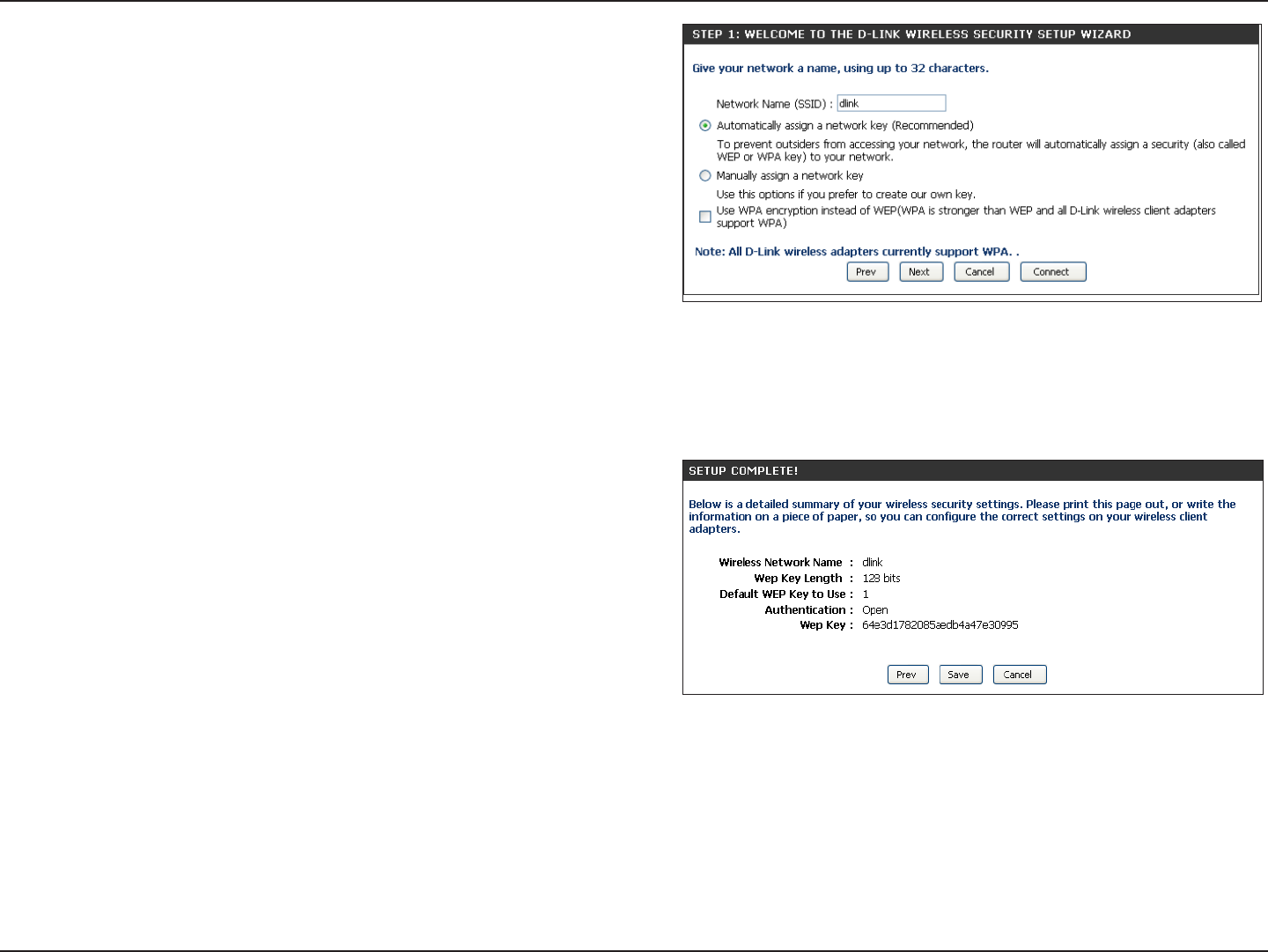
70D-Link DIR-615 User Manual
Section 4 - Security
Enter the SSID (Service Set Identier). The SSID is the name of your wireless
network. Create a name using up to 32 characters. The SSID is case-sensitive.
Select Automatically and click Next.
Once this screen appears, the setup is complete. You will be given a detailed
summary of your wireless security settings.
Click Save to continue.
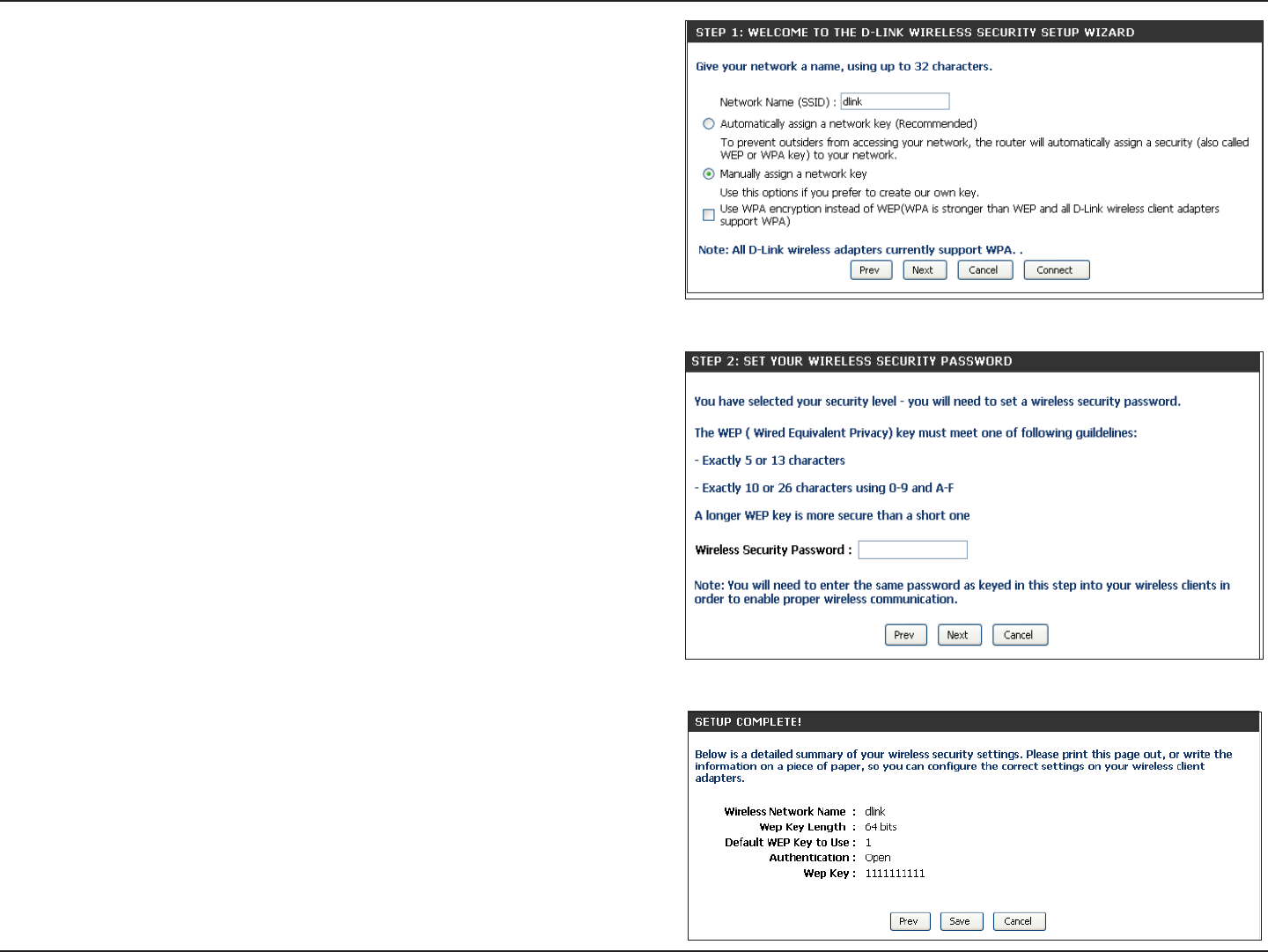
71D-Link DIR-615 User Manual
Section 4 - Security
Select a wireless security password. It must be exactly 5 or 13 characters. It
must also be exactly 10 or 26 characters using 0-9 and A-F.
Click Next to continue.
Your Setup is complete. You will be given a detailed summary of your wireless
security settings. Click Save to nish the Security Wizard.
Enter the SSID (Service Set Identier). The SSID is the name of your wireless
network. Create a name using up to 32 characters. The SSID is case-sensitive.
Select Manually and click on Next.
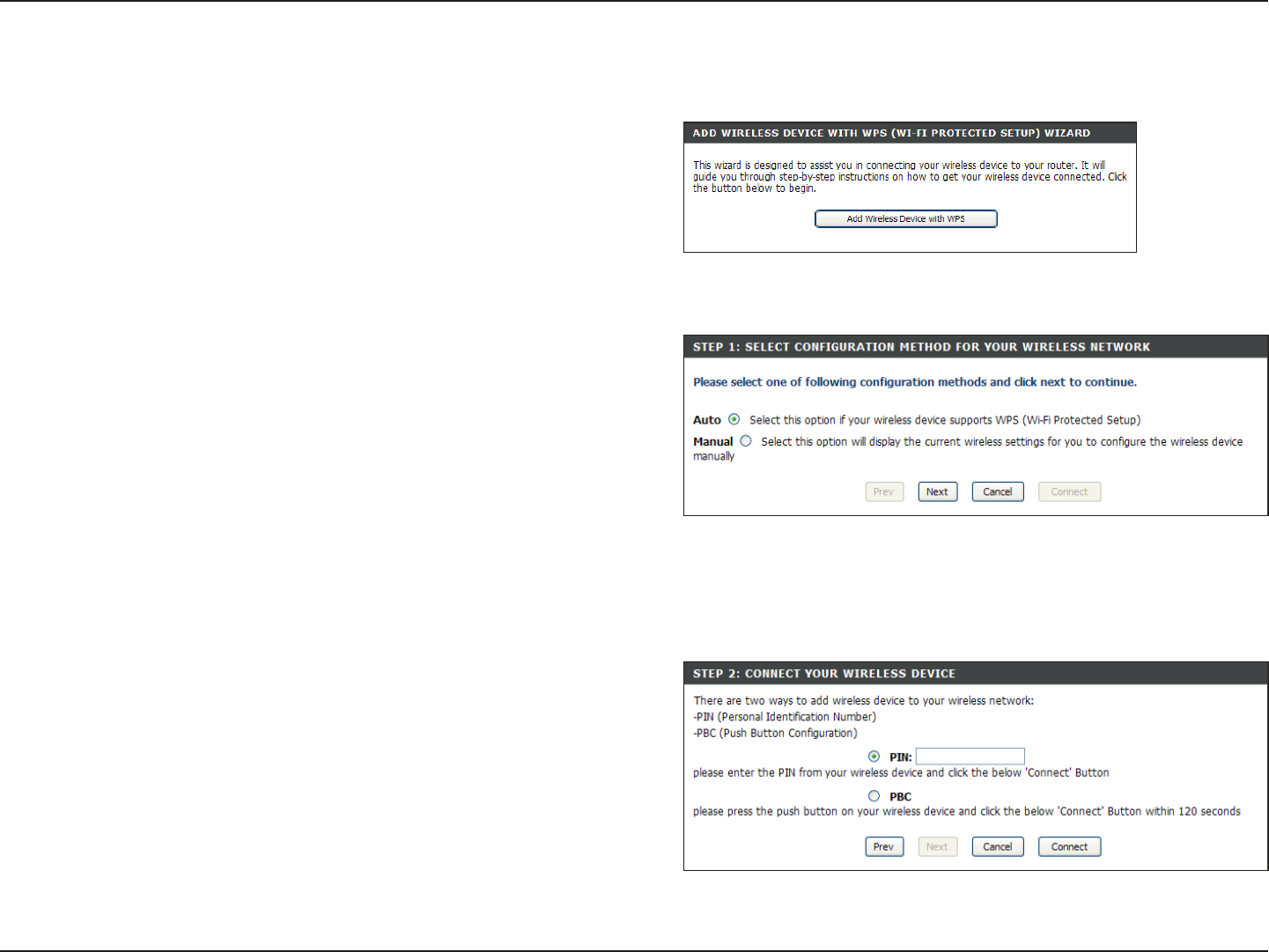
72D-Link DIR-615 User Manual
Section 4 - Security
From the Setup > Wireless Settings screen, click Add Wireless Device
with WPS.
Add Wireless Device with WPS Wizard
PIN: Select this option to use the PIN method. In order to use this method
you must know the wireless client’s 8 digit PIN and click Connect.
PBC: Select this option to use the PBC (Push Button) method to add a wireless
client. Click Connect.
Select Auto to add a wireless client using WPS (Wi-Fi Protected Setup). Once
you select Auto and click Connect, you will have a 120 second time limit
to apply the settings to your wireless client(s) and successfully establish a
connection.
If you select Manual, a settings summary screen will appear. Write down the
security key and enter this on your wireless clients.
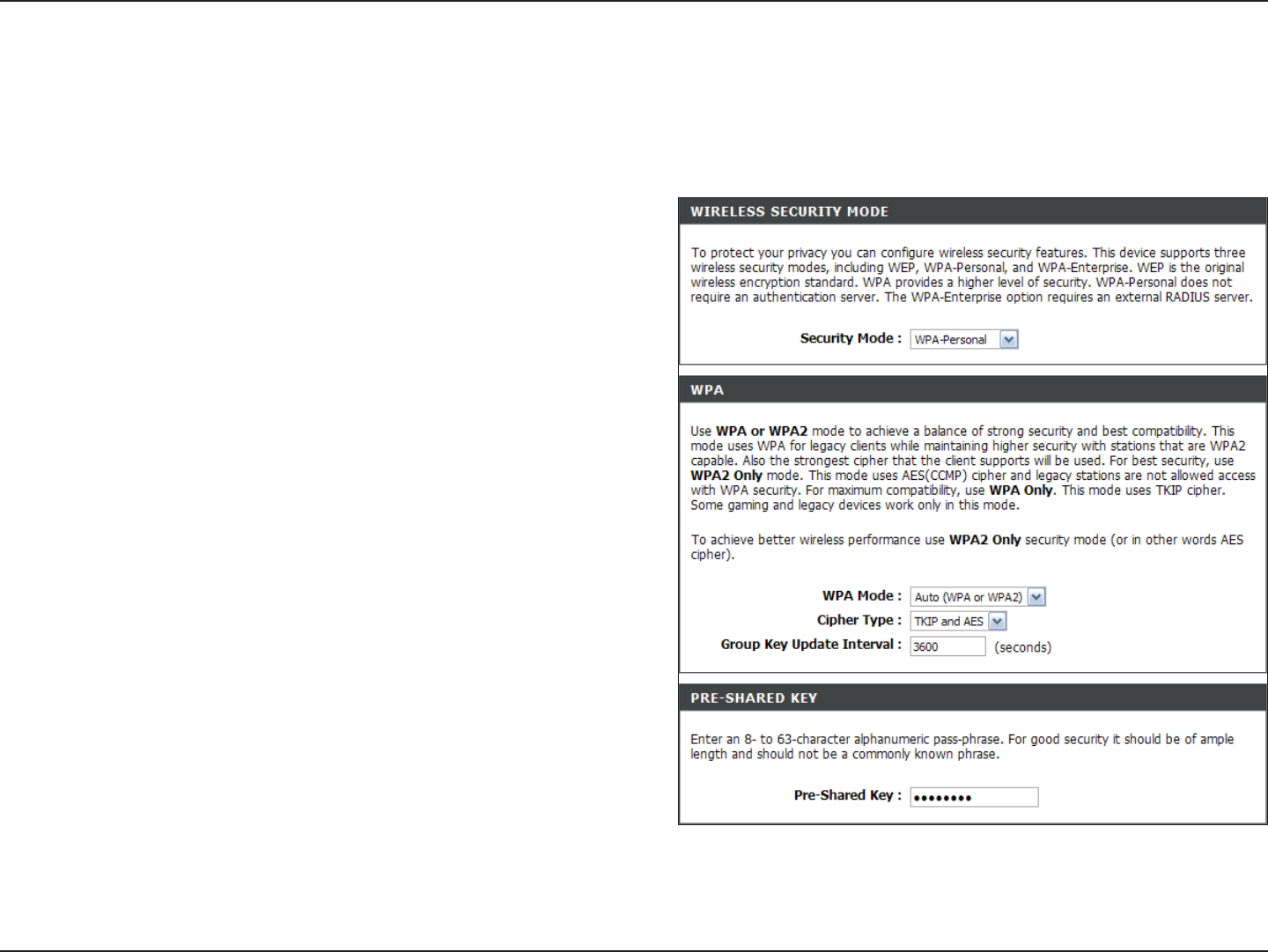
73D-Link DIR-615 User Manual
Section 4 - Security
Congure WPA-Personal (PSK)
It is recommended to enable encryption on your wireless router before your wireless network adapters. Please establish wireless connectivity before
enabling encryption. Your wireless signal may degrade when enabling encryption due to the added overhead.
1. Log into the web-based conguration by opening a web browser and
entering the IP address of the router (192.168.0.1). Click on Setup and
then click Wireless Settings on the left side.
2. Select the Manual Wireless Connection Setup Button.
3. Next to Security Mode, select WPA-Personal.
4. Next to WPA Mode, select Auto, WPA2 Only, or WPA Only. Use Auto if
you have wireless clients using both WPA and WPA2.
5. Next to Cypher Type, select TKIP and AES, TKIP, or AES. If you have
wireless clients that use both types, use TKIP and AES.
6. Next to Group Key Update Interval, enter the amount of time before the
group key used for broadcast and multicast data is changed (3600 is
default).
7. Next to Pre-Shared Key, enter a key (passphrase). The key is entered as a
pass-phrase in ASCII format at both ends of the wireless connection. The
pass-phrase must be between 8-63 characters.
8. Click Save Settings to save your settings. If you are conguring the
router with a wireless adapter, you will lose connectivity until you enable
WPA-PSK on your adapter and enter the same passphrase as you did on
the router.
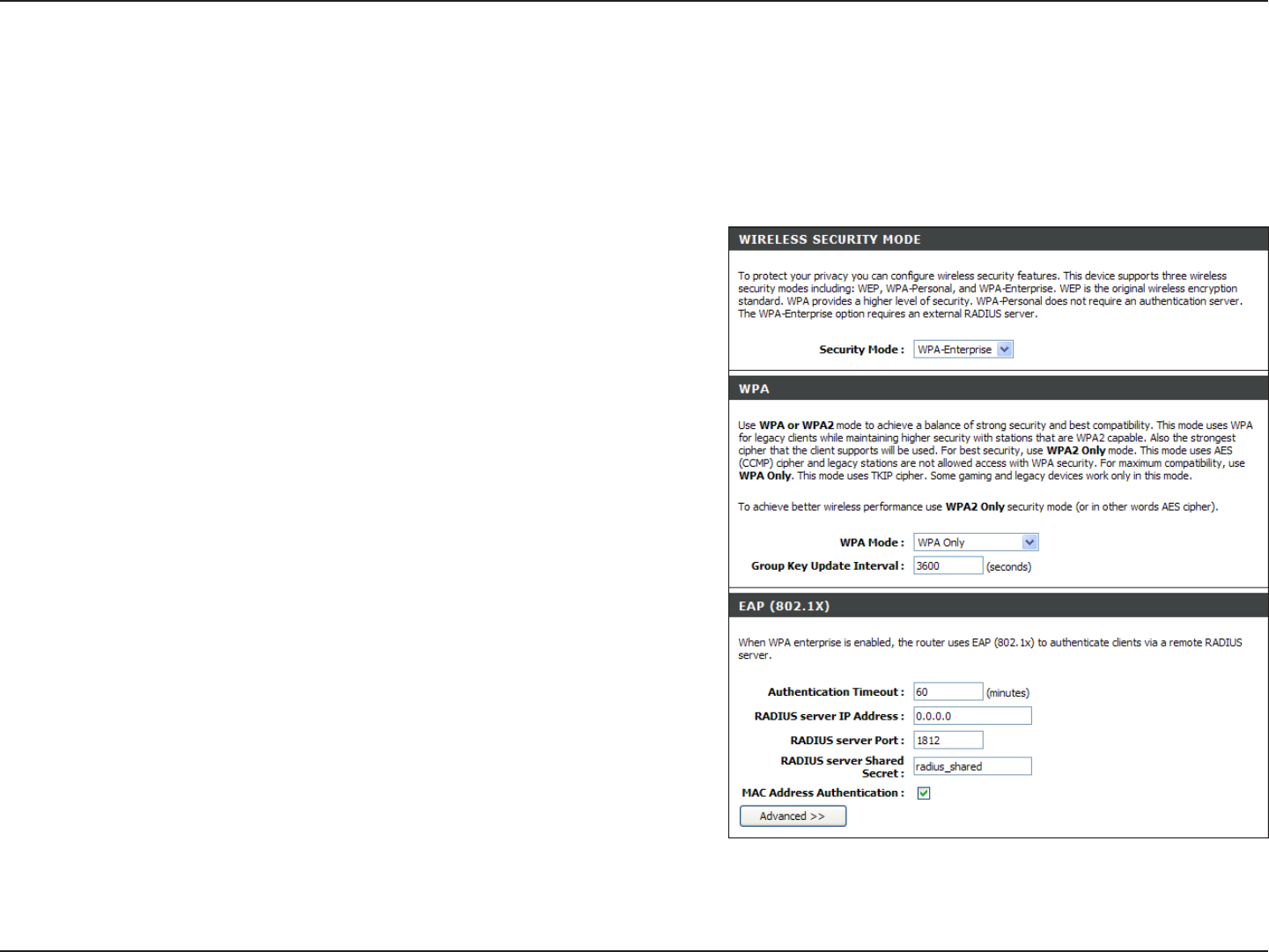
74D-Link DIR-615 User Manual
Section 4 - Security
It is recommended to enable encryption on your wireless router before your wireless network adapters. Please establish wireless connectivity before
enabling encryption. Your wireless signal may degrade when enabling encryption due to the added overhead.
1. Log into the web-based conguration by opening a web browser and entering the IP address of the router (192.168.0.1). Click on Setup
and then click Wireless Settings on the left side.
2. Select the Manual Wireless Connection Setup Button.
3. Next to Security Mode, select WPA-Enterprise.
Note: The user must disable Wi-Fi Protected Setup in order to select WPA-Enterprise.
4. Next to WPA Mode, select Auto, WPA2 Only, or WPA Only. Use Auto if you have
wireless clients using both WPA and WPA2.
5. Next to Cypher Type, select TKIP and AES, TKIP, or AES. If you have wireless
clients that use both types, use TKIP and AES.
6. Next to Group Key Update Interval, enter the amount of time before the group
key used for broadcast and multicast data is changed (3600 is default).
7. Next to Authentication Timeout, enter the amount of time before a client is
required to re-authenticate (60 minutes is default).
8. Next to RADIUS Server IP Address enter the IP Address of your RADIUS server.
9. Next to RADIUS Server Port, enter the port you are using with your RADIUS server.
1812 is the default port.
10. Next to RADIUS Server Shared Secret, enter the security key.
11. If the MAC Address Authentication box is selected then the user will need to
connect from the same computer whenever logging into the wireless network.
Congure WPA-Enterprise (RADIUS)
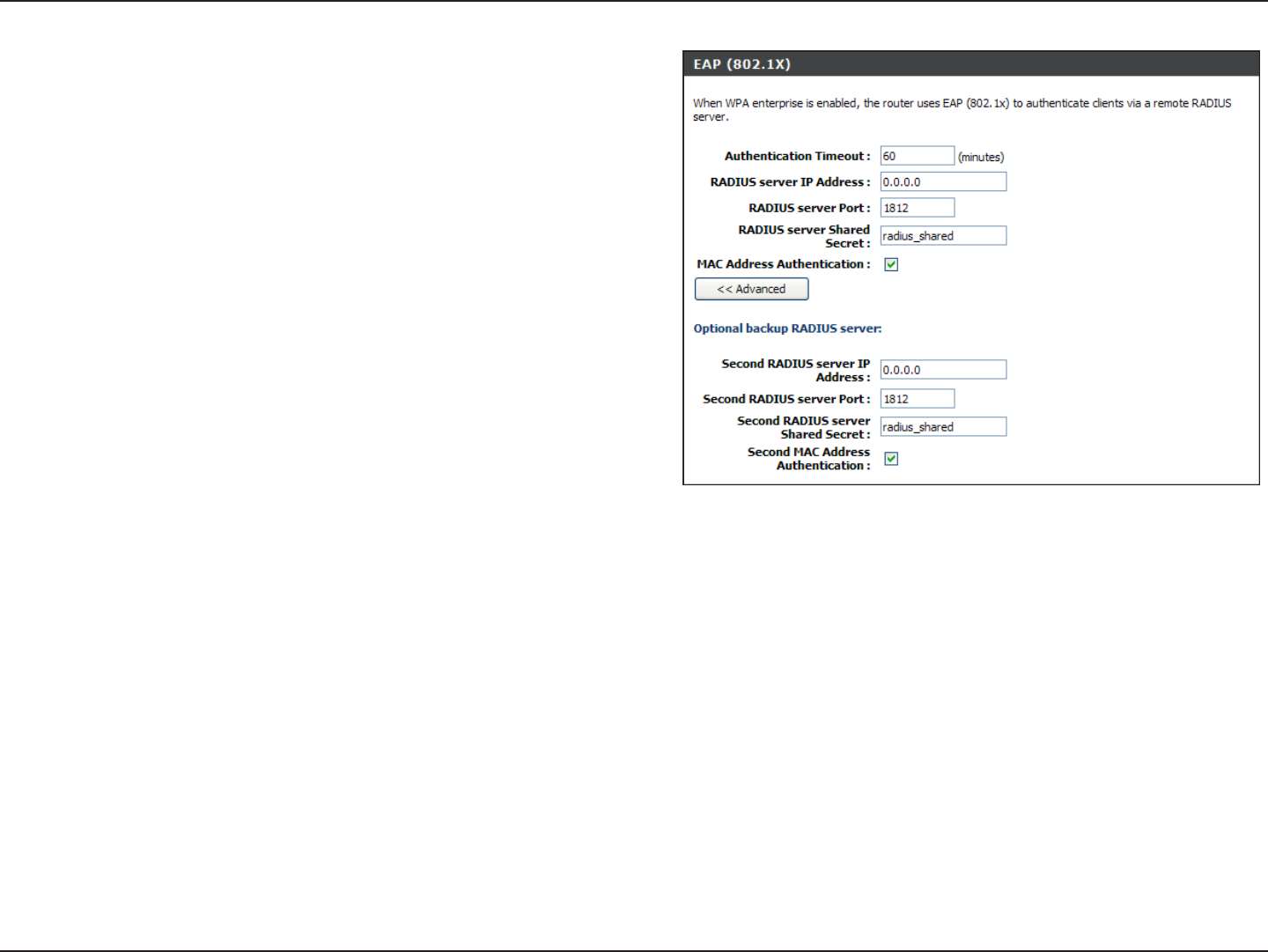
75D-Link DIR-615 User Manual
Section 4 - Security
12. Click Advanced to enter settings for a secondary RADIUS Server.
13. Click Apply Settings to save your settings.
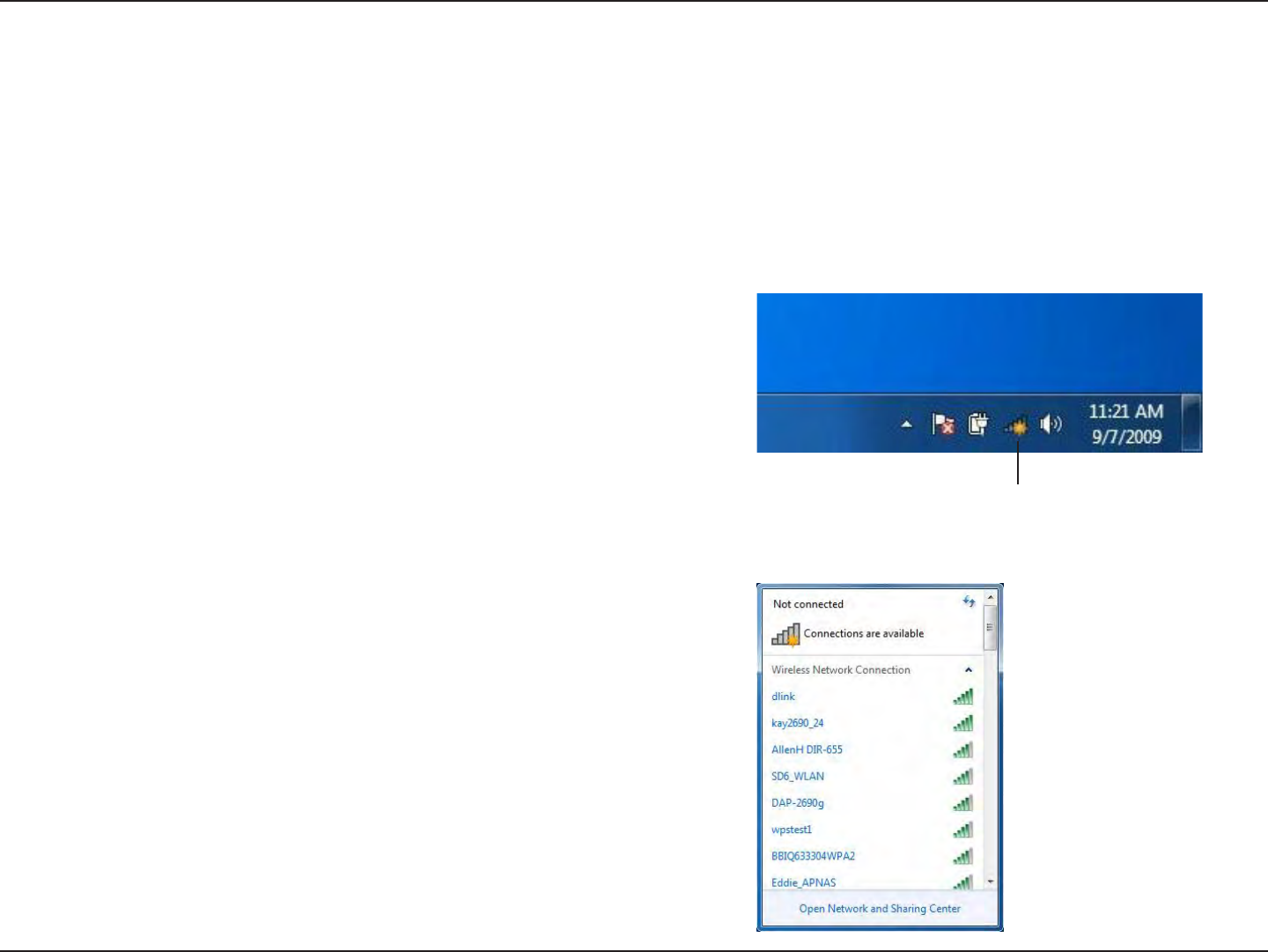
76D-Link DIR-615 User Manual
Section 5 - Connecting to a Wireless Network
Using Windows® 7
It is recommended to enable wireless security (WPA/WPA2) on your wireless router or access point before conguring your wireless adapter. If you
are joining an existing network, you will need to know the security key or passphrase being used.
1. Click on the wireless icon in your system tray (lower-right corner).
2. The utility will display any available wireless networks in your area.
Connect to a Wireless Network
Wireless Icon
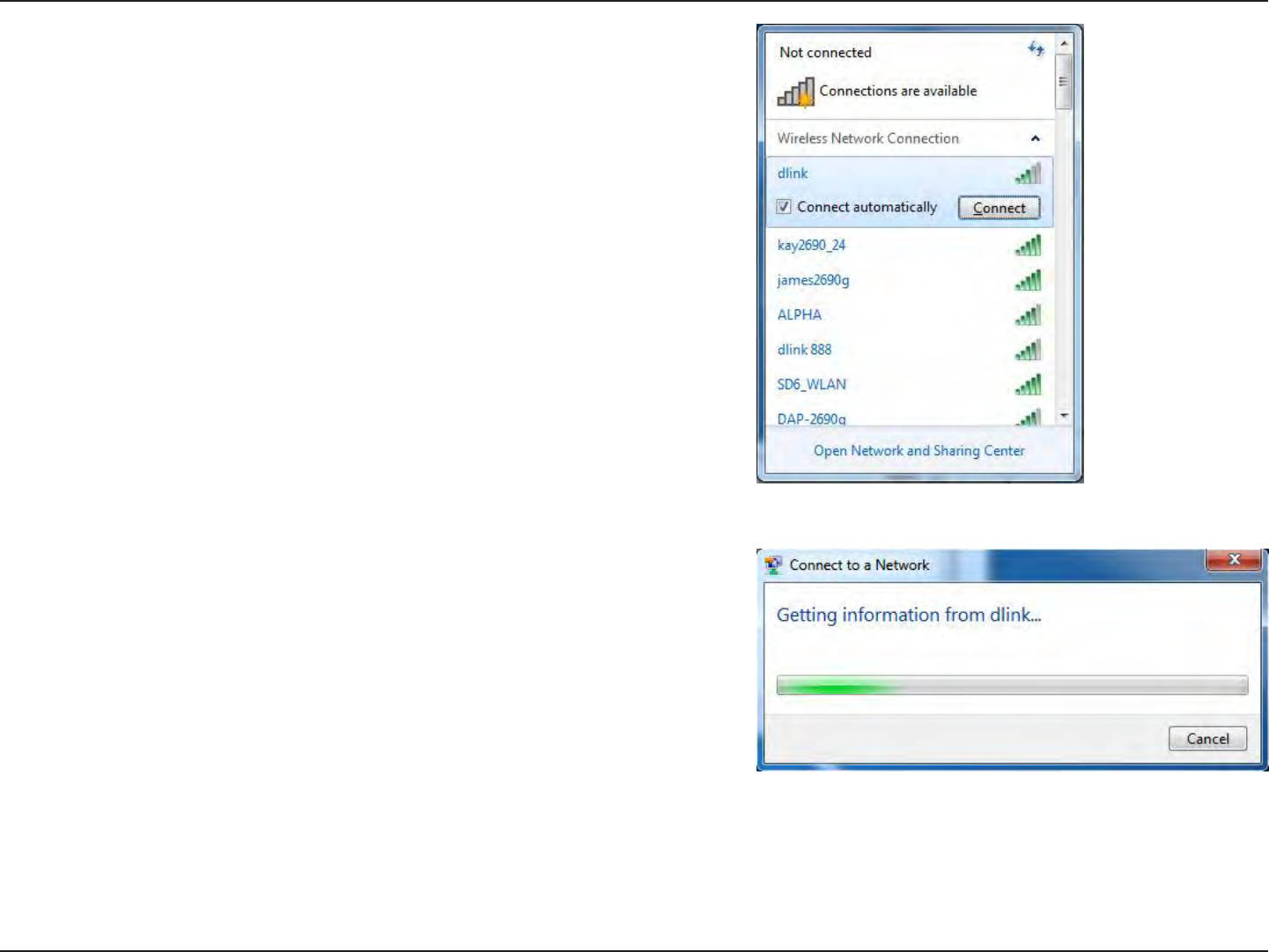
77D-Link DIR-615 User Manual
Section 5 - Connecting to a Wireless Network
3. Highlight the wireless network (SSID) you would like to connect to and click
the Connect button.
If you get a good signal, but cannot access the Internet, check your TCP/IP
settings for your wireless adapter. Refer to the Networking Basics section in
this manual for more information.
4. The following window appears while your computer tries to connect to the
router.
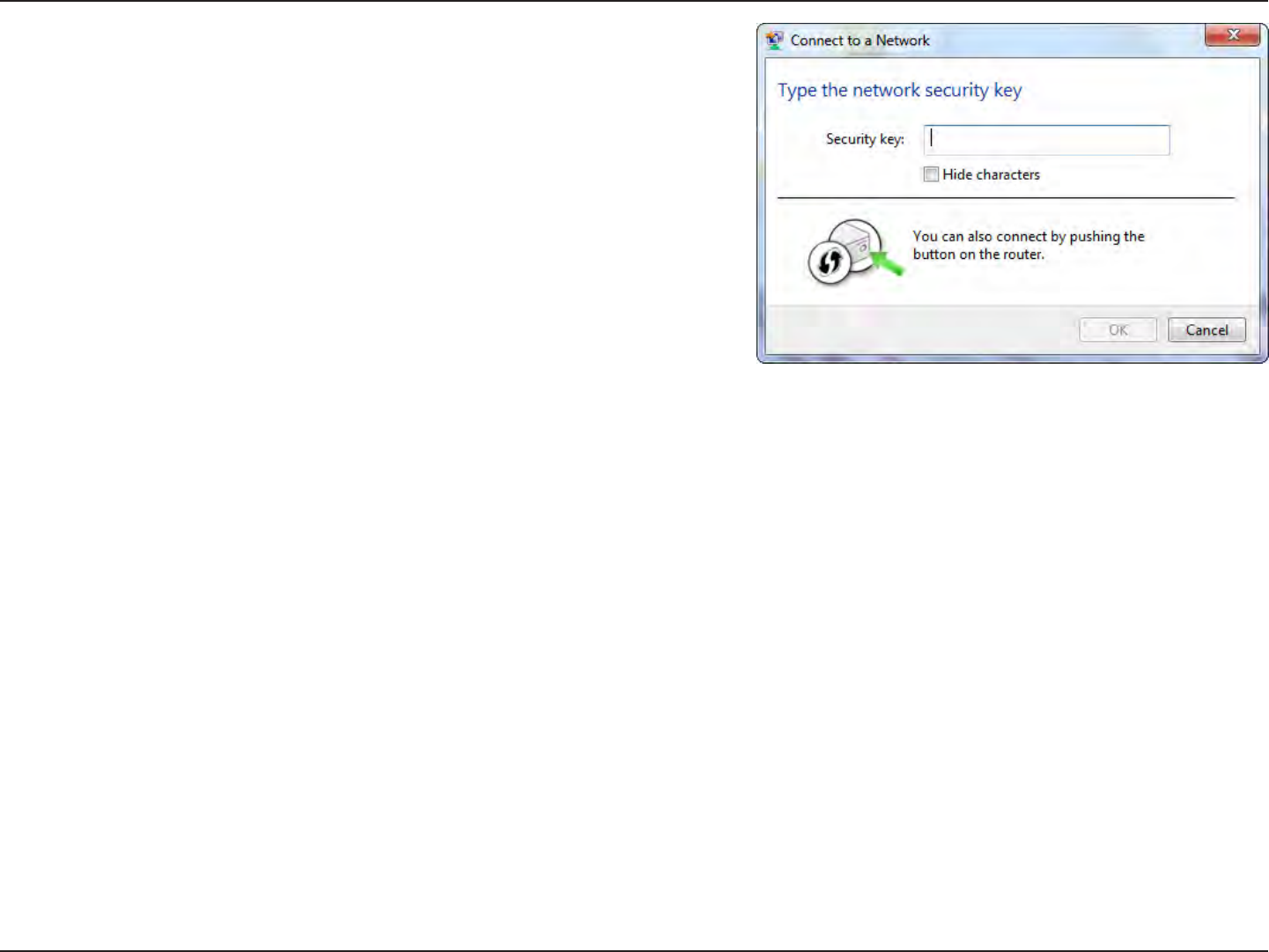
78D-Link DIR-615 User Manual
Section 5 - Connecting to a Wireless Network
5. Enter the same security key or passphrase that is on your router and click
Connect. You can also connect by pushing the WPS button on the router.
It may take 20-30 seconds to connect to the wireless network. If the connection
fails, please verify that the security settings are correct. The key or passphrase
must be exactly the same as on the wireless router.
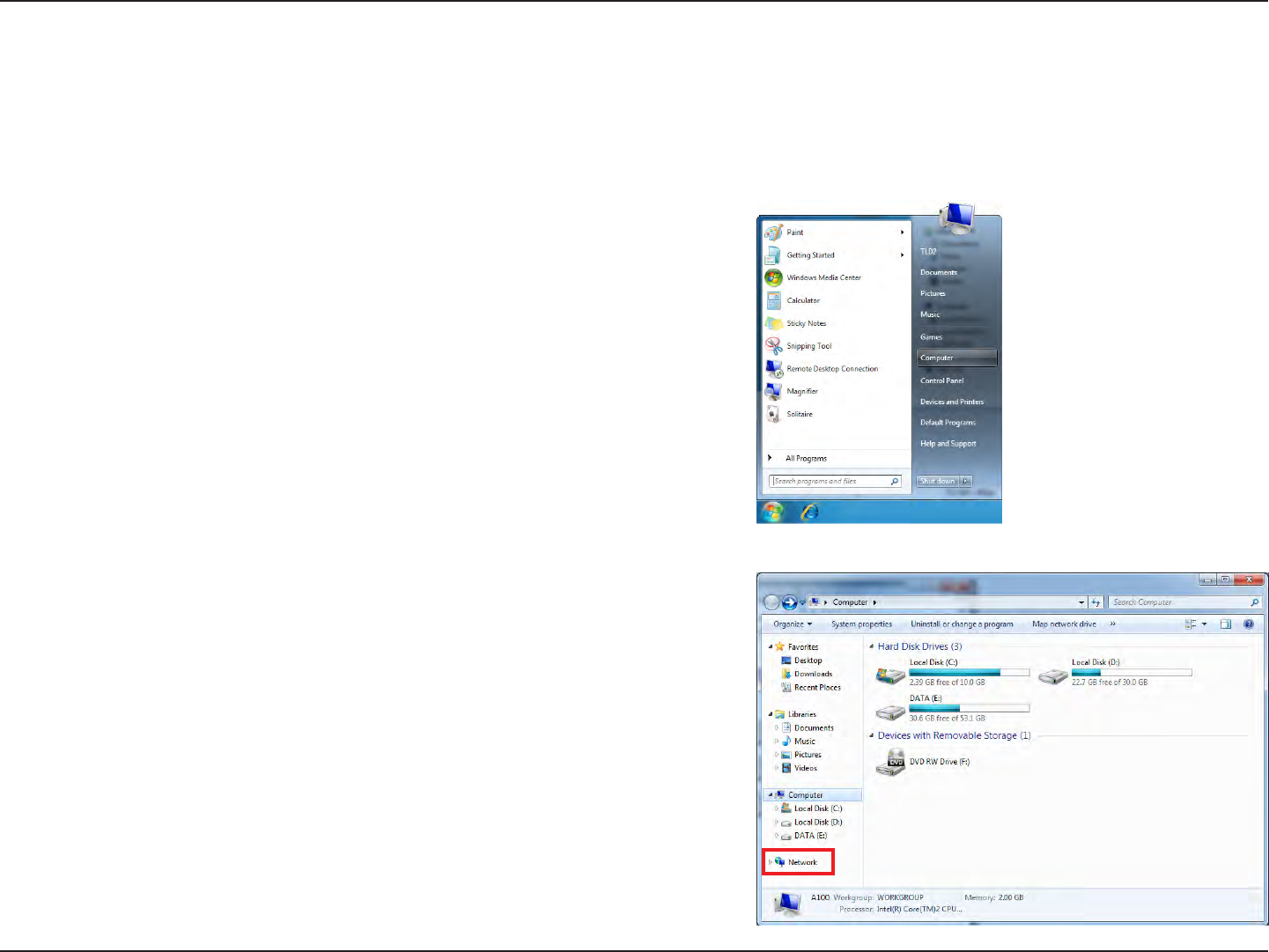
79D-Link DIR-615 User Manual
Section 5 - Connecting to a Wireless Network
Congure WPS
The WPS feature of the DIR-615 can be congured using Windows® 7. Carry out the following steps to use Windows® 7 to congure the WPS feature
of the DIR-615:
1. Click the Start button and select Computer from the Start menu.
2. Click the Network option.
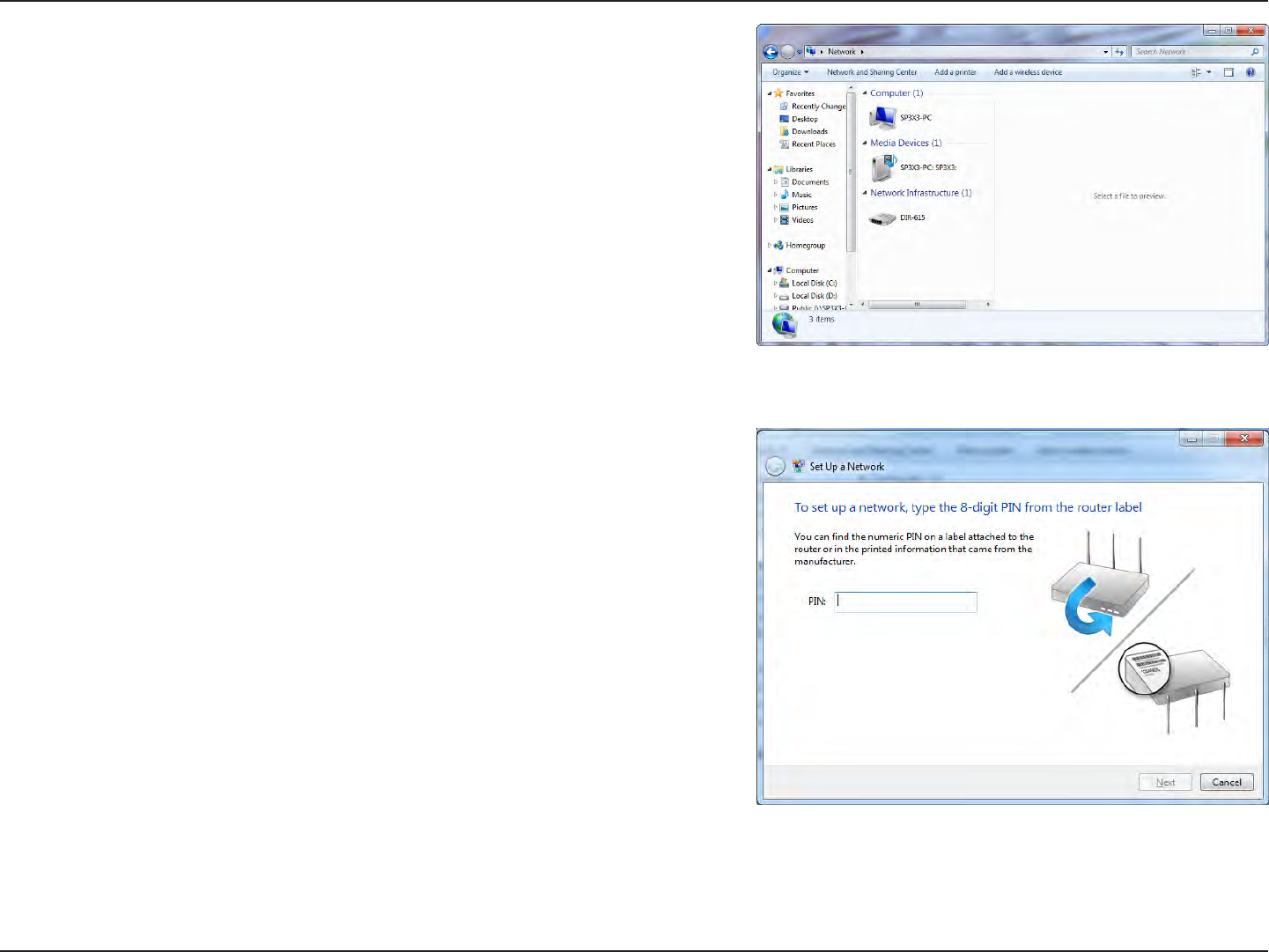
80D-Link DIR-615 User Manual
Section 5 - Connecting to a Wireless Network
3. Double-click the DIR-615 router.
4. Input the WPS PIN number (displayed in the WPS window on the Router’s
LCD screen or in the Setup > Wireless Setup menu in the Router’s Web UI)
and click Next.
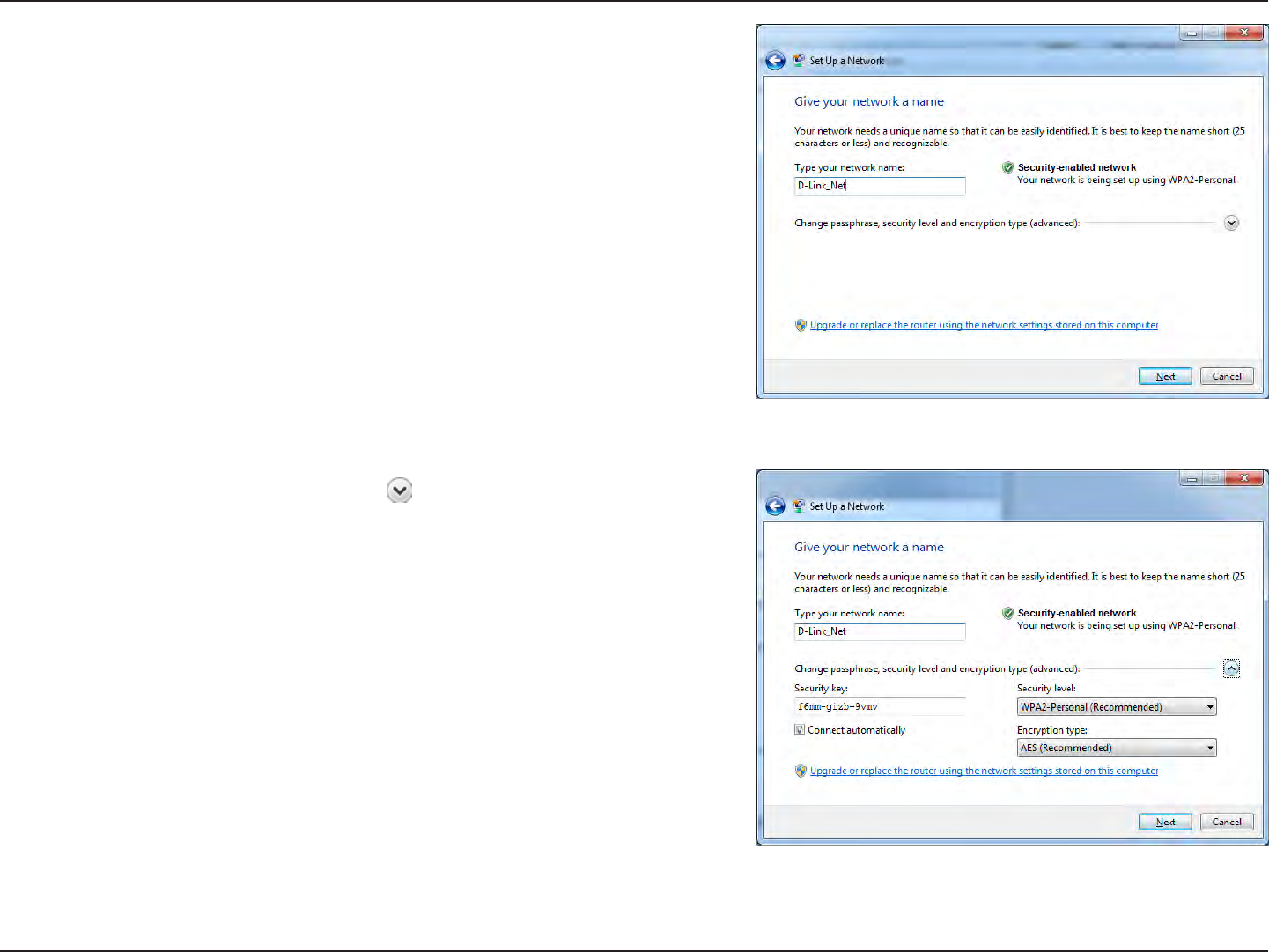
81D-Link DIR-615 User Manual
Section 5 - Connecting to a Wireless Network
5. Type a name to identify the network.
6. To congure advanced settings, click the icon.
Click Next to continue.
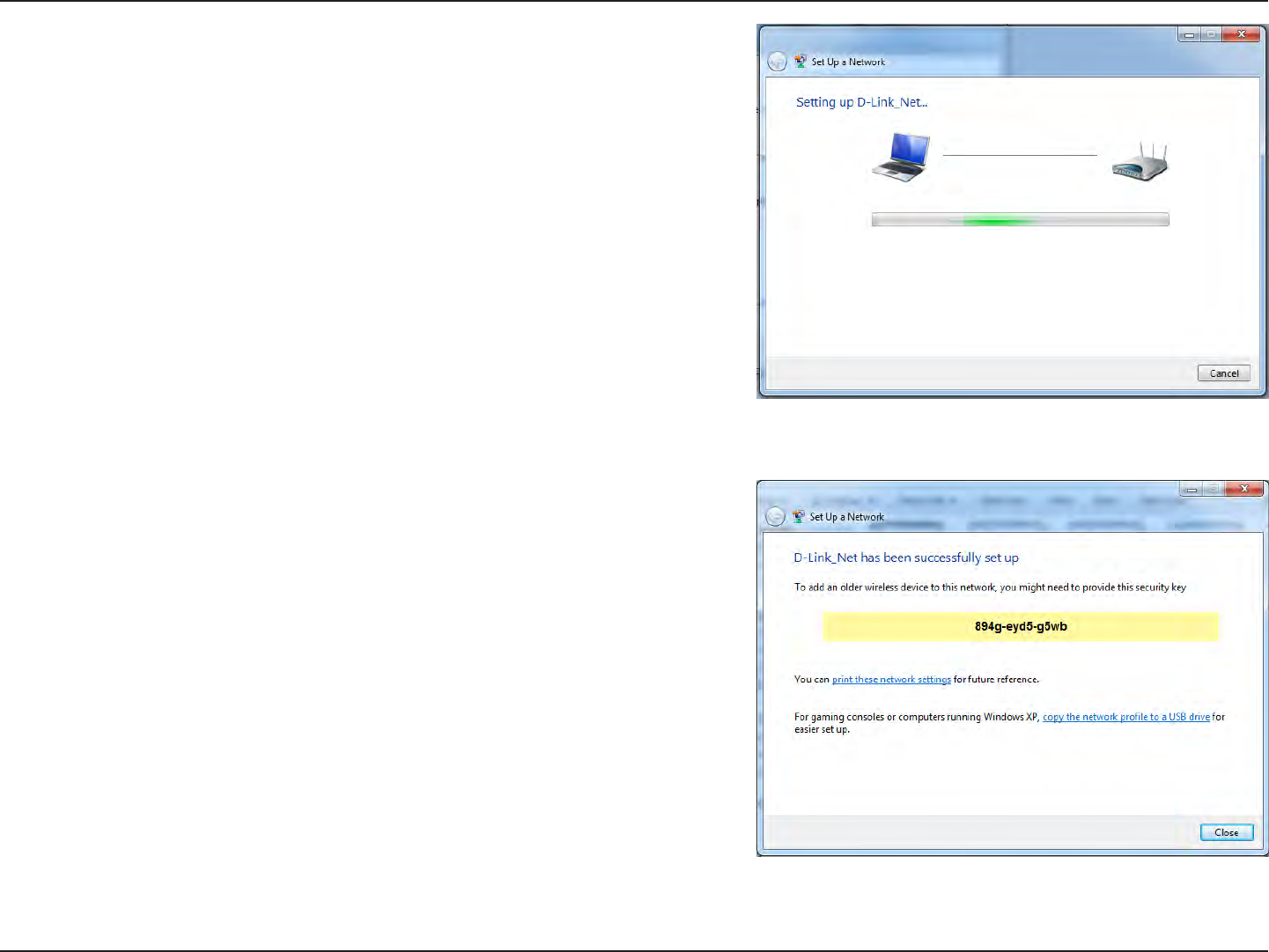
82D-Link DIR-615 User Manual
Section 5 - Connecting to a Wireless Network
7. The following window appears while the Router is being congured.
Wait for the conguration to complete.
8. The following window informs you that WPS on the DIR-615 has been setup
successfully.
Make a note of the security key as you may need to provide this security key
if adding an older wireless device to the network in the future.
9. Click Close to complete WPS setup.
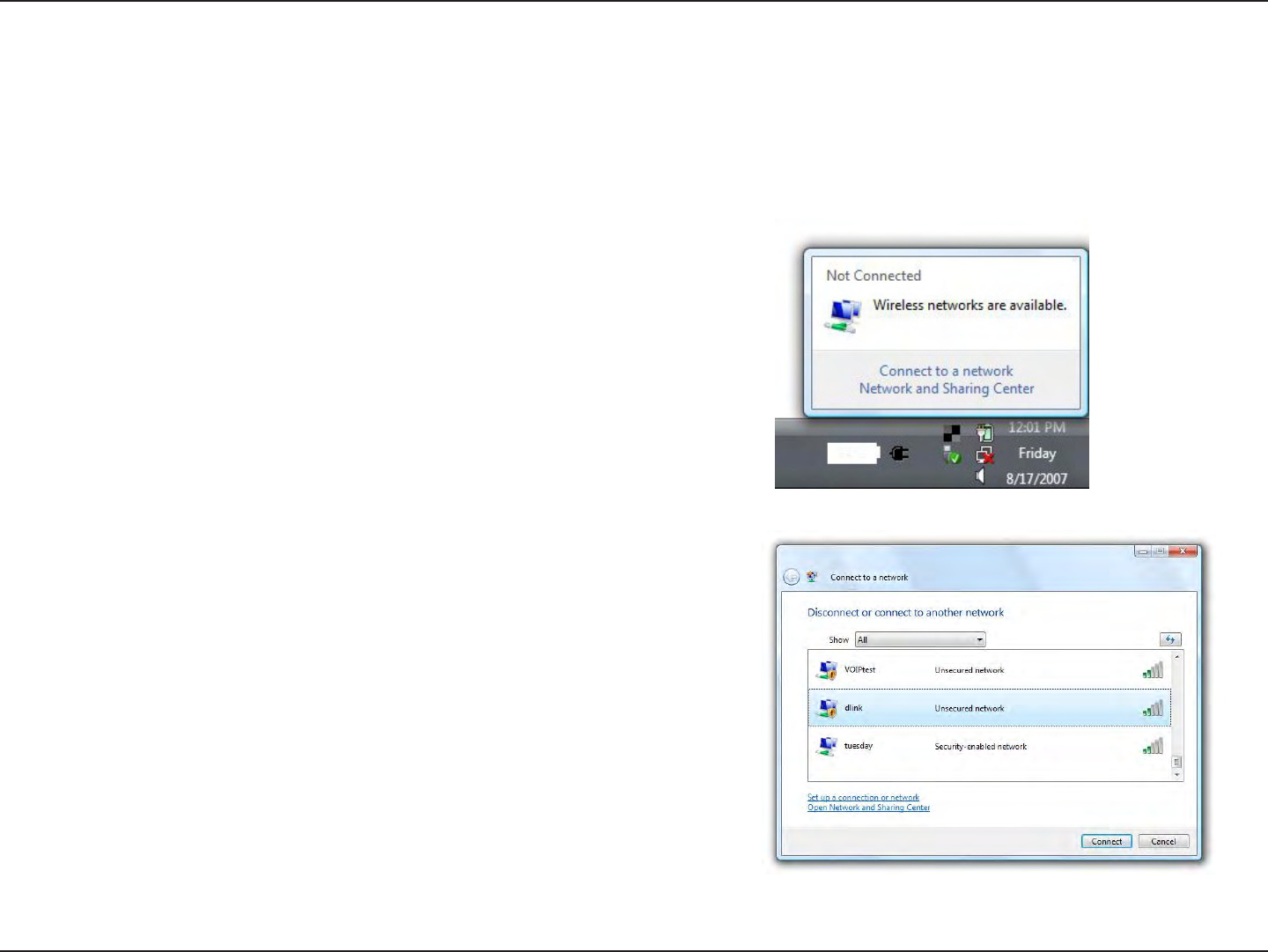
83D-Link DIR-615 User Manual
Section 5 - Connecting to a Wireless Network
Windows Vista® users may use the built-in wireless utility. If you are using another company’s utility or Windows® 2000, please refer to the user manual
of your wireless adapter for help with connecting to a wireless network. Most utilities will have a “site survey” option similar to the Windows Vista®
utility as seen below.
Right-click on the wireless computer icon in your system tray (lower-right corner
next to the time). Select Connect to a network.
If you receive the Wireless Networks Detected bubble, click on the center of
the bubble to access the utility.
or
The utility will display any available wireless networks in your area. Click on a
network (displayed using the SSID) and click the Connect button.
If you get a good signal but cannot access the Internet, check you TCP/IP settings
for your wireless adapter. Refer to the Networking Basics section in this manual
for more information.
Using Windows Vista®
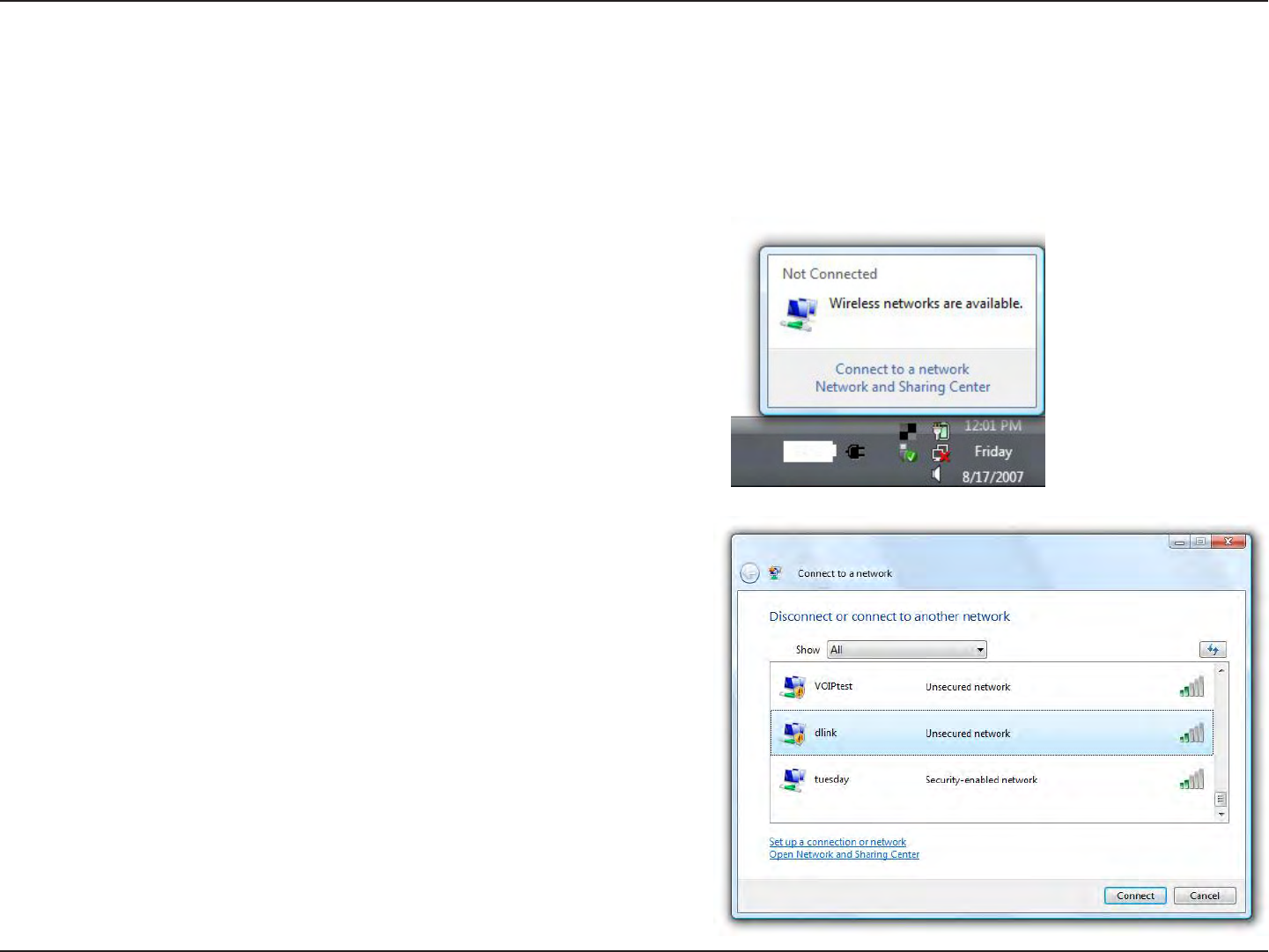
84D-Link DIR-615 User Manual
Section 5 - Connecting to a Wireless Network
Congure WPA/WPA2
It is recommended to enable wireless security (WPA/WPA2) on your wireless router or access point before conguring your wireless adapter. If you
are joining an existing network, you will need to know the security key or passphrase being used.
2. Highlight the wireless network (SSID) you would like to connect to and
click Connect.
1. Open the Windows Vista® Wireless Utility by right-clicking on the wireless
computer icon in your system tray (lower right corner of screen). Select
Connect to a network.
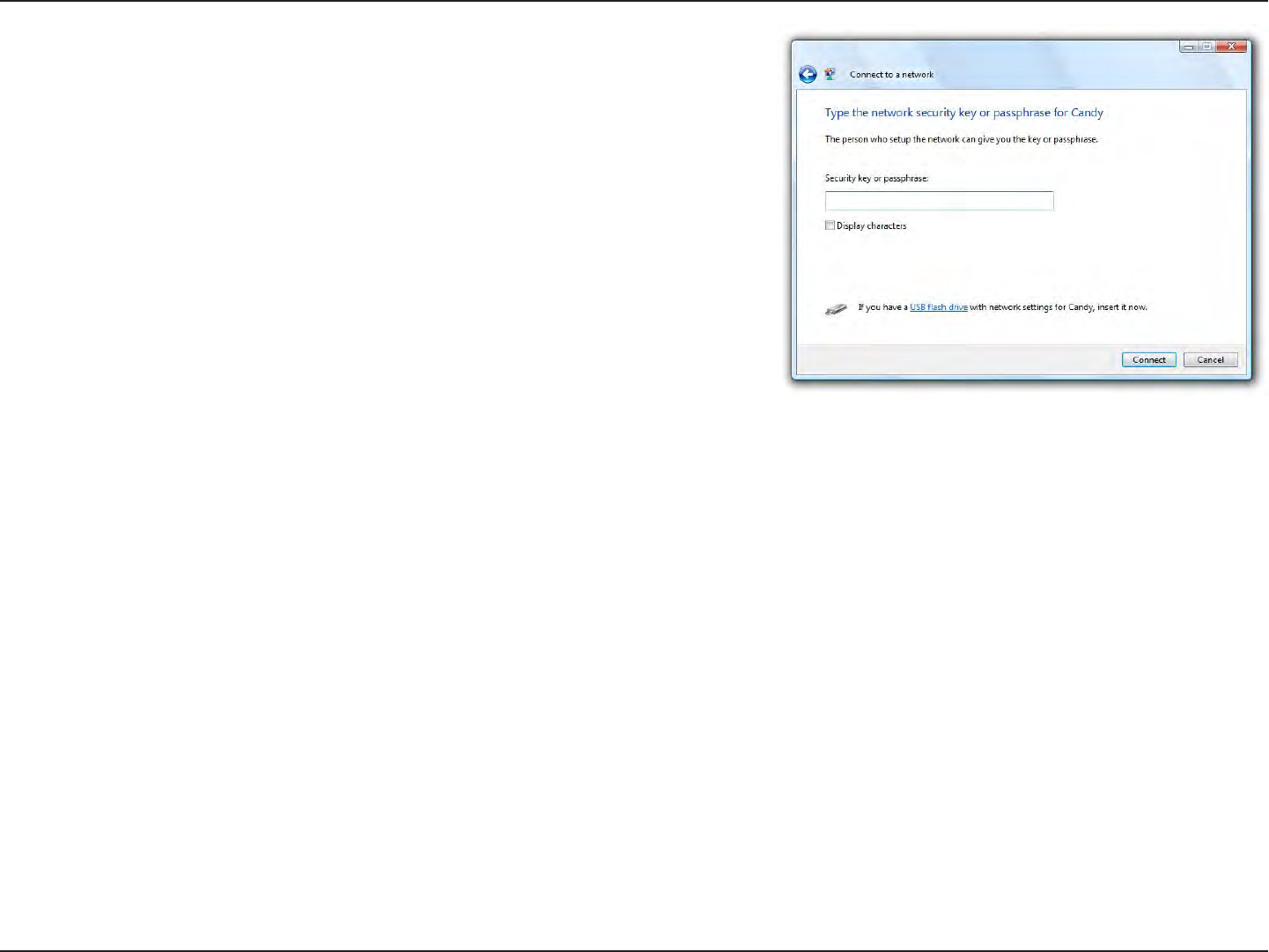
85D-Link DIR-615 User Manual
Section 5 - Connecting to a Wireless Network
3. Enter the same security key or passphrase that is on your router and click Connect.
It may take 20-30 seconds to connect to the wireless network. If the connection fails,
please verify that the security settings are correct. The key or passphrase must be
exactly the same as on the wireless router.
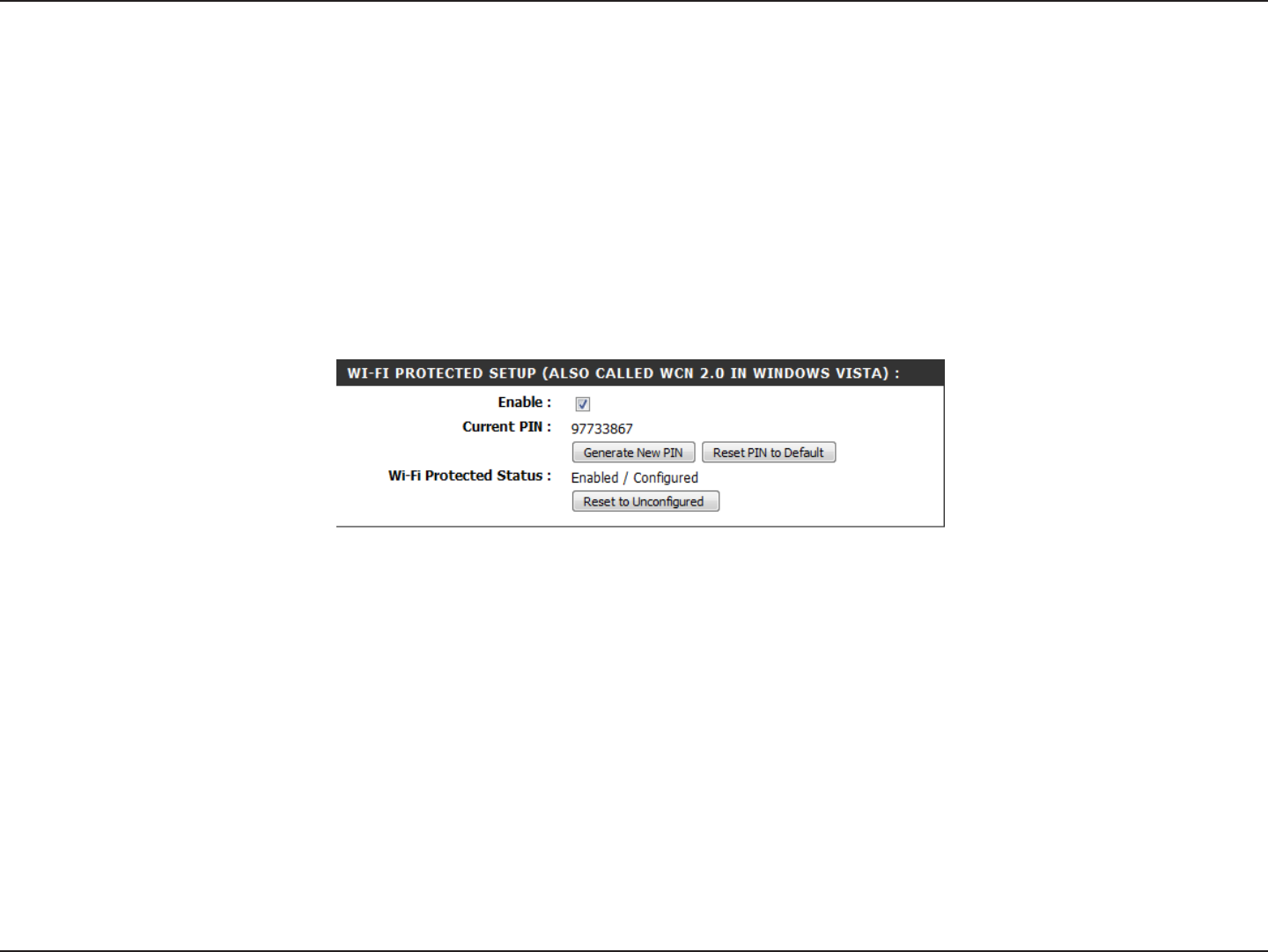
86D-Link DIR-615 User Manual
Section 5 - Connecting to a Wireless Network
Connect Using WCN 2.0
The router supports Wi-Fi protection, referred to as WCN 2.0 in Windows Vista® and Windows 7. The following instructions for setting this up depends
on whether you are using Windows Vista® and Windows 7 to congure the router or third party software.
When you rst set up the router, Wi-Fi protection is disabled and uncongured. To enjoy the benets of Wi-Fi protection, the router must be both
enabled and congured. There are three basic methods to accomplish this: use Windows Vista’s built-in support for WCN 2.0, use software provided
by a third party, or manually congure.
If you are running Windows Vista®, log into the router and click the Enable checkbox in the Basic > Wireless section. Use the Current PIN that is
displayed on the Advanced > Wi-Fi Protected Setup section or choose to click the Generate New PIN button or Reset PIN to Default button.
If you are using third party software to set up Wi-Fi Protection, carefully follow the directions. When you are nished, proceed to the next section
to set up the newly-congured router.
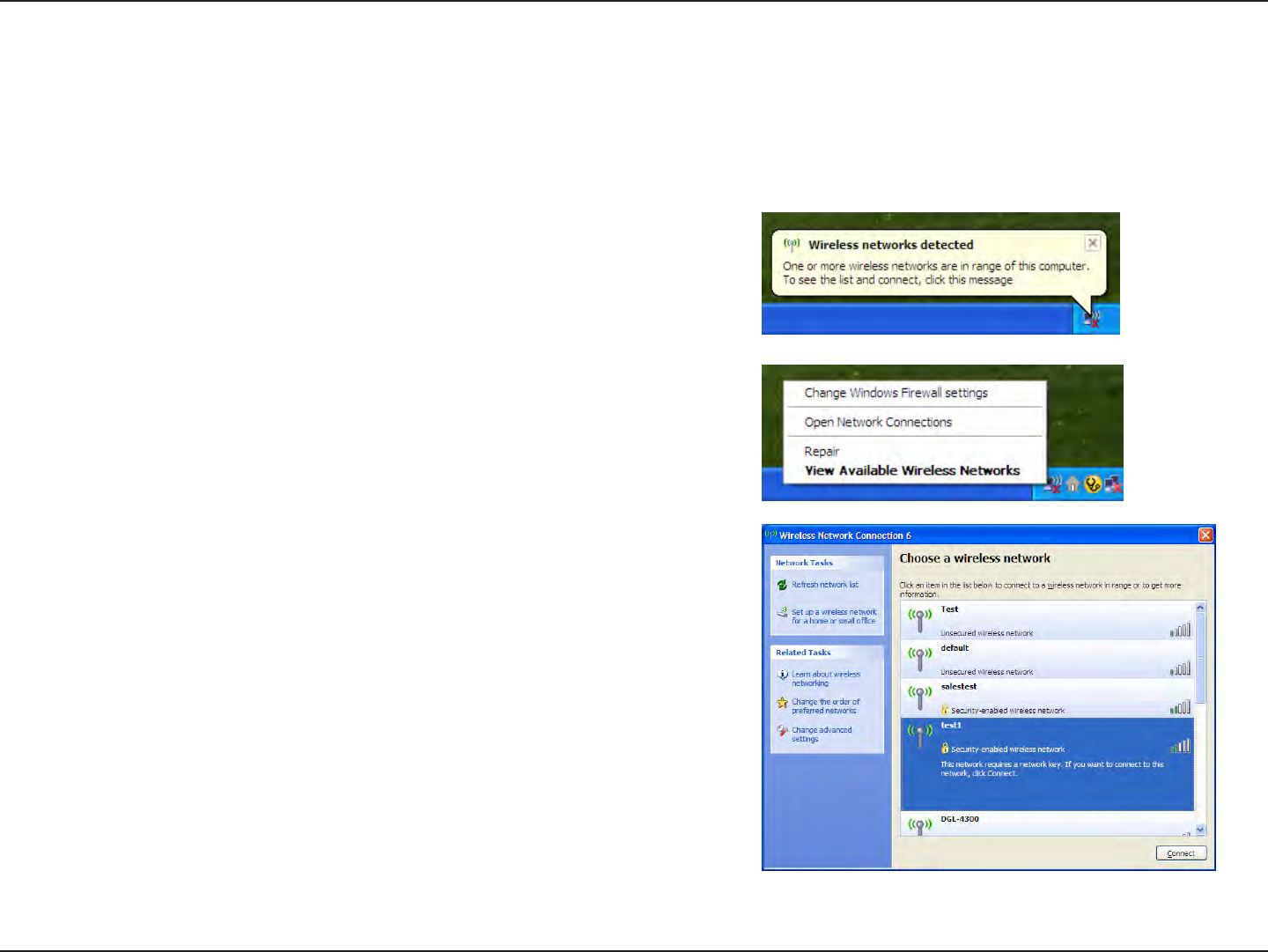
87D-Link DIR-615 User Manual
Section 5 - Connecting to a Wireless Network
Windows® XP users may use the built-in wireless utility (Zero Conguration Utility). The following instructions are for Service Pack 2 users. If you are
using another company’s utility or Windows® 2000, please refer to the user manual of your wireless adapter for help with connecting to a wireless
network. Most utilities will have a “site survey” option similar to the Windows® XP utility as seen below.
If you receive the Wireless Networks Detected bubble, click on the center of
the bubble to access the utility.
or
Right-click on the wireless computer icon in your system tray (lower-right corner
next to the time). Select View Available Wireless Networks.
The utility will display any available wireless networks in your area. Click on a
network (displayed using the SSID) and click the Connect button.
If you get a good signal but cannot access the Internet, check you TCP/IP settings
for your wireless adapter. Refer to the Networking Basics section in this manual
for more information.
Using Windows® XP
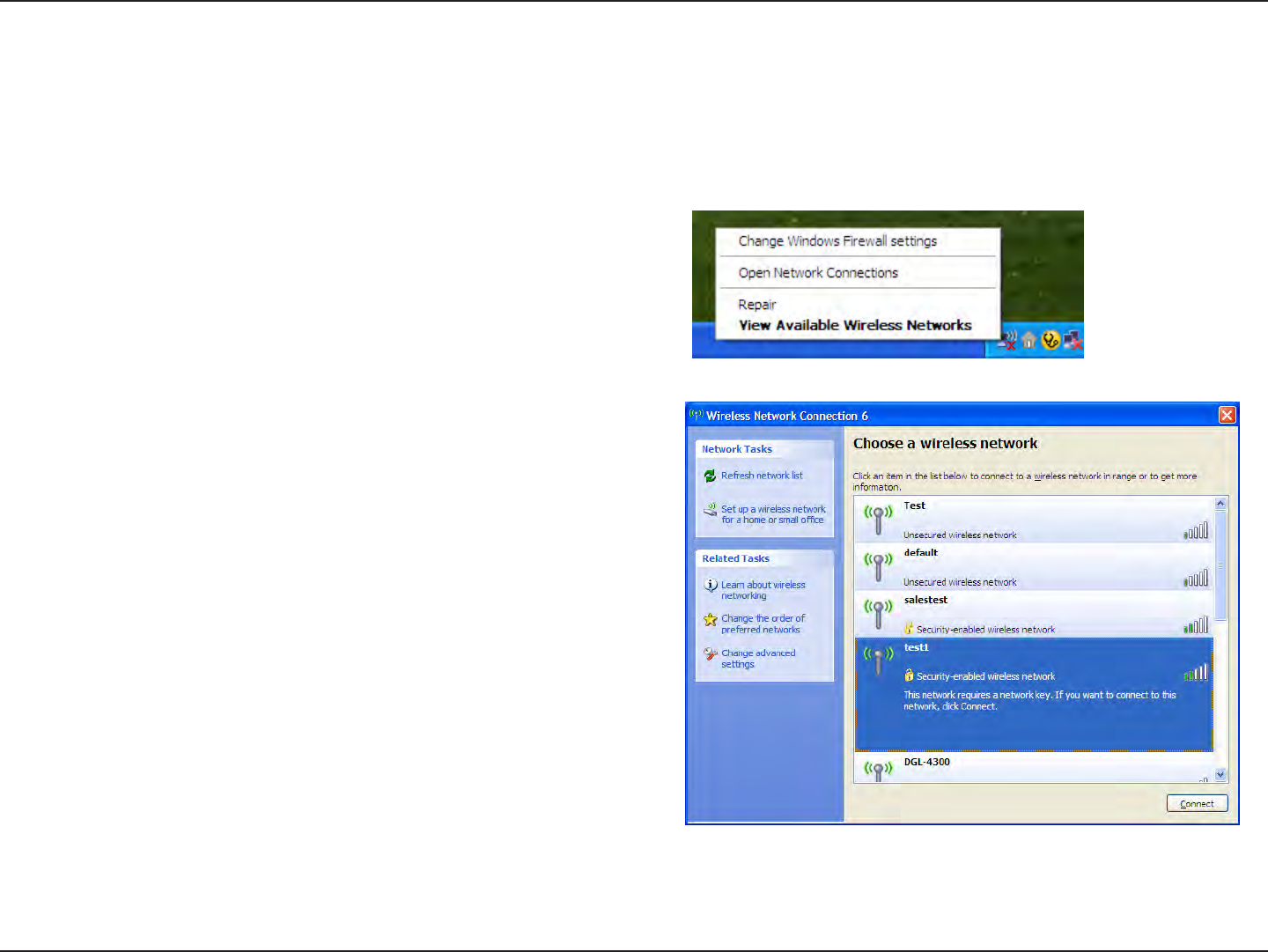
88D-Link DIR-615 User Manual
Section 5 - Connecting to a Wireless Network
It is recommended to enable WEP on your wireless router or access point before conguring your wireless adapter. If you are joining an existing
network, you will need to know the WEP key being used.
2. Highlight the wireless network (SSID) you would like to connect to and
click Connect.
1. Open the Windows® XP Wireless Utility by right-clicking on the wireless
computer icon in your system tray (lower-right corner of screen). Select
View Available Wireless Networks.
Congure WPA-PSK
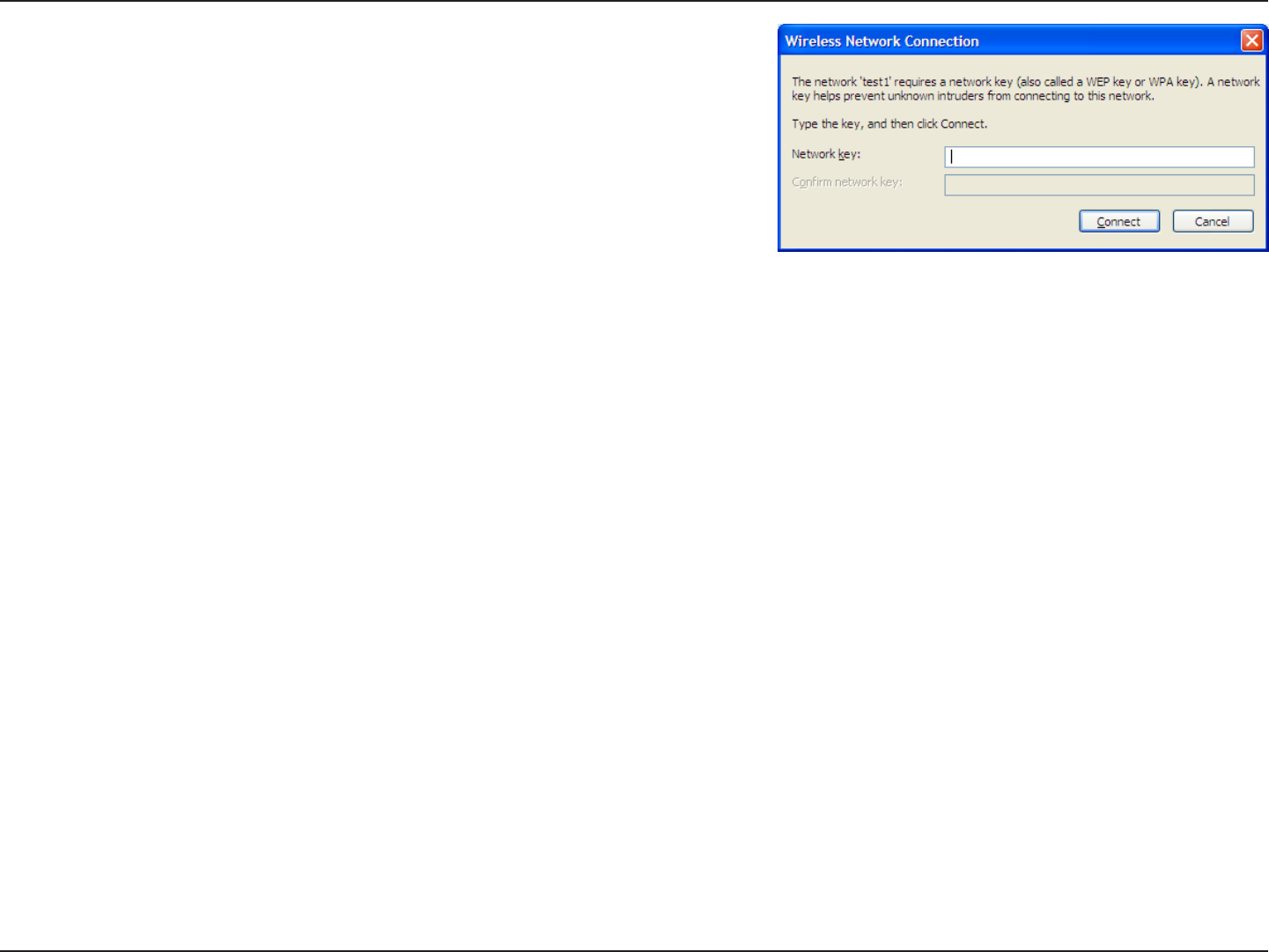
89D-Link DIR-615 User Manual
Section 5 - Connecting to a Wireless Network
3. The Wireless Network Connection box will appear. Enter the WPA-PSK passphrase
and click Connect.
It may take 20-30 seconds to connect to the wireless network. If the connection fails,
please verify that the WPA-PSK settings are correct. The WPA-PSK passphrase must be
exactly the same as on the wireless router.

90D-Link DIR-615 User Manual
Section 6 - Troubleshooting
Troubleshooting
This chapter provides solutions to problems that can occur during the installation and operation of the DIR-615. Read the following descriptions
if you are having problems. (The examples below are illustrated in Windows® XP. If you have a dierent operating system, the screen shots on your
computer will look similar to the following examples.)
1. Why can’t I access the web-based conguration utility?
When entering the IP address of the D-Link router (192.168.0.1 for example), you are not connecting to a website on the Internet or have to be
connected to the Internet. The device has the utility built-in to a ROM chip in the device itself. Your computer must be on the same IP subnet to
connect to the web-based utility.
• Make sure you have an updated Java-enabled web browser. We recommend the following:
• Internet Explorer 6 or higher
• Mozilla 1.7.12 (5.0) or higher
• Safari 3 or higher
• Firefox 3.0 or higher
• Verify physical connectivity by checking for solid link lights on the device. If you do not get a solid link light, try using a dierent cable or connect
to a dierent port on the device if possible. If the computer is turned o, the link light may not be on.
• Disable any Internet security software running on the computer. Software rewalls such as Zone Alarm, Black Ice, Sygate, Norton Personal Firewall,
and Windows® XP rewall may block access to the conguration pages. Check the help les included with your rewall software for more information
on disabling or conguring it.

91D-Link DIR-615 User Manual
Section 6 - Troubleshooting
• Congure your Internet settings:
• Go to Start > Settings > Control Panel. Double-click the Internet Options Icon. From the Security tab, click the button to restore
the settings to their defaults.
• Click the Connection tab and set the dial-up option to Never Dial a Connection. Click the LAN Settings button. Make sure nothing
is checked. Click OK.
• Go to the Advanced tab and click the button to restore these settings to their defaults. Click OK three times.
• Close your web browser (if open) and open it.
• Access the web management. Open your web browser and enter the IP address of your D-Link router in the address bar. This should open the
login page for your the web management.
• If you still cannot access the conguration, unplug the power to the router for 10 seconds and plug back in. Wait about 30 seconds and try accessing
the conguration. If you have multiple computers, try connecting using a dierent computer.
2. What can I do if I forgot my password?
If you forgot your password, you must reset your router. Unfortunately this process will change all your settings back to the factory defaults.
To reset the router, locate the reset button (hole) on the rear panel of the unit. With the router powered on, use a paperclip to hold the button
down for 10 seconds. Release the button and the router will go through its reboot process. Wait about 30 seconds to access the router. The default
IP address is 192.168.0.1. When logging in, the username is admin and leave the password box empty.
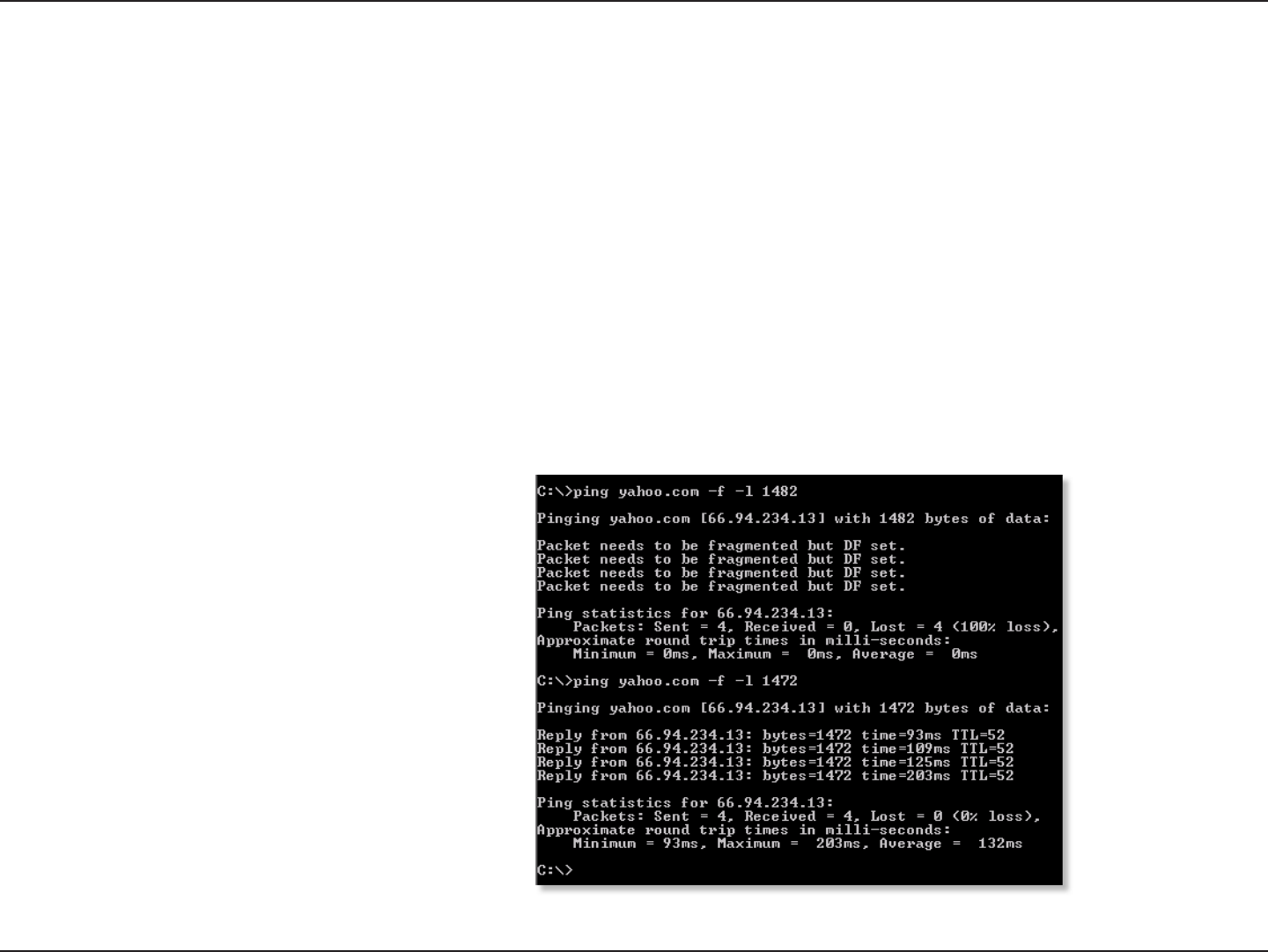
92D-Link DIR-615 User Manual
Section 6 - Troubleshooting
3. Why can’t I connect to certain sites or send and receive e-mails when connecting through my router?
If you are having a problem sending or receiving e-mail, or connecting to secure sites such as eBay, banking sites, and Hotmail, we suggest lowering
the MTU in increments of ten (Ex. 1492, 1482, 1472, etc).
Note: AOL DSL+ users must use MTU of 1400.
To nd the proper MTU Size, you’ll have to do a special ping of the destination you’re trying to go to. A destination could be another computer, or
a URL.
• Click on Start and then click Run.
• Windows® 95, 98, and Me users type in command (Windows® NT, 2000, and XP users type in cmd) and press Enter (or click OK).
• Once the window opens, you’ll need to do a special ping. Use the following syntax:
ping [url] [-f] [-l] [MTU value]
Example: ping yahoo.com -f -l 1472

93D-Link DIR-615 User Manual
Section 6 - Troubleshooting
You should start at 1472 and work your way down by 10 each time. Once you get a reply, go up by 2 until you get a fragmented packet. Take that
value and add 28 to the value to account for the various TCP/IP headers. For example, lets say that 1452 was the proper value, the actual MTU size
would be 1480, which is the optimum for the network we’re working with (1452+28=1480).
Once you nd your MTU, you can now congure your router with the proper MTU size.
To change the MTU rate on your router follow the steps below:
• Open your browser, enter the IP address of your router (192.168.0.1) and click OK.
• Enter your username (admin) and password (blank by default). Click OK to enter the web conguration page for the device.
• Click on Setup and then click Manual Congure.
• To change the MTU enter the number in the MTU eld and click Save Settings to save your settings.
• Test your e-mail. If changing the MTU does not resolve the problem, continue changing the MTU in increments of ten.

94D-Link DIR-615 User Manual
Appendix A - Wireless Basics
D-Link wireless products are based on industry standards to provide easy-to-use and compatible high-speed wireless connectivity within your
home, business or public access wireless networks. Strictly adhering to the IEEE standard, the D-Link wireless family of products will allow you to
securely access the data you want, when and where you want it. You will be able to enjoy the freedom that wireless networking delivers.
A wireless local area network (WLAN) is a cellular computer network that transmits and receives data with radio signals instead of wires. Wireless
LANs are used increasingly in both home and oce environments, and public areas such as airports, coee shops and universities. Innovative ways
to utilize WLAN technology are helping people to work and communicate more eciently. Increased mobility and the absence of cabling and other
xed infrastructure have proven to be benecial for many users.
Wireless users can use the same applications they use on a wired network. Wireless adapter cards used on laptop and desktop systems support
the same protocols as Ethernet adapter cards.
Under many circumstances, it may be desirable for mobile network devices to link to a conventional Ethernet LAN in order to use servers, printers
or an Internet connection supplied through the wired LAN. A Wireless Router is a device used to provide this link.
Wireless Basics

95D-Link DIR-615 User Manual
Appendix A - Wireless Basics
What is Wireless?
Wireless or Wi-Fi technology is another way of connecting your computer to the network without using wires. Wi-Fi uses radio frequency
to connect wirelessly, so you have the freedom to connect computers anywhere in your home or oce network.
Why D-Link Wireless?
D-Link is the worldwide leader and award winning designer, developer, and manufacturer of networking products. D-Link delivers
the performance you need at a price you can aord. D-Link has all the products you need to build your network.
How does wireless work?
Wireless works similar to how cordless phone work, through radio signals to transmit data from one point A to point B. But wireless
technology has restrictions as to how you can access the network. You must be within the wireless network range area to be able to
connect your computer. There are two dierent types of wireless networks Wireless Local Area Network (WLAN), and Wireless Personal
Area Network (WPAN).
Wireless Local Area Network (WLAN)
In a wireless local area network, a device called an Access Point (AP) connects computers to the network. The access point has a small
antenna attached to it, which allows it to transmit data back and forth over radio signals. With an indoor access point as seen in the
picture, the signal can travel up to 300 feet. With an outdoor access point the signal can reach out up to 30 miles to serve places like
manufacturing plants, industrial locations, college and high school campuses, airports, golf courses, and many other outdoor venues.
Wireless Personal Area Network (WPAN)
Bluetooth is the industry standard wireless technology used for WPAN. Bluetooth devices in WPAN operate in a range up to 30 feet away.
Compared to WLAN the speed and wireless operation range are both less than WLAN, but in return it doesn’t use nearly as much power
which makes it ideal for personal devices, such as mobile phones, PDAs, headphones, laptops, speakers, and other devices that operate
on batteries.

96D-Link DIR-615 User Manual
Appendix A - Wireless Basics
Who uses wireless?
Wireless technology as become so popular in recent years that almost everyone is using it, whether it’s for home, oce, business, D-Link
has a wireless solution for it.
Home
• Gives everyone at home broadband access
• Surf the web, check e-mail, instant message, and etc
• Gets rid of the cables around the house
• Simple and easy to use
Small Oce and Home Oce
• Stay on top of everything at home as you would at oce
• Remotely access your oce network from home
• Share Internet connection and printer with multiple computers
• No need to dedicate oce space

97D-Link DIR-615 User Manual
Appendix A - Wireless Basics
Where is wireless used?
Wireless technology is expanding everywhere not just at home or oce. People like the freedom of mobility and it’s becoming so
popular that more and more public facilities now provide wireless access to attract people. The wireless connection in public places is
usually called “hotspots”.
Using a D-Link Cardbus Adapter with your laptop, you can access the hotspot to connect to Internet from remote locations like: Airports,
Hotels, Coee Shops, Libraries, Restaurants, and Convention Centers.
Wireless network is easy to setup, but if you’re installing it for the rst time it could be quite a task not knowing where to start. That’s
why we’ve put together a few setup steps and tips to help you through the process of setting up a wireless network.
Tips
Here are a few things to keep in mind, when you install a wireless network.
Centralize your router or Access Point
Make sure you place the router/access point in a centralized location within your network for the best performance. Try to place the
router/access point as high as possible in the room, so the signal gets dispersed throughout your home. If you have a two-story home,
you may need a repeater to boost the signal to extend the range.
Eliminate Interference
Place home appliances such as cordless telephones, microwaves, and televisions as far away as possible from the router/access point.
This would signicantly reduce any interference that the appliances might cause since they operate on same frequency.
Security
Don’t let you next-door neighbors or intruders connect to your wireless network. Secure your wireless network by turning on the WPA
or WEP security feature on the router. Refer to product manual for detail information on how to set it up.

98D-Link DIR-615 User Manual
Appendix A - Wireless Basics
There are basically two modes of networking:
• Infrastructure – All wireless clients will connect to an access point or wireless router.
• Ad-Hoc – Directly connecting to another computer, for peer-to-peer communication, using wireless network adapters on each
computer, such as two or more DIR-615 wireless network Cardbus adapters.
An Infrastructure network contains an Access Point or wireless router. All the wireless devices, or clients, will connect to the wireless router or access
point.
An Ad-Hoc network contains only clients, such as laptops with wireless cardbus adapters. All the adapters must be in Ad-Hoc mode to communicate.
Wireless Modes
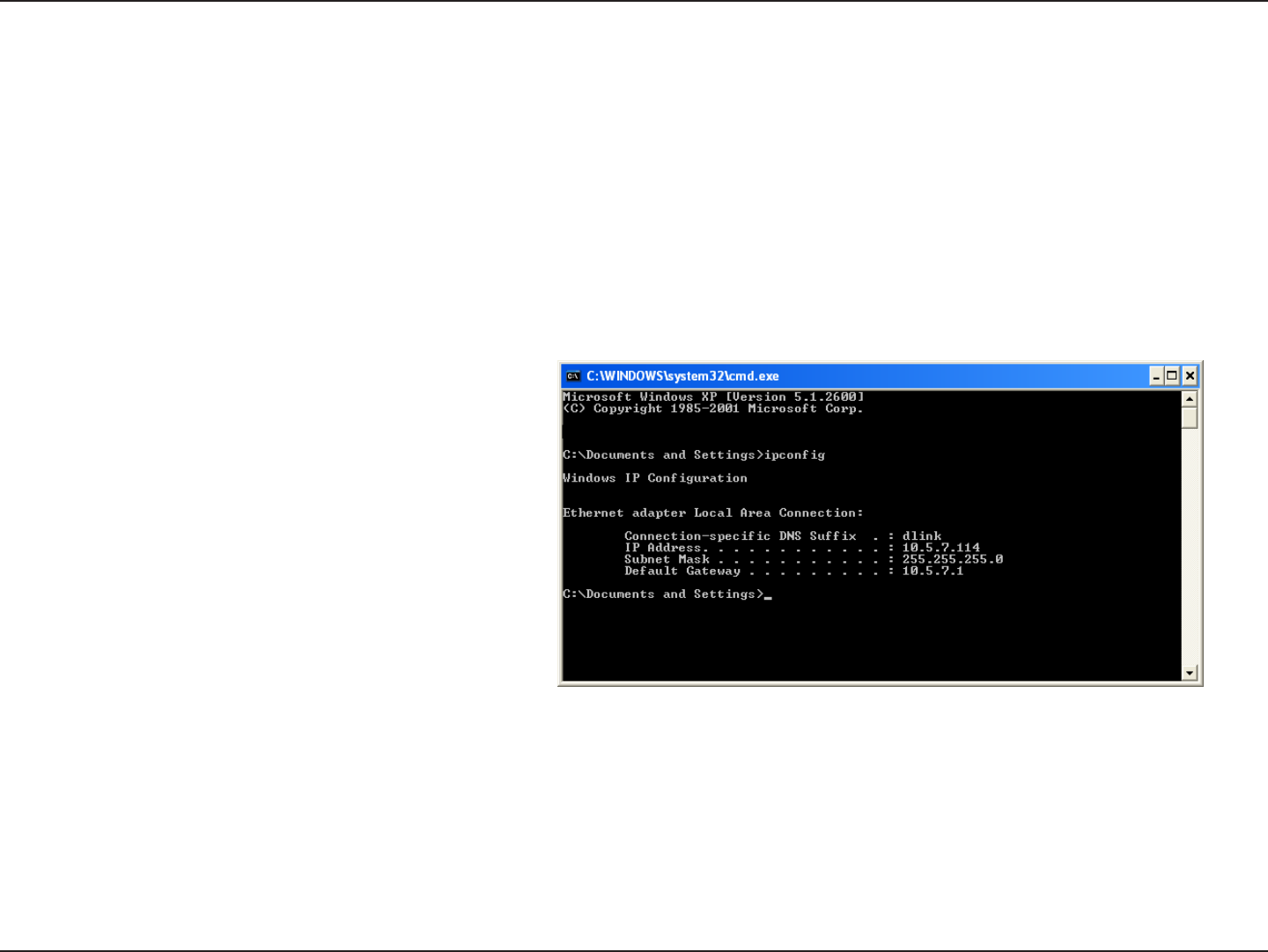
99D-Link DIR-615 User Manual
Appendix B - Networking Basics
Networking Basics
Check your IP address
After you install your adapter, by default, the TCP/IP settings should be set to obtain an IP address from a DHCP server (i.e. wireless router) automatically.
To verify your IP address, please follow the steps below.
Click on Start > Run. In the run box type cmd and click OK. (Windows Vista® users type cmd in the Start Search box.)
At the prompt, type ipcong and press Enter.
This will display the IP address, subnet mask, and the default
gateway of your adapter.
If the address is 0.0.0.0, check your adapter installation, security
settings, and the settings on your router. Some rewall software
programs may block a DHCP request on newly installed
adapters.
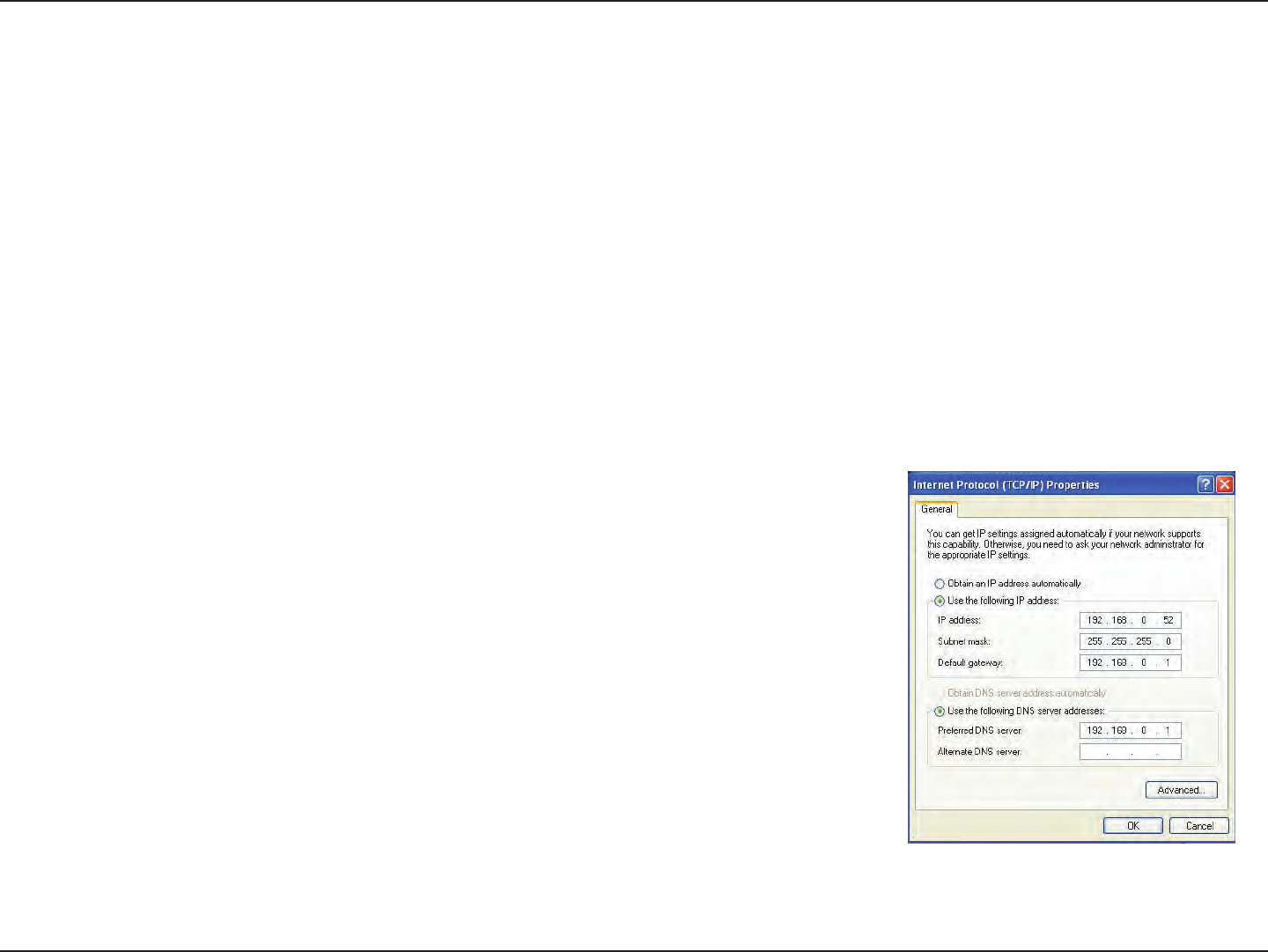
100D-Link DIR-615 User Manual
Appendix B - Networking Basics
Statically Assign an IP address
If you are not using a DHCP capable gateway/router, or you need to assign a static IP address, please follow the steps below:
Step 1
Windows® 7 - Click on Start > Control Panel > Network and Internet > Network and Sharing Center > Change Adapter Setting.
Windows Vista® - Click on Start > Control Panel > Network and Internet > Network and Sharing Center > Manage Network Connections.
Windows® XP - Click on Start > Control Panel > Network Connections.
Windows® 2000 - From the desktop, right-click My Network Places > Properties.
Step 2
Right-click on the Local Area Connection which represents your network adapter and select Properties.
Step 3
Highlight Internet Protocol (TCP/IP) and click Properties.
Step 4
Click Use the following IP address and enter an IP address that is on the same subnet as your network or the LAN IP address on your router.
Example: If the router´s LAN IP address is 192.168.0.1, make your IP address 192.168.0.X where X is a
number between 2 and 99. Make sure that the number you choose is not in use on the network. Set
Default Gateway the same as the LAN IP address of your router (192.168.0.1).
Set Primary DNS the same as the LAN IP address of your router (192.168.0.1). The Secondary DNS is not
needed or you may enter a DNS server from your ISP.
Step 5
Click OK twice to save your settings.

101D-Link DIR-615 User Manual
Appendix C - Technical Specications
Technical Specications
Standards
• IEEE 802.11n
• IEEE 802.11g
• IEEE 802.3
• IEEE 802.3u
Security
• WPA-Personal
• WPA2-Personal
• WPA-Enterprise
• WPA2-Enterprise
Wireless Signal Rates*
• 300Mbps • 12Mbps
• 108Mbps • 11Mbps
• 54Mbps • 9Mbps
• 48Mbps • 6Mbps
• 36Mbps • 5.5Mbps
• 18Mbps • 2Mbps
• 24Mbps • 1Mbps
MSC (0-15)
• 130Mbps (270) • 117Mbps (243)
• 104Mbps (216) • 78Mbps (162)
• 66Mbps (135) • 58.5Mbps (121.5)
• 52Mbps (108) • 39Mbps (81)
• 26Mbps (54) • 19.5Mbps (40.5)
• 12Mbps (27) • 6.5Mbps (13.5)
Frequency Range
• 2.4GHz to 2.483GHz
Transmitter Output Power
• 23.6dBm
LEDs
• Power • Internet
• WLAN • LAN (10/100)
Operating Temperature
• 32°F to 104°F ( 0°C to 40°C)
Humidity
• 95% maximum (non-condensing)
Safety & Emissions
• FCC
• IC
• CE
Dimensions
• L = 7.8 inches
• W = 5 inches
• H = 1.2 inches
Warranty
• 1 Year Limited
* Maximum wireless signal rate derived from IEEE Standard 802.11g and 802.11n specications. Actual data throughput will vary. Network conditions and environmental factors,
including volume of network trac, building materials and construction, and network overhead, lower actual data throughput rate. Environmental factors will adversely aect
wireless signal range.

102D-Link DIR-615 User Manual
Appendix D - Contacting Technical Support
Contacting Technical Support
U.S. and Canadian customers can contact D-Link technical support through our web site or by phone.
Before you contact technical support, please have the following ready:
• Model number of the product (e.g. DIR-615)
• Hardware Revision (located on the label on the bottom of the router (e.g. rev I1))
• Serial Number (s/n number located on the label on the bottom of the router).
You can nd software updates and user documentation on the D-Link website as well as frequently asked questions and answers to technical issues.
For customers within the United States:
Phone Support:
(877) 453-5465
Internet Support:
http://support.dlink.com
For customers within Canada:
Phone Support:
(800) 361-5265
Internet Support:
http://support.dlink.ca

103D-Link DIR-615 User Manual
Appendix E - GPL Code Statement
GPL Code Statement
This D-Link product includes software code developed by third parties, including software code subject to the GNU General Public License (“GPL”)
or GNU Lesser General Public License (“LGPL”). As applicable, the terms of the GPL and LGPL, and information on obtaining access to the GPL
code and LGPL code used in this product, are available to you at:
http://tsd.dlink.com.tw/GPL.asp
The GPL code and LGPL code used in this product is distributed WITHOUT ANY WARRANTY and is subject to the copyrights of one or more
authors. For details, see the GPL code and the LGPL code for this product and the terms of the GPL and LGPL.
WRITTEN OFFER FOR GPL AND LGPL SOURCE CODE
Where such specic license terms entitle you to the source code of such software, D-Link will provide upon written request via email and/or
traditional paper mail the applicable GPL and LGPLsource code files via CD-ROM for a nominal cost to cover shipping and media charges as
allowed under the GPL and LGPL.
Please direct all inquiries to:
Email: GPLCODE@DLink.com
Snail Mail:
Attn: GPLSOURCE REQUEST
D-Link Systems, Inc.
17595 Mt. Herrmann Street
Fountain Valley, CA 92708
GNU GENERAL PUBLIC LICENSE
Version 3, 29 June 2007
Copyright (C) 2007 Free Software Foundation, Inc. <http://fsf.org/> Everyone is permitted to copy and distribute verbatim copies of this license
document, but changing it is not allowed.

104D-Link DIR-615 User Manual
Appendix E - GPL Code Statement
Preamble
The GNU General Public License is a free, copyleft license for software and other kinds of works.
The licenses for most software and other practical works are designed to take away your freedom to share and change the works. By contrast, the
GNU General Public License is intended to guarantee your freedom to share and change all versions of a program--to make sure it remains free
software for all its users. We, the Free Software Foundation, use the GNU General Public License for most of our software; it applies also to any other
work released this way by its authors. You can apply it to your programs, too.
When we speak of free software, we are referring to freedom, not price. Our General Public Licenses are designed to make sure that you have the
freedom to distribute copies of free software (and charge for them if you wish), that you receive source code or can get it if you want it, that you
can change the software or use pieces of it in new free programs, and that you know you can do these things.
To protect your rights, we need to prevent others from denying you these rights or asking you to surrender the rights. Therefore, you have
certain responsibilities if you distribute copies of the software, or if you modify it: responsibilities to respect the freedom of others.
For example, if you distribute copies of such a program, whether gratis or for a fee, you must pass on to the recipients the same freedoms that you
received. You must make sure that they, too, receive or can get the source code. And you must show them these terms so they know their rights.
Developers that use the GNU GPL protect your rights with two steps:
(1) assert copyright on the software, and (2) oer you this License giving you legal permission to copy, distribute and/or modify it.
For the developers’ and authors’ protection, the GPL clearly explains that there is no warranty for this free software. For both users’ and
authors’ sake, the GPL requires that modied versions be marked as changed, so that their problems will not be attributed erroneously to authors
of previous versions.
Some devices are designed to deny users access to install or run modied versions of the software inside them, although the manufacturer can
do so. This is fundamentally incompatible with the aim of protecting users’ freedom to change the software. The systematic pattern of such abuse
occurs in the area of products for individuals to use, which is precisely where it is most unacceptable. Therefore, we have designed this version of
the GPL to prohibit the practice for those products. If such problems arise substantially in other domains, we stand ready to extend this provision
to those domains in future versions of the GPL, as needed to protect the freedom of users.
Finally, every program is threatened constantly by software patents. States should not allow patents to restrict development and use of software
on general-purpose computers, but in those that do, we wish to avoid the special danger that patents applied to a free program could make it
eectively proprietary. To prevent this, the GPL assures that patents cannot be used to render the program non-free.
The precise terms and conditions for copying, distribution and modication follow.

105D-Link DIR-615 User Manual
Appendix F - Warranty
Warranty
Subject to the terms and conditions set forth herein, D-Link Systems, Inc. (“D-Link”) provides this Limited Warranty:
• Only to the person or entity that originally purchased the product from D-Link or its authorized reseller or distributor, and
• Only for products purchased and delivered within the fty states of the United States, the District of Columbia, U.S. Possessions
or Protectorates, U.S. Military Installations, or addresses with an APO or FPO.
Limited Warranty:
D-Link warrants that the hardware portion of the D-Link product described below (“Hardware”) will be free from material defects in workmanship
and materials under normal use from the date of original retail purchase of the product, for the period set forth below (“Warranty Period”), except
as otherwise stated herein.
• Hardware (excluding power supplies and fans): One (1) year limited
• Power supplies and fans: One (1) year limited
• Spare parts and spare kits: Ninety (90) days
The customer’s sole and exclusive remedy and the entire liability of D-Link and its suppliers under this Limited Warranty will be, at
D-Link’s option, to repair or replace the defective Hardware during the Warranty Period at no charge to the original owner or to refund the actual
purchase price paid. Any repair or replacement will be rendered by D-Link at an Authorized D-Link Service Oce. The replacement hardware
need not be new or have an identical make, model or part. D-Link may, at its option, replace the defective Hardware or any part thereof with any
reconditioned product that D-Link reasonably determines is substantially equivalent (or superior) in all material respects to the defective Hardware.
Repaired or replacement hardware will be warranted for the remainder of the original Warranty Period or ninety (90) days, whichever is longer,
and is subject to the same limitations and exclusions. If a material defect is incapable of correction, or if D-Link determines that it is not practical
to repair or replace the defective Hardware, the actual price paid by the original purchaser for the defective Hardware will be refunded by D-Link
upon return to D-Link of the defective Hardware. All Hardware or part thereof that is replaced by D-Link, or for which the purchase price is refunded,
shall become the property of D-Link upon replacement or refund.

106D-Link DIR-615 User Manual
Appendix F - Warranty
Limited Software Warranty:
D-Link warrants that the software portion of the product (“Software”) will substantially conform to D-Link’s then current functional specications
for the Software, as set forth in the applicable documentation, from the date of original retail purchase of the Software for a period of ninety (90)
days (“Software Warranty Period”), provided that the Software is properly installed on approved hardware and operated as contemplated in its
documentation. D-Link further warrants that, during the Software Warranty Period, the magnetic media on which D-Link delivers the Software will be
free of physical defects. The customer’s sole and exclusive remedy and the entire liability of D-Link and its suppliers under this Limited Warranty will
be, at D-Link’s option, to replace the non-conforming Software (or defective media) with software that substantially conforms to D-Link’s functional
specications for the Software or to refund the portion of the actual purchase price paid that is attributable to the Software. Except as otherwise
agreed by D-Link in writing, the replacement Software is provided only to the original licensee, and is subject to the terms and conditions of the
license granted by D-Link for the Software. Replacement Software will be warranted for the remainder of the original Warranty Period and is subject
to the same limitations and exclusions. If a material non-conformance is incapable of correction, or if D-Link determines in its sole discretion that it
is not practical to replace the non-conforming Software, the price paid by the original licensee for the non-conforming Software will be refunded by
D-Link; provided that the non-conforming Software (and all copies thereof) is rst returned to D-Link. The license granted respecting any Software
for which a refund is given automatically terminates.
Non-Applicability of Warranty:
The Limited Warranty provided hereunder for Hardware and Software portions of D-Link’s products will not be applied to and does not cover any
refurbished product and any product purchased through the inventory clearance or liquidation sale or other sales in which D-Link, the sellers, or
the liquidators expressly disclaim their warranty obligation pertaining to the product and in that case, the product is being sold “As-Is” without any
warranty whatsoever including, without limitation, the Limited Warranty as described herein, notwithstanding anything stated herein to the contrary.
Submitting A Claim:
The customer shall return the product to the original purchase point based on its return policy. In case the return policy period has expired and
the product is within warranty, the customer shall submit a claim to D-Link as outlined below:
• The customer must submit with the product as part of the claim a written description of the Hardware defect or Software
nonconformance in sucient detail to allow D-Link to conrm the same, along with proof of purchase of the product (such as a
copy of the dated purchase invoice for the product) if the product is not registered.
• The customer must obtain a Case ID Number from D-Link Technical Support at 1-877-453-5465, who will attempt to assist the
customer in resolving any suspected defects with the product. If the product is considered defective, the customer must obtain a
Return Material Authorization (“RMA”) number by completing the RMA form and entering the assigned Case ID Number at https://
rma.dlink.com/.

107D-Link DIR-615 User Manual
Appendix F - Warranty
• After an RMA number is issued, the defective product must be packaged securely in the original or other suitable shipping package
to ensure that it will not be damaged in transit, and the RMA number must be prominently marked on the outside of the package.
Do not include any manuals or accessories in the shipping package. D-Link will only replace the defective portion of the product
and will not ship back any accessories.
• The customer is responsible for all in-bound shipping charges to D-Link. No Cash on Delivery (“COD”) is allowed. Products sent COD
will either be rejected by D-Link or become the property of D-Link. Products shall be fully insured by the customer and shipped
to D-Link Systems, Inc., 17595 Mt. Herrmann, Fountain Valley, CA 92708. D-Link will not be held responsible for any packages that
are lost in transit to D-Link. The repaired or replaced packages will be shipped to the customer via UPS Ground or any common
carrier selected by D-Link. Return shipping charges shall be prepaid by D-Link if you use an address in the United States, otherwise
we will ship the product to you freight collect. Expedited shipping is available upon request and provided shipping charges are
prepaid by the customer. D-Link may reject or return any product that is not packaged and shipped in strict compliance with the
foregoing requirements, or for which an RMA number is not visible from the outside of the package. The product owner agrees to
pay D-Link’s reasonable handling and return shipping charges for any product that is not packaged and shipped in accordance
with the foregoing requirements, or that is determined by D-Link not to be defective or non-conforming.
What Is Not Covered:
The Limited Warranty provided herein by D-Link does not cover:
Products that, in D-Link’s judgment, have been subjected to abuse, accident, alteration, modication, tampering, negligence, misuse, faulty installation,
lack of reasonable care, repair or service in any way that is not contemplated in the documentation for the product, or if the model or serial number
has been altered, tampered with, defaced or removed; Initial installation, installation and removal of the product for repair, and shipping costs;
Operational adjustments covered in the operating manual for the product, and normal maintenance; Damage that occurs in shipment, due to act
of God, failures due to power surge, and cosmetic damage; Any hardware, software, rmware or other products or services provided by anyone
other than D-Link; and Products that have been purchased from inventory clearance or liquidation sales or other sales in which D-Link, the sellers,
or the liquidators expressly disclaim their warranty obligation pertaining to the product.
While necessary maintenance or repairs on your Product can be performed by any company, we recommend that you use only an Authorized D-Link
Service Oce. Improper or incorrectly performed maintenance or repair voids this Limited Warranty.
Disclaimer of Other Warranties:
EXCEPT FOR THE LIMITED WARRANTY SPECIFIED HEREIN, THE PRODUCT IS PROVIDED “AS-IS” WITHOUT ANY WARRANTY OF ANY KIND WHATSOEVER
INCLUDING, WITHOUT LIMITATION, ANY WARRANTY OF MERCHANTABILITY, FITNESS FOR A PARTICULAR PURPOSE AND NONINFRINGEMENT.
IF ANY IMPLIED WARRANTY CANNOT BE DISCLAIMED IN ANY TERRITORY WHERE A PRODUCT IS SOLD, THE DURATION OF SUCH IMPLIED WARRANTY
SHALL BE LIMITED TO THE DURATION OF THE APPLICABLE WARRANTY PERIOD SET FORTH ABOVE. EXCEPT AS EXPRESSLY COVERED UNDER THE
LIMITED WARRANTY PROVIDED HEREIN, THE ENTIRE RISK AS TO THE QUALITY, SELECTION AND PERFORMANCE OF THE PRODUCT IS WITH THE
PURCHASER OF THE PRODUCT.

108D-Link DIR-615 User Manual
Appendix F - Warranty
Limitation of Liability:
TO THE MAXIMUM EXTENT PERMITTED BY LAW, D-LINK IS NOT LIABLE UNDER ANY CONTRACT, NEGLIGENCE, STRICT LIABILITY OR OTHER LEGAL
OR EQUITABLE THEORY FOR ANY LOSS OF USE OF THE PRODUCT, INCONVENIENCE OR DAMAGES OF ANY CHARACTER, WHETHER DIRECT, SPECIAL,
INCIDENTAL OR CONSEQUENTIAL (INCLUDING, BUT NOT LIMITED TO, DAMAGES FOR LOSS OF GOODWILL, LOSS OF REVENUE OR PROFIT, WORK
STOPPAGE, COMPUTER FAILURE OR MALFUNCTION, FAILURE OF OTHER EQUIPMENT OR COMPUTER PROGRAMS TO WHICH D-LINK’S PRODUCT
IS CONNECTED WITH, LOSS OF INFORMATION OR DATA CONTAINED IN, STORED ON, OR INTEGRATED WITH ANY PRODUCT RETURNED TO D-LINK
FOR WARRANTY SERVICE) RESULTING FROM THE USE OF THE PRODUCT, RELATING TO WARRANTY SERVICE, OR ARISING OUT OF ANY BREACH OF
THIS LIMITED WARRANTY, EVEN IF D-LINK HAS BEEN ADVISED OF THE POSSIBILITY OF SUCH DAMAGES. THE SOLE REMEDY FOR A BREACH OF
THE FOREGOING LIMITED WARRANTY IS REPAIR, REPLACEMENT OR REFUND OF THE DEFECTIVE OR NONCONFORMING PRODUCT. THE MAXIMUM
LIABILITY OF D-LINK UNDER THIS WARRANTY IS LIMITED TO THE PURCHASE PRICE OF THE PRODUCT COVERED BY THE WARRANTY. THE FOREGOING
EXPRESS WRITTEN WARRANTIES AND REMEDIES ARE EXCLUSIVE AND ARE IN LIEU OF ANY OTHER WARRANTIES OR REMEDIES, EXPRESS, IMPLIED
OR STATUTORY.
Governing Law:
This Limited Warranty shall be governed by the laws of the State of California. Some states do not allow exclusion or limitation of incidental or
consequential damages, or limitations on how long an implied warranty lasts, so the foregoing limitations and exclusions may not apply. This
Limited Warranty provides specic legal rights and you may also have other rights which vary from state to state.
Trademarks:
D-Link is a registered trademark of D-Link Corporation/D-Link Systems, Inc. Other trademarks or registered trademarks are the property of their
respective owners.
Copyright Statement:
No part of this publication or documentation accompanying this product may be reproduced in any form or by any means or used to make any
derivative such as translation, transformation, or adaptation without permission from D-Link Corporation/D-Link Systems, Inc., as stipulated by the
United States Copyright Act of 1976 and any amendments thereto. Contents are subject to change without prior notice.
Copyright ©2011 by D-Link Corporation/D-Link Systems, Inc. All rights reserved.
CE Mark Warning:
This is a Class B product. In a domestic environment, this product may cause radio interference, in which case the user may be required to take
adequate measures.

109D-Link DIR-615 User Manual
Appendix F - Warranty
This equipment has been tested and found to comply with the limits for a Class B digital device, pursuant to Part 15 of the FCC Rules. These limits
are designed to provide reasonable protection against harmful interference in a residential installation. This equipment generates, uses and can
radiate radio frequency energy and, if not installed and used in accordance with the instructions, may cause harmful interference to radio
communications. However, there is no guarantee that interference will not occur in a particular installation. If this equipment does cause harmful
interference to radio or television reception, which can be determined by turning the equipment o and on, the user is encouraged to try to
correct the interference by one of the following measures:
- Reorient or relocate the receiving antenna.
- Increase the separation between the equipment and receiver.
- Connect the equipment into an outlet on a circuit dierent from that to which the receiver is connected.
- Consult the dealer or an experienced radio/TV technician for help.
FCC Caution: Any changes or modications not expressly approved by the party responsible for compliance could void the user's authority to
operate this equipment.
This device complies with Part 15 of the FCC Rules. Operation is subject to the following two conditions: (1) This device may not cause harmful
interference, and (2) this device must accept any interference received, including interference that may cause undesired operation.
This equipment complies with FCC radiation exposure limits set forth for an uncontrolled environment. This equipment should be installed and
operated with minimum distance 20cm between the radiator & your body.
This transmitter must not be co-located or operating in conjunction with any other antenna or transmitter.
The availability of some specic channels and/or operational frequency bands are country dependent and are rmware programmed at the
factory to match the intended destination. The rmware setting is not accessible by the end user.
Federal Communication Commission Interference Statement
IMPORTANT NOTE:
FCC Radiation Exposure Statement:
NCC:
經型式認證合格之低功率射頻電機,非經許可,公司、商號或使用者均不得擅自變更頻率、加大功率或變更原設計之特性及功能低功率
射頻電機之使用不得影響飛航安全及干擾合法通信;經發現有干擾現象時,應改善至無干擾時方得繼續使用。前項合法通信,指依電信
法規定作業之無線電通信。低功率射頻電機須忍受合法通信或工業、科學及醫療用電波輻射性電機設備之干擾。

110D-Link DIR-615 User Manual
Appendix F - Warranty
Industry Canada statement:
This device complies with RSS-210 of the Industry Canada Rules. Operation is subject to the following two conditions:
(1) This device may not cause harmful interference, and
(2) this device must accept any interference received, including interference that may cause undesired operation.
IMPORTANT NOTE:
Radiation Exposure Statement:
This equipment complies with IC radiation exposure limits set forth for an uncontrolled environment. This equipment should be installed and operated with
minimum distance 20cm between the radiator & your body.
This device has been designed to operate with an antenna having a maximum gain of [2] dB. Antenna having a higher gain is strictly prohibited per regula-
tions of Industry Canada. The required antenna impedance is 50 ohms.
Under Industry Canada regulations, this radio transmitter may only operate using an antenna of a type and maximum (or lesser) gain approved for the trans-
mitter by Industry Canada. To reduce potential radio interference to other users, the antenna type and its gain should be so chosen that the equivalent isotro-
pically radiated power (e.i.r.p.) is not more than that necessary for successful communication.
This radio transmitter (IC: 4216A-IR615I1 / Model: DIR-615I1) has been approved by Industry Canada to operate with the antenna types listed below with the
maximum permissible gain and required antenna impedance for each antenna type indicated. Antenna types not included in this list, having a gain greater
than the maximum gain indicated for that type, are strictly prohibited for use with this device.
Ce dispositif est conforme à la norme CNR-210 d'Industrie Canada applicable aux appareils radio exempts de licence. Son fonctionnement est sujet aux deux
conditions suivantes: (1) le dispositif ne doit pas produire de brouillage préjudiciable, et (2) ce dispositif doit accepter tout brouillage reçu, y compris un
brouillage susceptible de provoquer un fonctionnement indésirable.
NOTE IMPORTANTE:
Déclaration d'exposition aux radiations:
Cet équipement est conforme aux limites d'exposition aux rayonnements IC établies pour un environnement non contrôlé. Cet équipement doit être installé
et utilisé avec un minimum de 20 cm de distance entre la source de rayonnement et votre corps.
Ce dispositif a été conçu pour fonctionner avec une antenne ayant un gain maximal de dB [2]. Une antenne à gain plus élevé est strictement interdite par les
règlements d'Industrie Canada. L'impédance d'antenne requise est de 50 ohms.
Conformément à la réglementation d'Industrie Canada, le présent émetteur radio peutfonctionner avec une antenne d'un type et d'un gain maximal (ou
inférieur) approuvé pourl'émetteur par Industrie Canada. Dans le but de réduire les risques de brouillage radioélectriqueà l'intention des autres utilisateurs, il
faut choisir le type d'antenne et son gain de sorte que lapuissance isotrope rayonnée équivalente (p.i.r.e.) ne dépasse pas l'intensité nécessaire
àl'établissement d'une communication satisfaisante.
Le présent émetteur radio (IC: 4216A-IR615I1 / Model: DIR-615I1) a été approuvé par Industrie Canada pour fonctionner avec les types d'antenne énumérés
ci-dessous et ayant un gain admissible maximal et l'impédance requise pour chaque type d'antenne. Les types d'antenne non inclus dans cette liste, ou dont
le gain est supérieur au gain maximal indiqué, sont strictement interdits pour l'exploitation de l'émetteur.
Antenna information:dipole / 2dBi (Brand:D-Link / Manufacturer : CAMEO)

111D-Link DIR-615 User Manual
Appendix F - Registration
Version 8.0
August 22, 2010
Product registration is entirely voluntary and failure to complete or return this form will not diminish your warranty rights.
Registration